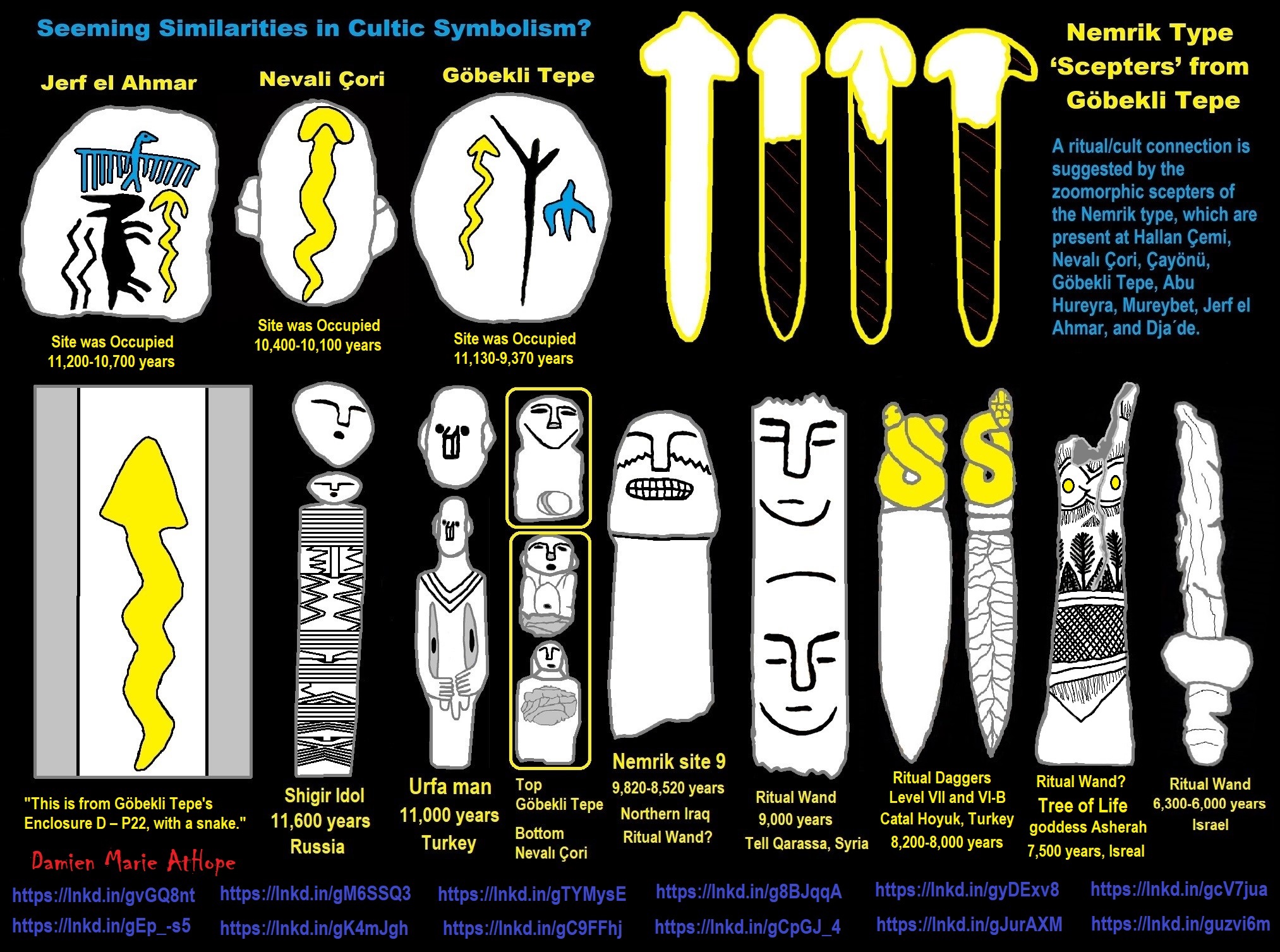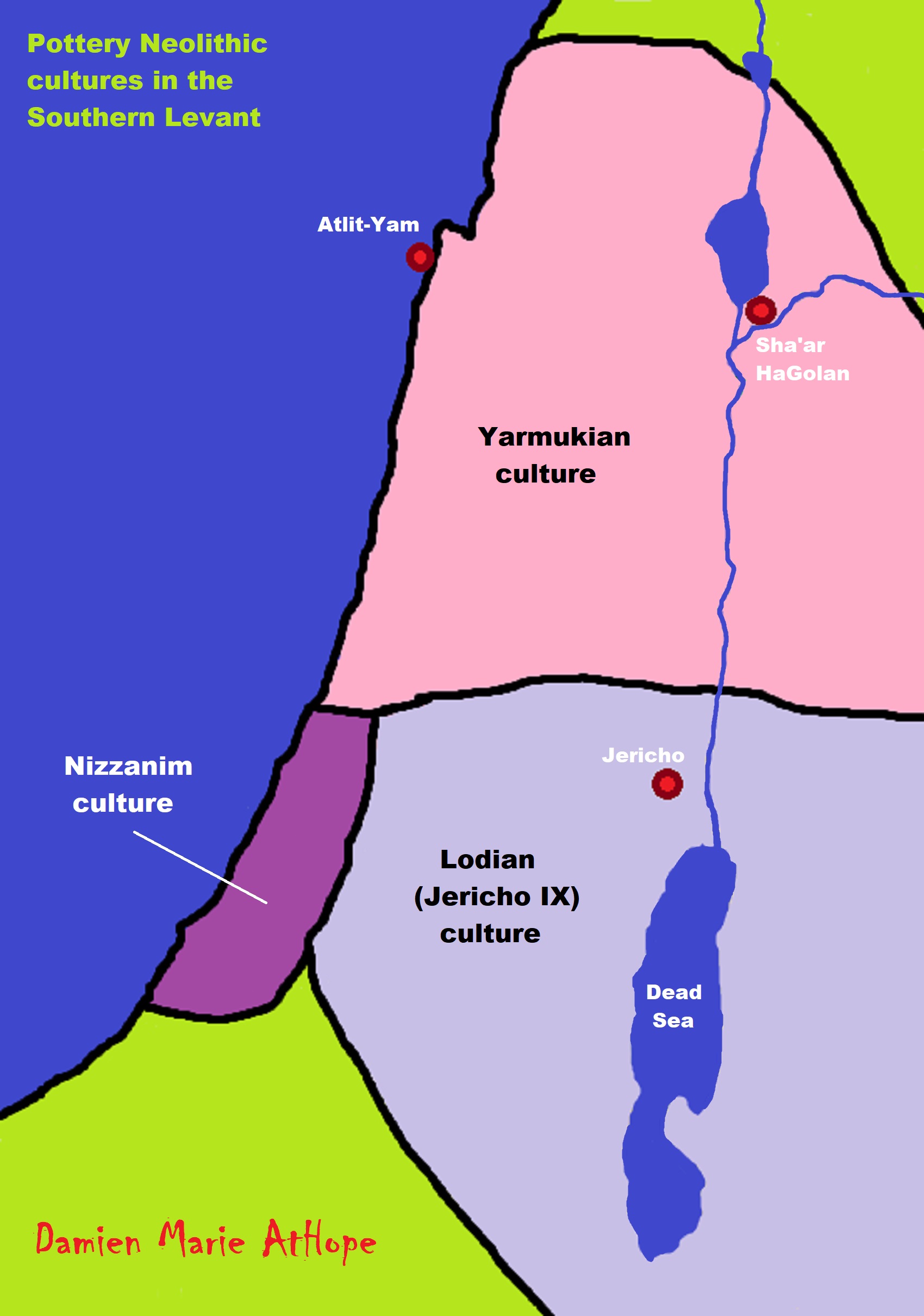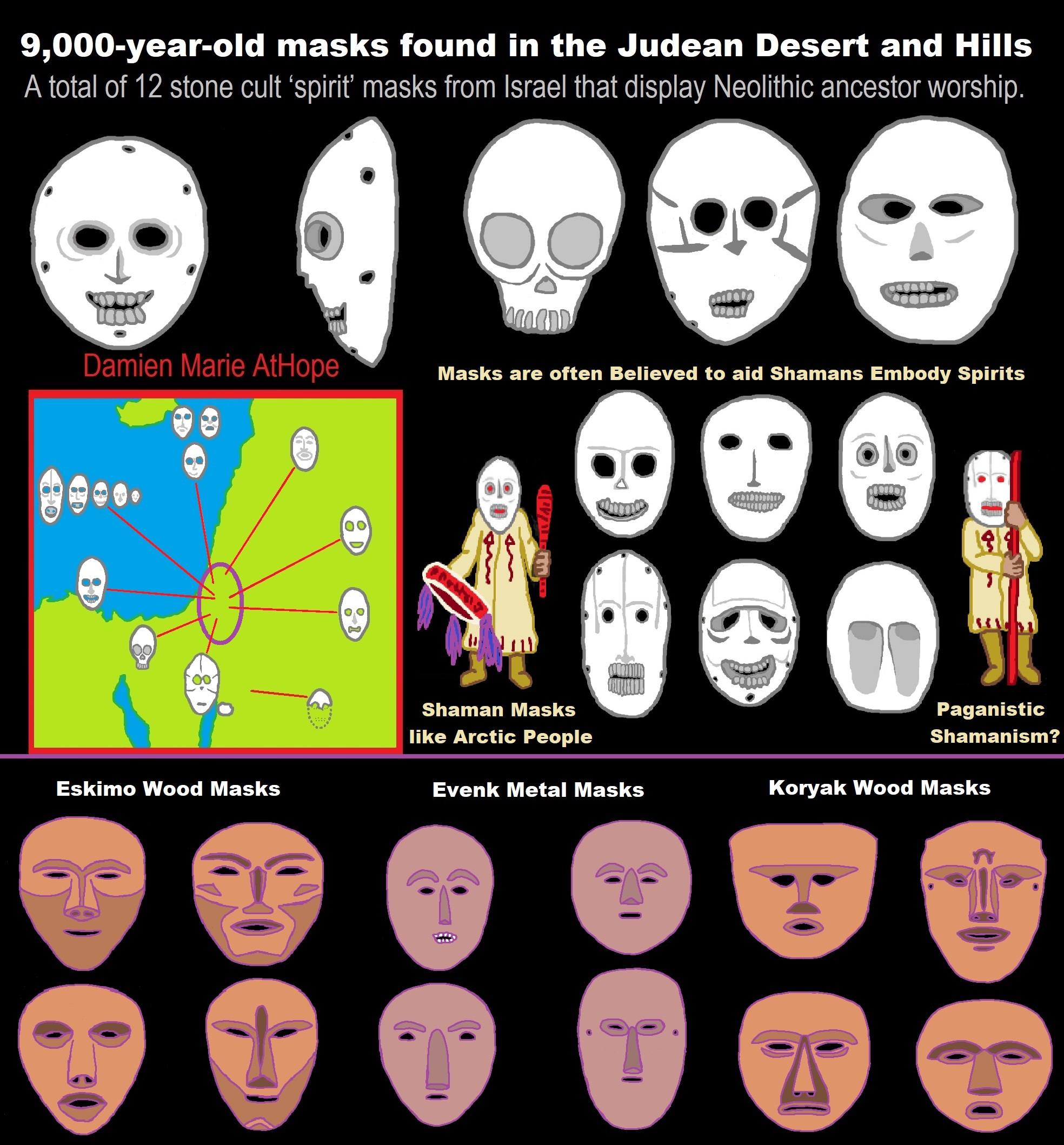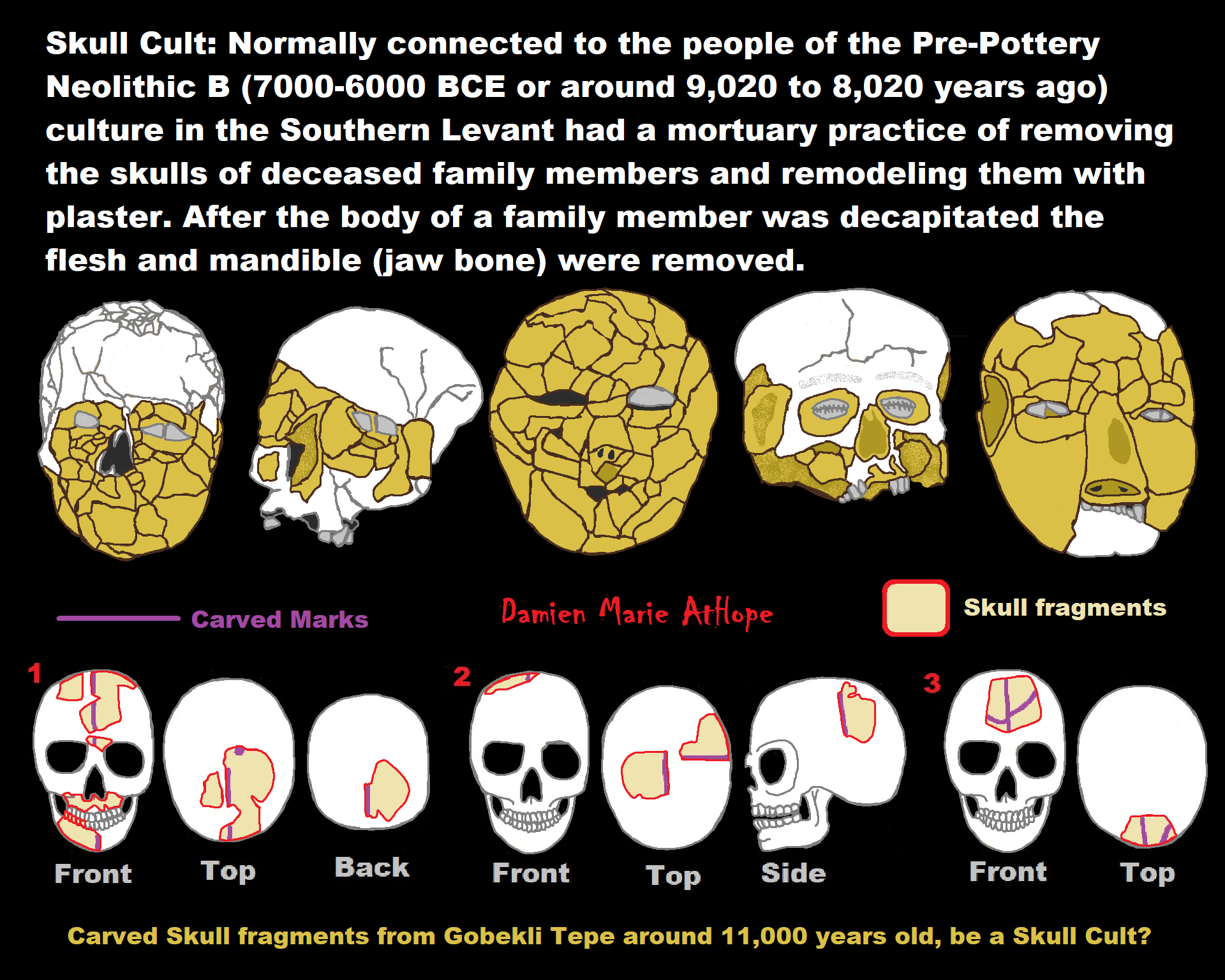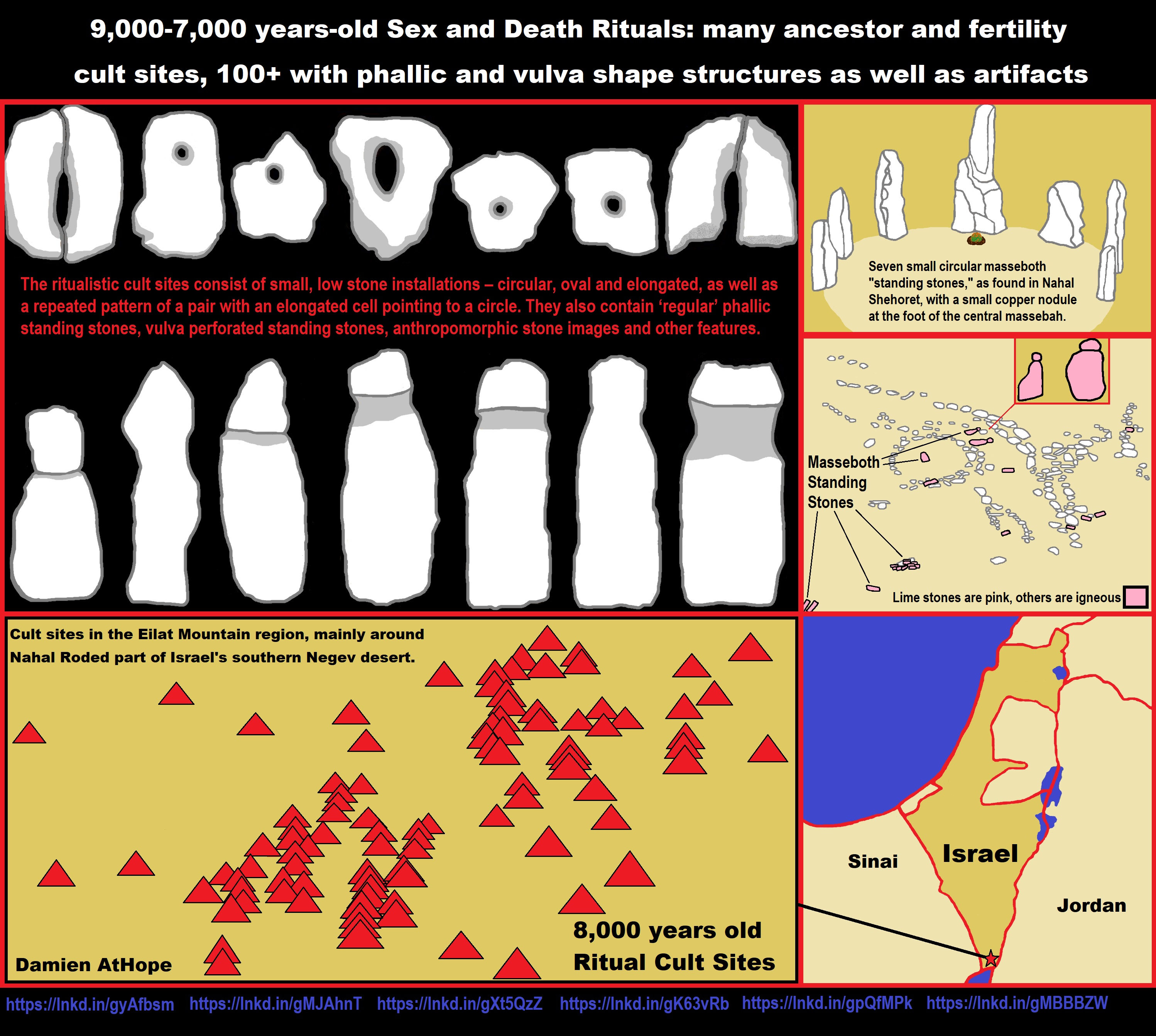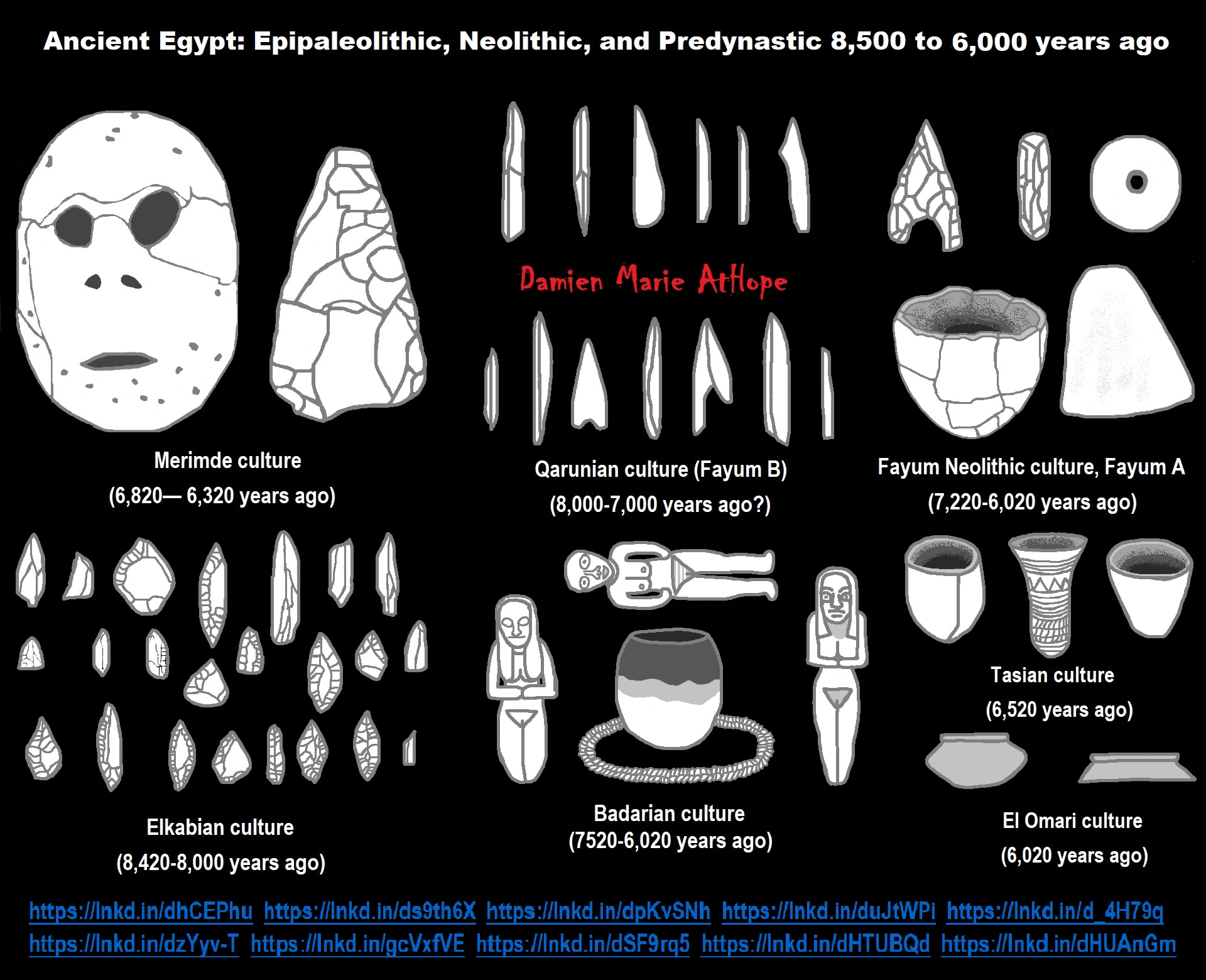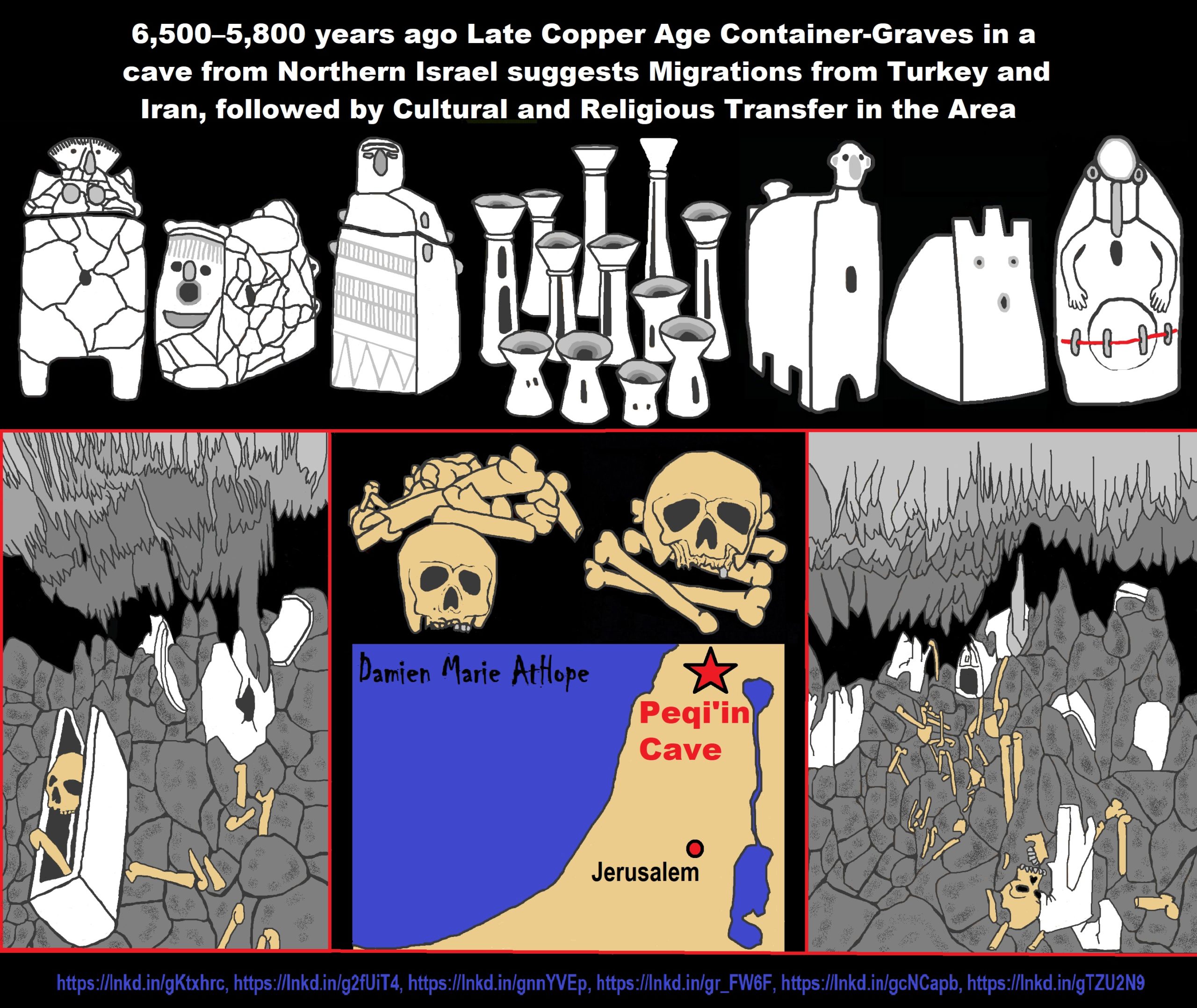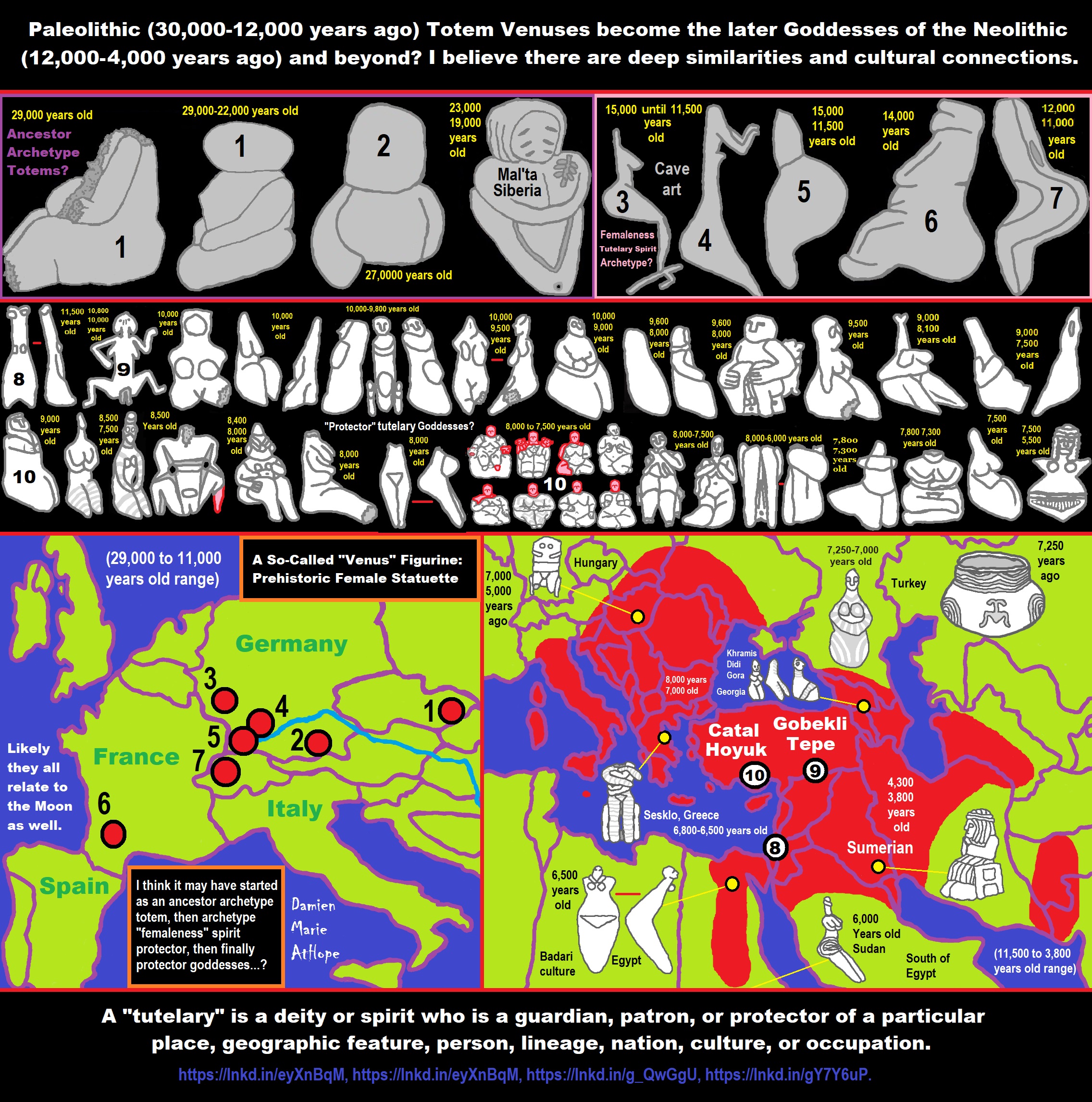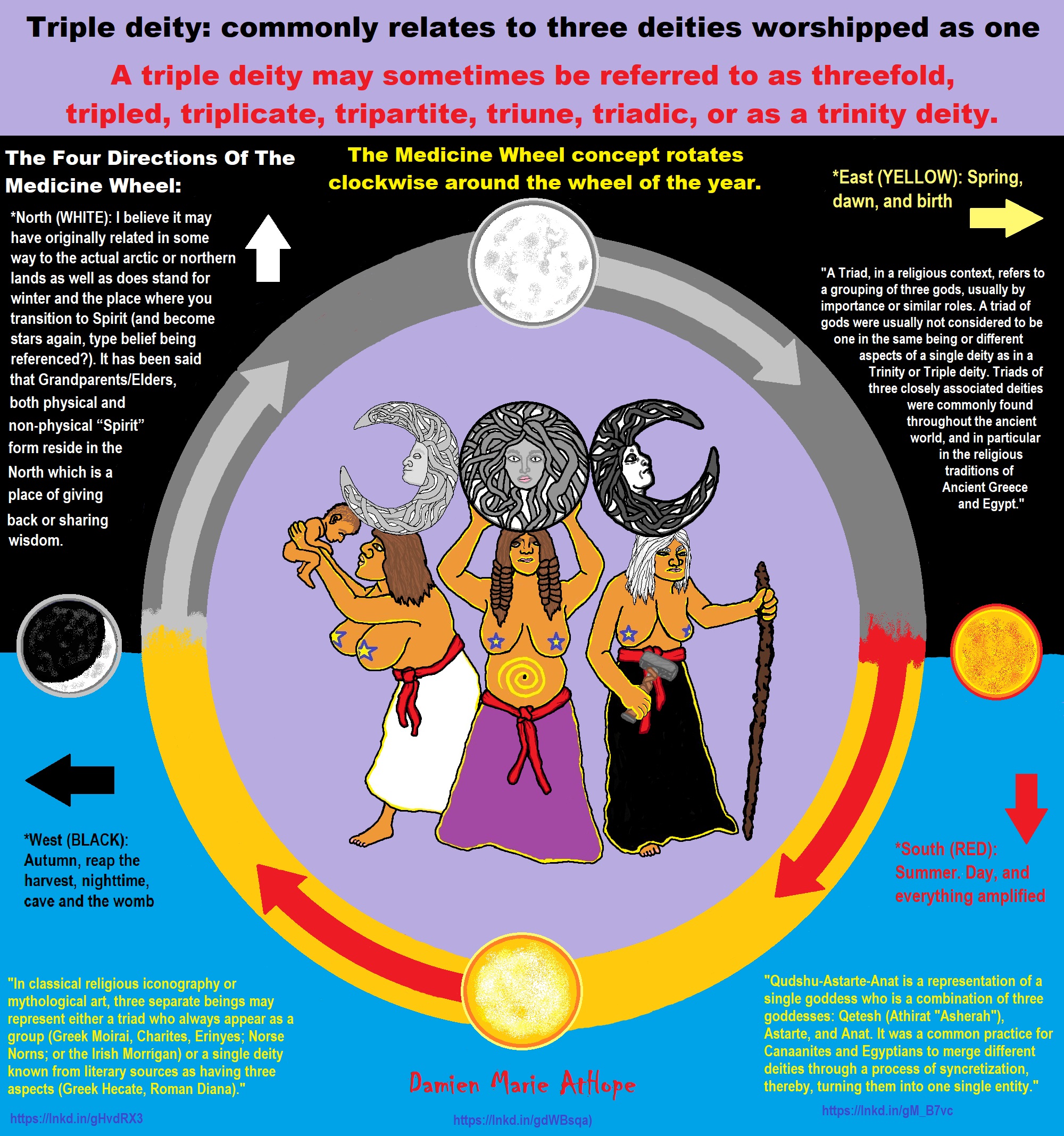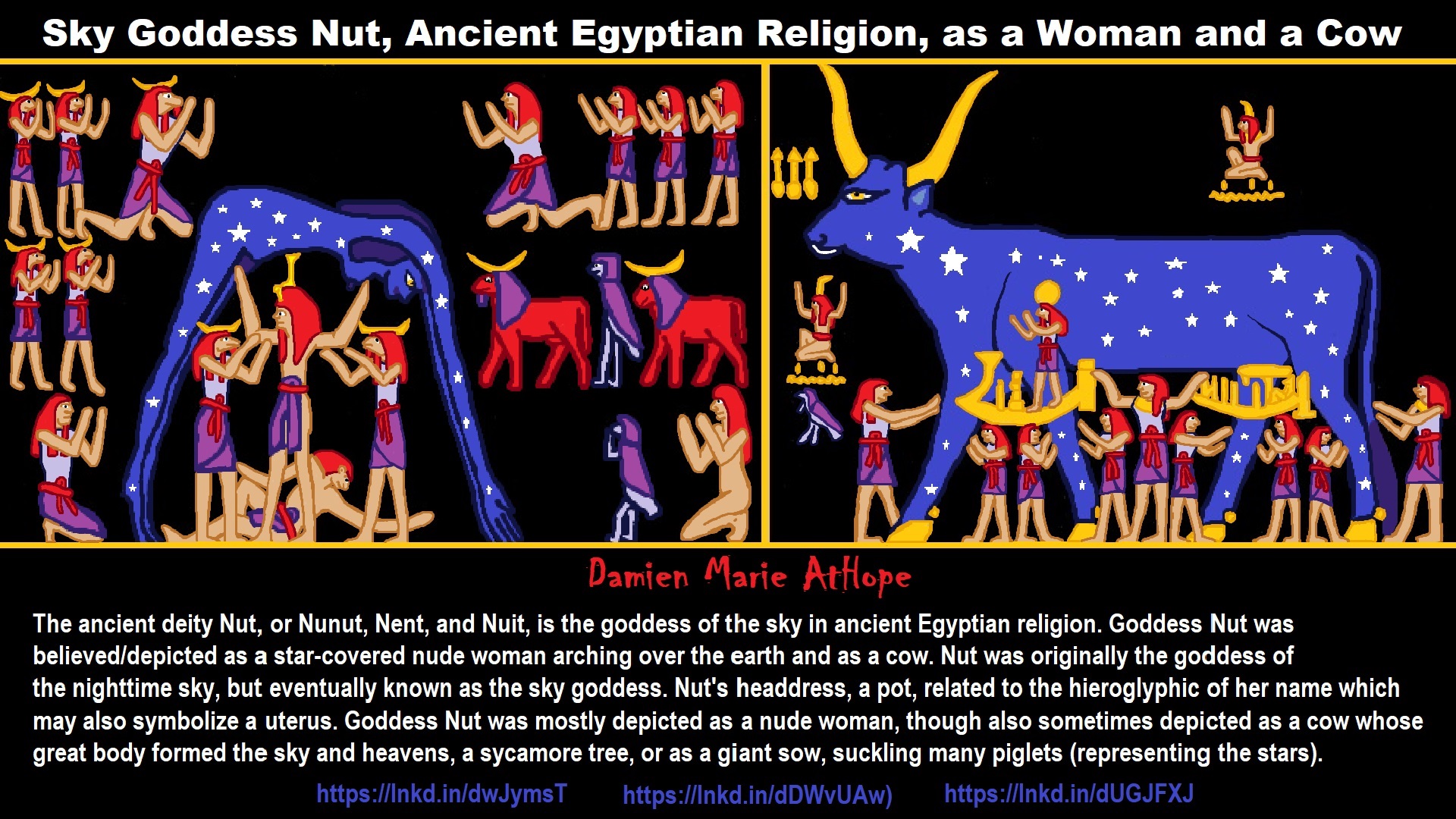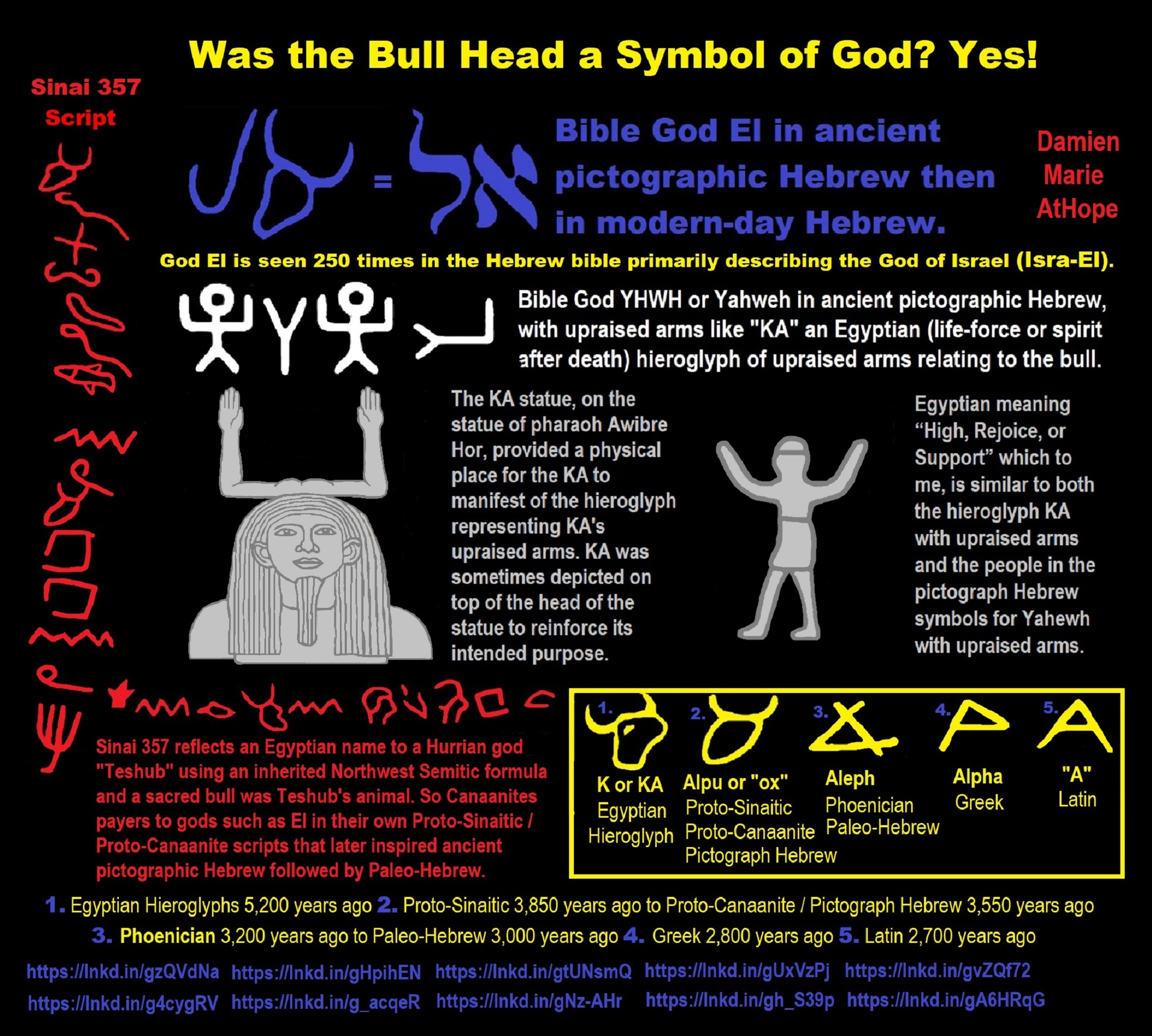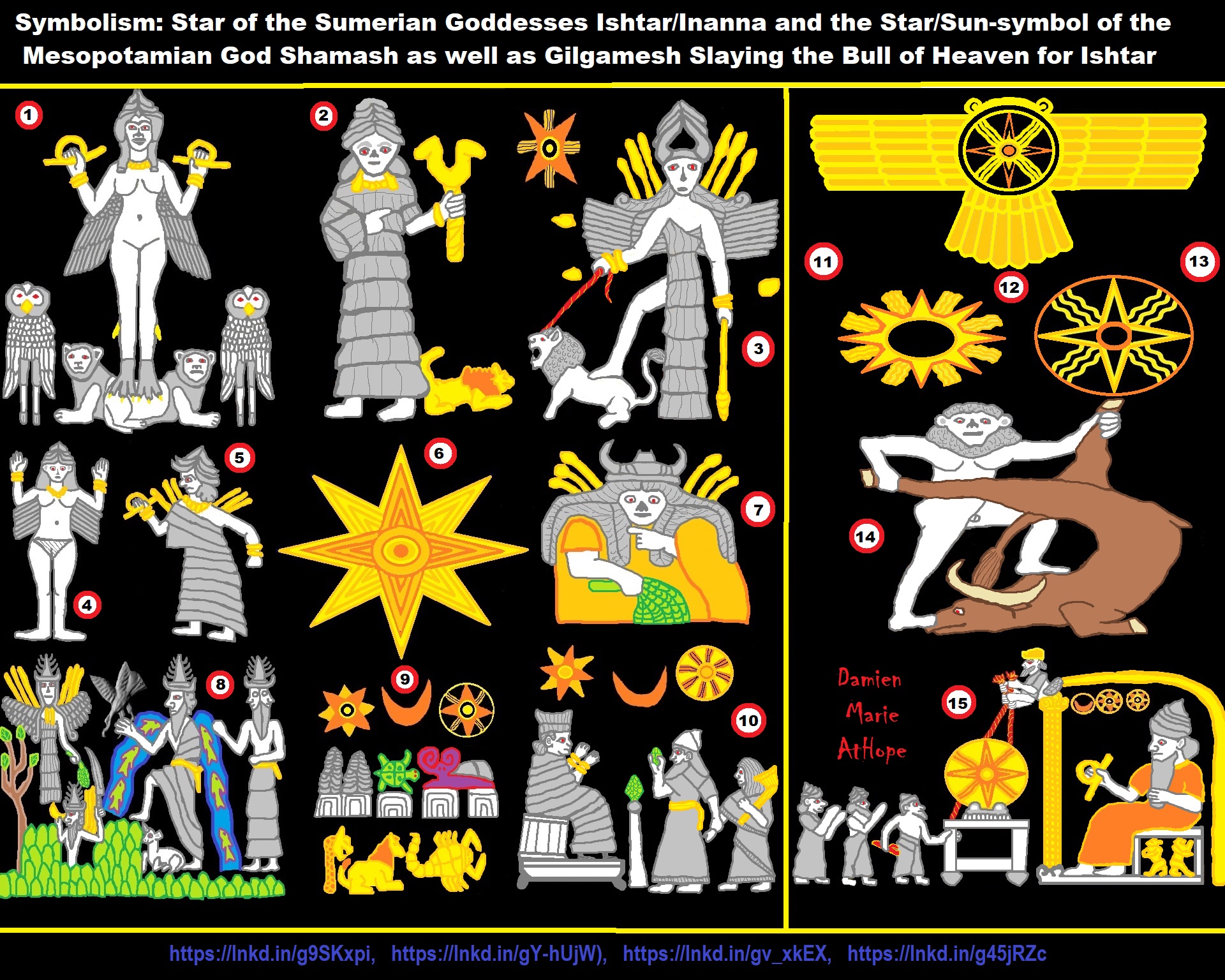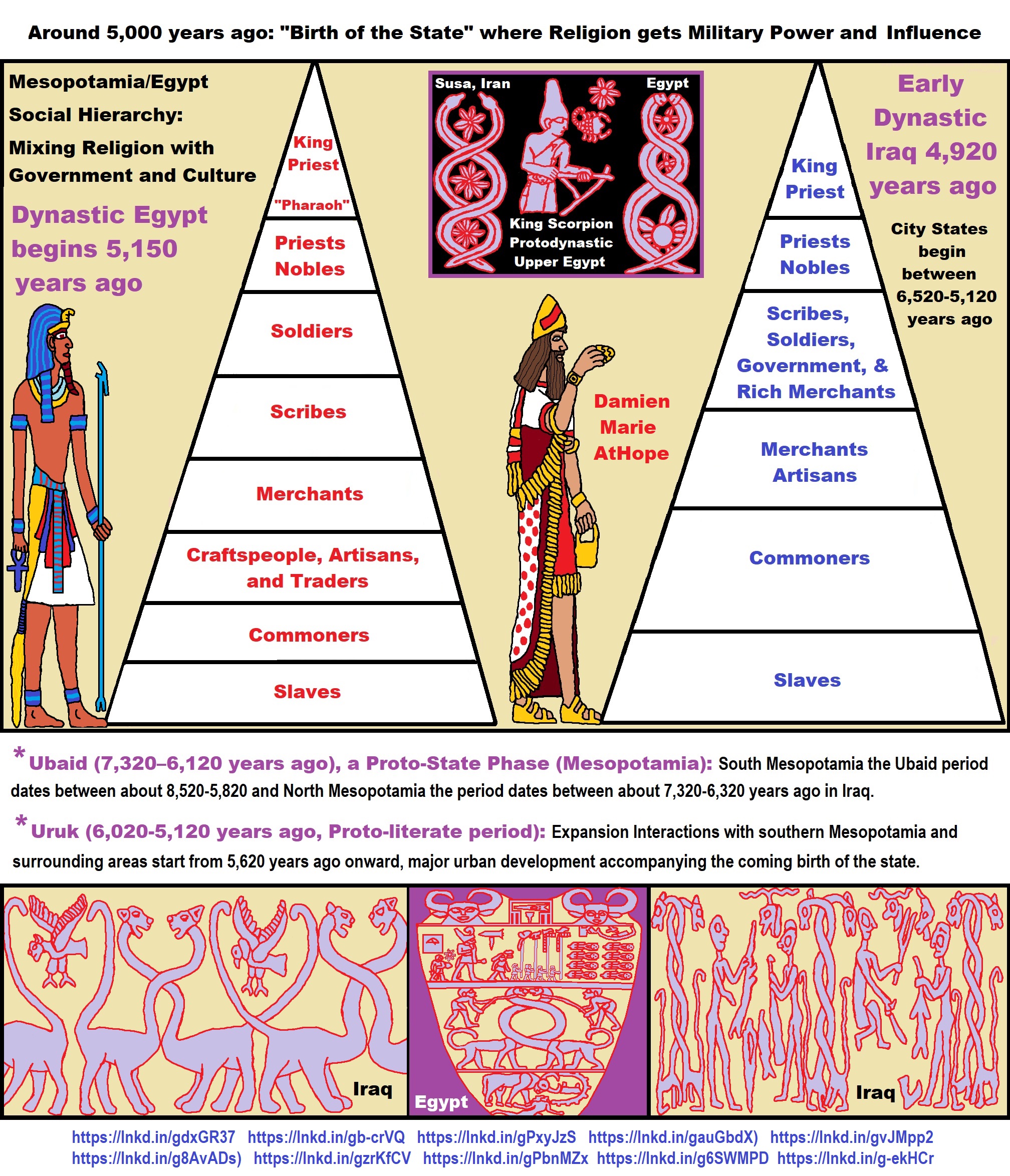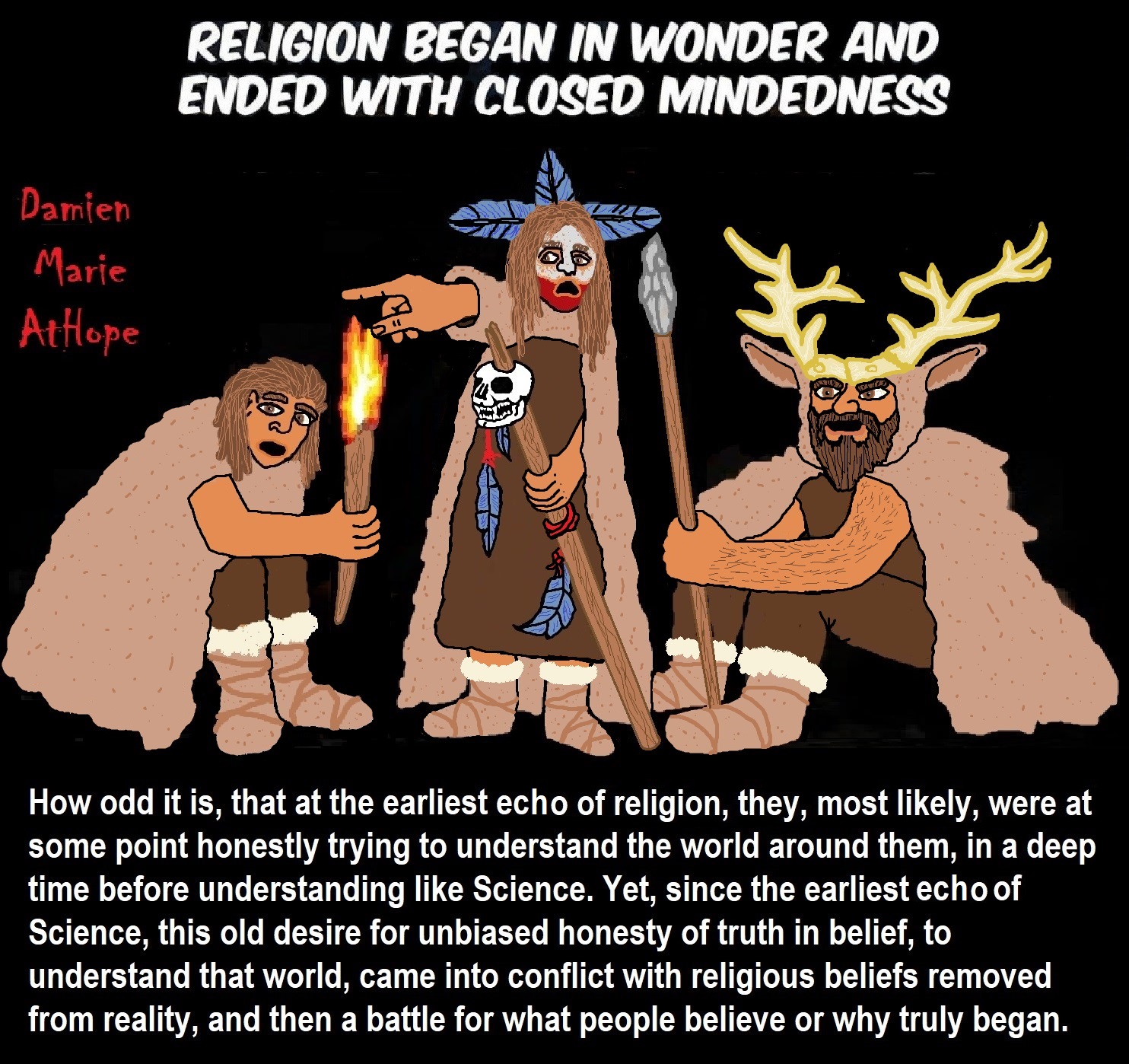The second to the last item on the bottom right, the Ritual wand, tree of life, goddess Asherah and dates to around 7,500 years ago, and the standard images depicting actual trees is not until around 5,000 and below, thus, this may be a start.
Tree of Life Goddess
“According to the Israel Museum, Jerusalem: this 7,500-year-old goddess figurine from Neve Yam is among the world’s earliest evidence for established religion, the origins of which date back to the agricultural revolution, around 10,000 years ago. This figurine of a goddess is decorated with palm fronds or stalks of grain found at Neve Yam, Wadi Rabah culture, Late Neolithic Period. This culture is named after the site where it was first discovered (in the region of Rosh Ha-Ayin), and is common in Israel from the end of the sixth millennium and beginning of the fifth millennium BCE”. 7,500 years ago, an incised bone from the collection of Israel Antiquities Authority and it is similar to contemporaneous figurines, especially the one discovered at Hagosherim, some 100 km away. The striking resemblance between the two objects indicates that the cult of the goddess was widespread by this time. In later periods, the combination of a plant motif (the Tree of Life) with the image of a woman (the goddess) became a common image throughout the Ancient Near East, where it represented the goddess Asherah.” ref, ref
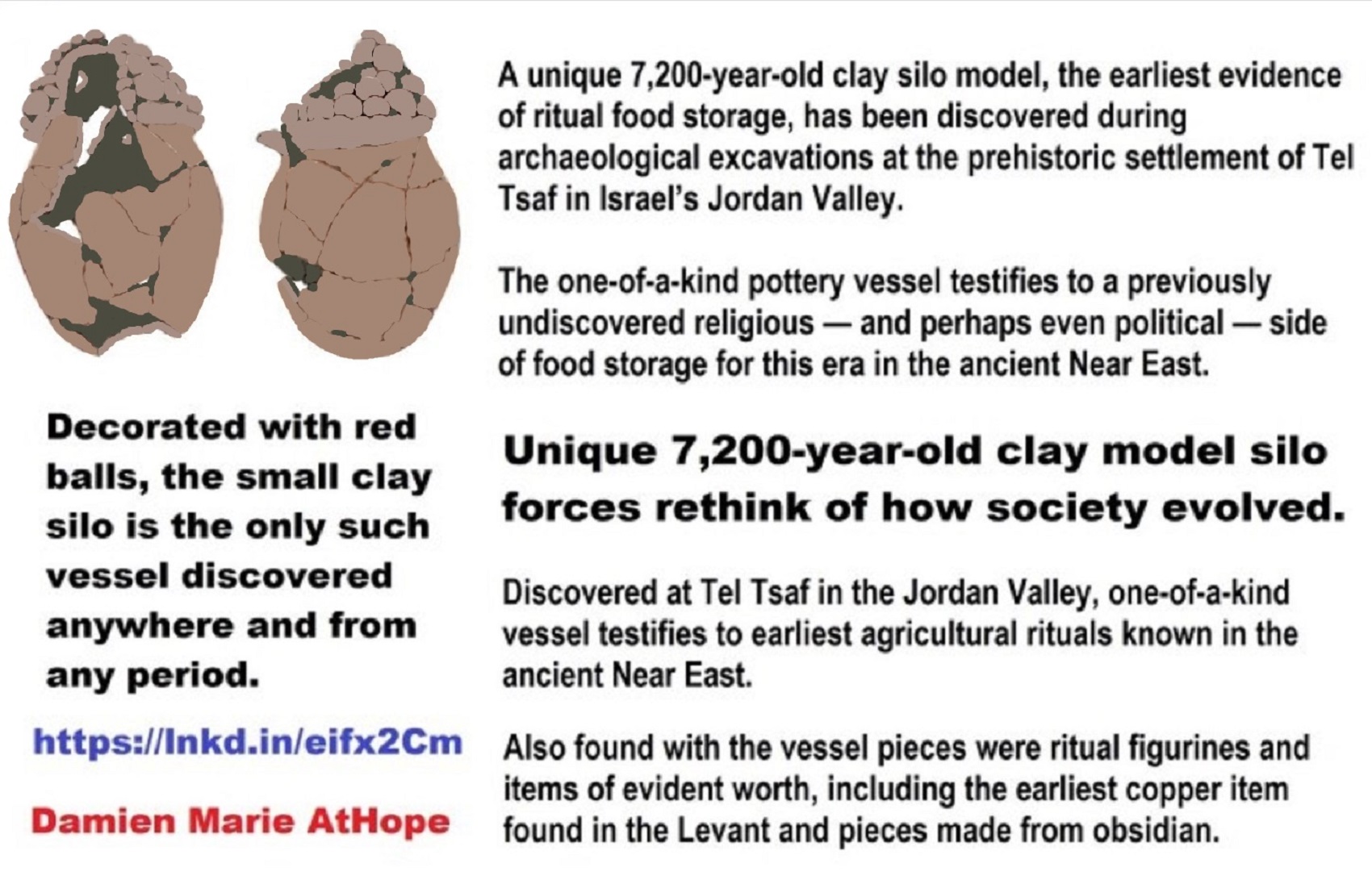
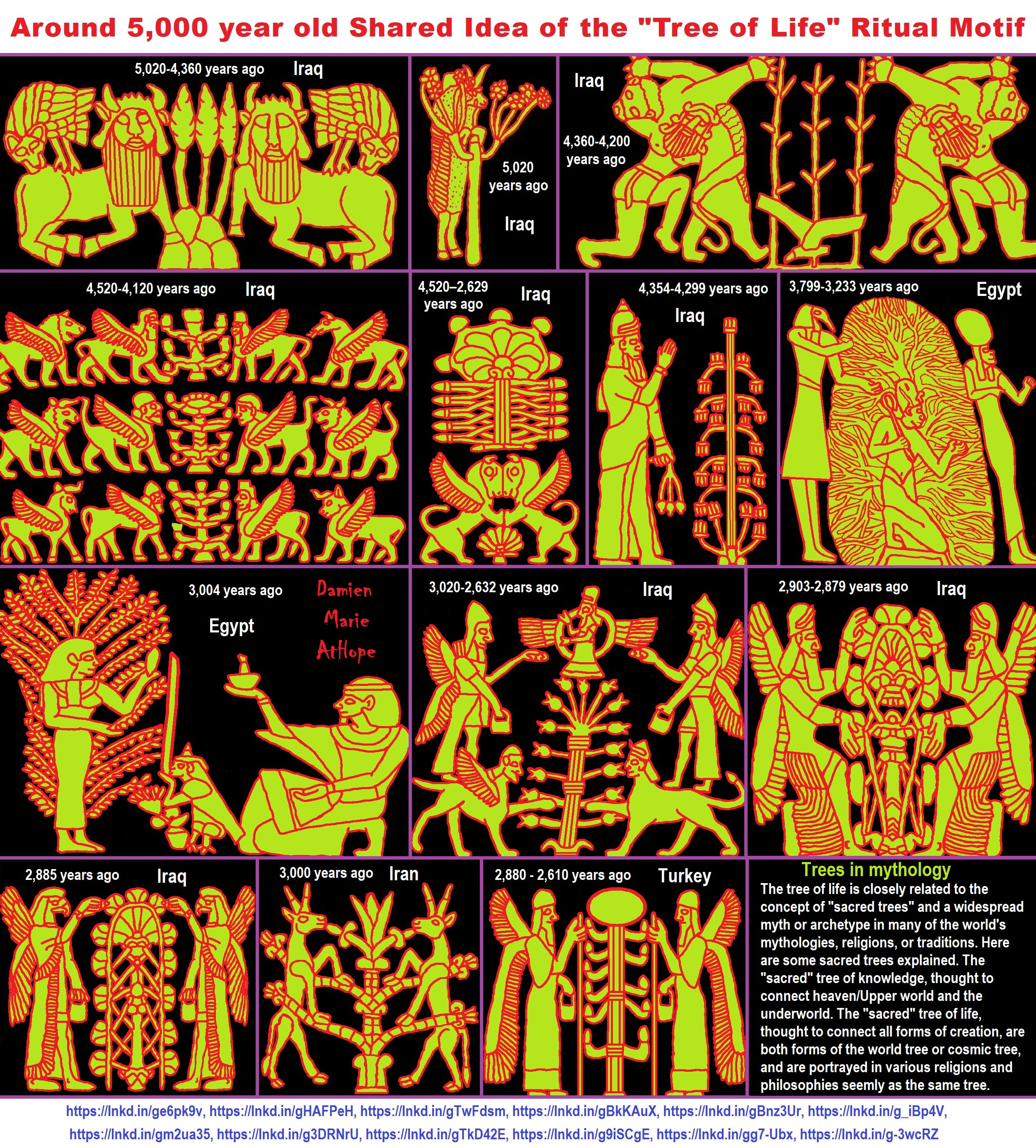
Tree of Life
“The tree of life is a fundamental archetype in many of the world’s mythological, religious, and philosophical traditions. It is closely related to the concept of the sacred tree. The concept of the tree of life may have originated in Central Asia, and was absorbed by other cultures, such Scandinavian mythology, and Altai shamanism. The tree of knowledge, connecting to heaven and the underworld, and the tree of life, connecting all forms of creation, are both forms of the world tree or cosmic tree, and are portrayed in various religions and philosophies as the same tree. Trees promote health and social well-being by removing air pollution, reducing stress, encouraging physical activities, and promoting social ties and community.” ref
“Various trees of life are recounted in folklore, culture and fiction, often relating to immortality or fertility. They had their origin in religious symbolism. According to professor Elvyra Usačiovaitė, a “typical” imagery preserved in ancient iconography is that of two symmetrical figures facing each other, with a tree standing in the middle. The two characters may variously represent rulers, gods, and even a deity and a human follower. The Assyrian tree of life was represented by a series of nodes and criss-crossing lines. It was apparently an important religious symbol, often attended to in Assyrian palace reliefs by human or eagle-headed winged genies, or the King, and blessed or fertilized with bucket and cone. Assyriologists have not reached consensus as to the meaning of this symbol. The name “Tree of Life” has been attributed to it by modern scholarship; it is not used in the Assyrian sources. In fact, no textual evidence pertaining to the symbol is known to exist.” ref
“In ancient Urartu, the tree of life was a religious symbol and was drawn on walls of fortresses and carved on the armor of warriors. The branches of the tree were equally divided on the right and left sides of the stem, with each branch having one leaf, and one leaf on the apex of the tree. Servants stood on each side of the tree with one of their hands up as if they are taking care of the tree. In the Avestan literature and Iranian mythology, there are several sacred vegetal icons related to life, eternality, and cure, like: Amesha Spenta Amordad (guardian of plants, goddess of trees and immortality), Gaokerena (or white Haoma) a tree that its vivacity would certify continuance of life in universe, Bas tokhmak (a tree with remedial attribute, retentive of all herbal seeds, and destroyer of sorrow), Mashyа and Mashyane (parents of the human race in Iranian myths), Barsom (copped offshoots of pomegranate, gaz or Haoma that Zoroastrians use in their rituals), Haoma (a plant, unknown today, that was source of sacred potable), etc.” ref
“Gaokerena is a large, sacred Haoma planted by Ahura Mazda. Ahriman (Ahreman, Angremainyu) created a frog to invade the tree and destroy it, aiming to prevent all trees from growing on the earth. As a reaction, Ahura Mazda created two kar fish staring at the frog to guard the tree. The two fish are always staring at the frog and stay ready to react to it. Because Ahriman is responsible for all evil including death, while Ahura Mazda is responsible for all good (including life). Haoma is another sacred plant due to the drink made from it. The preparation of the drink from the plant by pounding and the drinking of it are central features of Zoroastrian ritual. Haoma also personified as a divinity. It bestows essential vital qualities—health, fertility, husbands for maidens, even immortality.” ref
“The source of the earthly haoma plant is a shining white tree that grows on a paradisiacal mountain. Sprigs of this white haoma were brought to earth by divine birds. The tree is considerably diverse. Haoma is the Avestan form of the Sanskrit soma. The near identity of the two in ritual significance is considered by scholars to point to a salient feature of an Indo-Iranian religion antedating Zoroastrianism. Another related issue in ancient mythology of Iran is the myth of Mashyа and Mashyane, two trees who were the ancestors of all living beings. This myth can be considered as a prototype for the creation myth where living beings are created by Gods (who have a human form).” ref
“In Chinese mythology, a carving of a tree of life depicts a phoenix and a dragon; the dragon often represents immortality. A Taoist story tells of a tree that produces a peach of immortality every three thousand years, and anyone who eats the fruit receives immortality. An archaeological discovery of a sacrificial pit at Sanxingdui in Sichuan, China. Dating from about 1200 BCE, it contained three bronze trees, one of them 4 meters high. At the base was a dragon, and fruit hanging from the lower branches. At the top is a bird-like (Phoenix) creature with claws. Also found in Sichuan, from the late Han dynasty (c 25 – 220 CE), is another tree of life. The ceramic base is guarded by a horned beast with wings. The leaves of the tree represent coins and people. At the apex is a bird with coins and the Sun.” ref
“In Greek mythology, Hera is gifted a branch growing golden apples by her grandmother Gaia, which are then planted in Hera’s Garden of the Hesperides. The dragon Ladon guards the tree(s) from all who would take the apples. The three golden apples that Aphrodite gave to Hippomenes to distract Atalanta three times during their footrace allowed him to win Atalanta’s hand in marriage. Though it is not specified in ancient myth, many assume that Aphrodite gathered those apples from Hera’s tree(s). Eris stole one of these apples and carved the words ΤΗΙ ΚΑΛΛΙΣΤΗΙ, “to the fairest”, upon it to create the Apple of Discord. Heracles retrieve three of the apples as the eleventh of his Twelve Labors. The Garden of the Hesperides is often compared to Eden, the golden apples are compared to the forbidden fruit of the tree in Genesis, and Ladon is often compared to the snake in Eden, all of which is part of why the forbidden fruit of Eden is usually represented as an apple in European art, even though Genesis does not specifically name nor describe any characteristics of the fruit.” ref
“In Dictionnaire Mytho-Hermetique (Paris, 1737), Antoine-Joseph Pernety, a famous alchemist, identified the tree of life with the Elixir of life and the Philosopher’s Stone. In Eden in the East (1998), Stephen Oppenheimer suggests that a tree-worshipping culture arose in Indonesia and was diffused by the so-called “Younger Dryas” event of c. 10,900 BCE or 12,900 BP, after which the sea level rose. This culture reached China (Szechuan), then India, and the Middle East. Finally, the Finno-Ugric strand of this diffusion spread through Russia to Finland where the Norse myth of Yggdrasil took root. The Celtic god Lugus was associated with the Celtic version of the tree of life. The Borjgali (Georgian: ბორჯღალი) is an ancient Georgian tree of life symbol.” ref
“In Germanic paganism, trees played (and, in the form of reconstructive Heathenry and Germanic Neopaganism, continue to play) a prominent role, appearing in various aspects of surviving texts and possibly in the name of gods. The tree of life appears in Norse religion as Yggdrasil, the world tree, a massive tree (sometimes considered a yew or ash tree) with extensive lore surrounding it. Perhaps related to Yggdrasil, accounts have survived of Germanic Tribes honouring sacred trees within their societies. Examples include Thor’s Oak, sacred groves, the Sacred tree at Uppsala, and the wooden Irminsul pillar. In Norse Mythology, the apples from Iðunn‘s ash box provide immortality for the gods.” ref



The number of settlements contemporaneous with Gobekli Tepe Layer II (assigned to Pre-Pottery Neolithic B: 10,800 – 8,500 years ago) increased amongst the Neolithic settlements in the Urfa region and become widespread all around the region.
- Gobekli Tepe, 2. Nevali Cori, 3. Tasli Tepe, 4. Kurt Tepesi, 5. Sefer Tepe, 6. Karahan Tepe, 7. Harbetsuvan Tepesi, 8. Hamzan Tepe, 9. Urfa, 10. Ayanlar Hoyuk/Gaziantep, 11. Kilisik, 12. Tell Abr 3, 13. Boncuklu Tarla, 14. Gusir Hoyuk, 15. Nemrik 9, 16. Qermez Dere, 17. Hasankeyf, 18. Cayonu, 19. Hallan Cemi, 20. Demirci, 21. Kortik Tepe, 22. Mureybet, 23. Cheik Hassan, 24. Jerf el Ahmar, 25. Dja’de, 26. Tell Abr, 27. Akarcay, and 28. Tell Qarmel
Göbekli Tepe is not alone, in fact, it is part of a religious/cultural connected ritual culture in the general region. There are several other similar sites with similar T-pillars to Göbekli Tepe or other types of stone pillar providing a seeming connected cult belief or religious culture of pillars seen in the PPNA-PPNB in the northern portion of the Near East.
“The locations of the sites that contain “T” shaped pillars are the main topic that needs more understanding to grasp the larger sociocultural-religious cultural complex in the same general region. Another matter under discussion is to comprehend the differences between the small-scale settlements that contain cult centers and “T” shaped pillars and the larger ones found at Gobekli Tepe layer III. The fact that settlements with “T” shaped pillars contain both the remains of circular domestic buildings and the pillars such as seen at Cayonu and Nevali Cori, which are also known to contain cult and domestic buildings. It is contemplated that such settlements are contemporary with Gobekli Tepe layer II and the cult building known from Nevali Cori based on the similarities and differences of the “T” shaped pillars. In the light of the finds unearthed from the settlements in Şanliurfa region that contain “T” shaped pillars, such settlements should be dated to the end of Late Pre-Pottery Neolithic A (LPPNA) and the Early Pre-Pottery Neolithic B (EPPNB).” ref
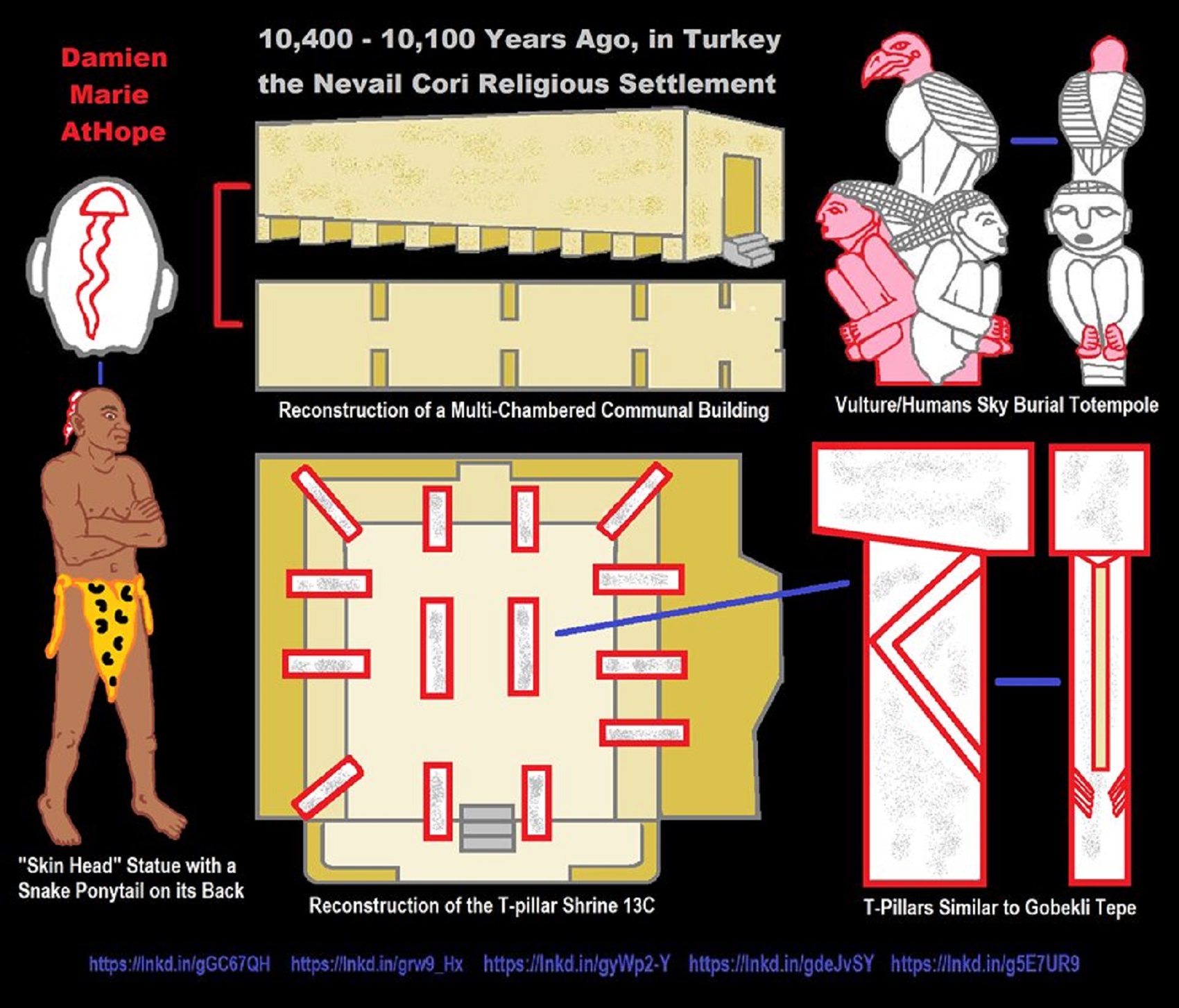


“Neve Yam is in northern Israel. Located around twenty kilometers south of Haifa. Neve-Yam is one of five submerged PN settlements along the Carmel coast linked to the Wadi Rabah culture. The other localities are Megadim, Tel-
“There was evidence for a Separate Burial Ground at the Submerged Pottery Neolithic Site of Neve-Yam, Israel. Neve-Yam, a submerged Pottery-Neolithic (PN) Wadi Rabah settlement second half of the 8th-millennium”
(8th-millennium: 10,000-9,000 years ago) of the
“This is an early example for a clear division between a dwelling zone and a burial ground with stone-built graves in a Neolithic settlement. Three concentrations of charred seeds in the burial area are possibly associated with ritual activities. The separation of the living from the dead in this late PN site is notably different from earlier PN and Pre-Pottery Neolithic (PPN) burial practices and should be considered in light of the later Chalcolithic Ghassulian “starting in middle 7th-millennium” (7th-millennium: 9,000-8,000 years ago) appearance of formal off-site cemeteries.” ref
“Neve Yam involved the Wadi Rabah culture as did the site of En Zippori a
prehistoric settlement remains that range in date from the Pre-Pottery Neolithic period (around 10,000 years ago) to the Early Bronze Age (around 5,000 years ago). Remains of an extensive settlement from the end of the Neolithic period and the beginning of the Chalcolithic period in the country belonging to the “Wadi Rabah” culture.” Wadi Rabah culture as a distinct cultural entity of the southern Levant and suggested possible interconnections to the northern Levant.” ref, ref
“Within the ceramic Neolithic, Yarmukia was followed by Lodien in some areas of Palestine or followed by the Wadi Rabah culture, which is, however, at least partially attributed by some archaeologists to the Chalcolithic period. However, relations with northern cultures are unclear due to the lack of excavations in Syria and Lebanon. It is possible to suggest that the Lodian culture occupied the Hula Valley at the same time as the Yarmukian spread through other areas.” ref, ref
“While no occupation in the Hula Valley can be securely attributed to the Yarmukian culture—the earliest pottery bearing cultural entity in the Southern Levant—while the later Lodian and Wadi Rabah cultural horizons were widely reported. This alone may be taken to imply a gap in the local cultural sequence, which the site of Tel Ro’im West might help fill, a suggestion that is reinforced by the Yarmukian characteristics of the flint assemblage. Several culture-historical implications follow from this. On a local scale, a suggestion implies that the Hula Valley experienced exchanges of northern and southern influences during the Early PN as in later parts of the Pottery Neolithic (see also Rosenberg 2010b and in press). At least insofar as ceramic traditions are concerned, it seems that the earliest Pottery Neolithic cultures in this area was marked by northern influences and were later replaced or evolved into a more distinctive southern facies, associated with the Lodian culture.” ref
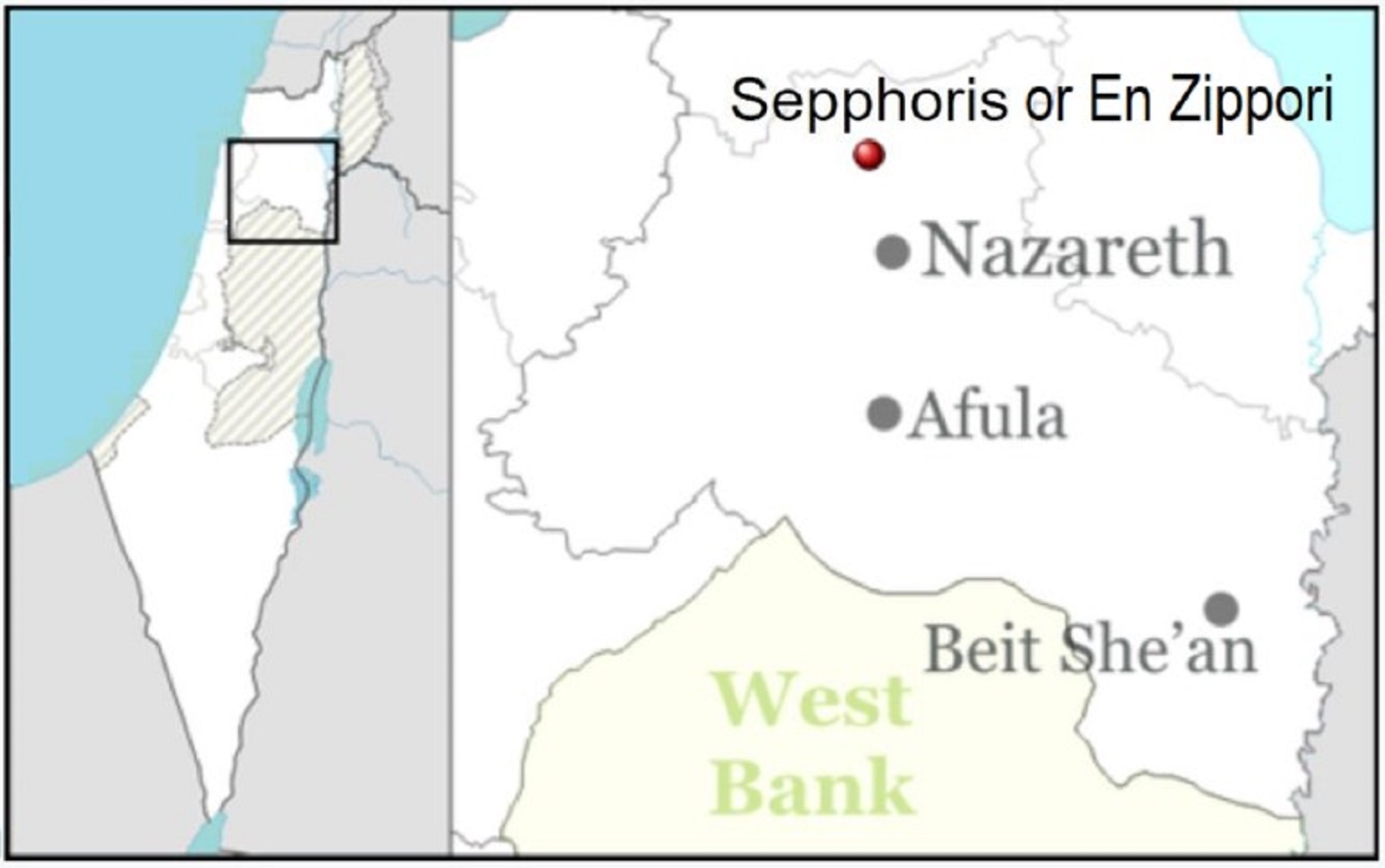
“The most important finds at En Zippori or Sepphoris are stone seals or amulets bearing geometric motifs and stone plaques and bone objects decorated with incising. Among the stone plaques is one that bears a simple but very elegant carving depicting two running ostriches. These objects represent the world of religious beliefs and serve as a link that connects Ein Zippori with the cultures of these periods in Syria and Mesopotamia. The arrival of these objects at the ʽEin Zippori site shows that a social stratum had already developed at that time that included a group of the social elite which used luxury items that were imported from far away countries.” ref
“Figurative Representations from Neveh Yam andOtherSitesinIsrael: Markers of the Late Neolithic/Early Chalcolithic South Levant Cultures. Specifically, are four symbolic artifacts that were recovered from the Late Neolithic/EarlyChalcolithic (Wadi Rabah culture) site of Neveh Yam, dated to the 8,000-7,000 years ago and these comprise two anthropomorphic figurines made of stone, one anthropomorphic image incised on bone and a sherd with zoomorphic incisions. These artifacts relate or hold a reference to similar objects found in additional Late Neolithic/Early Chalcolithic sites in the southern Levant and later sites in Mesopotamia, the Aegean and the Iberian Peninsula. It is proposed that the bone figurines from Neveh Yam, En Zippori (also involves the Yarmukian culture a Neolithic culture of the ancient Levant) and Ha-Gosherim could represent a symbolic marker for the Wadi Rabah culture and contemporary cultures in the southern Levant.” ref
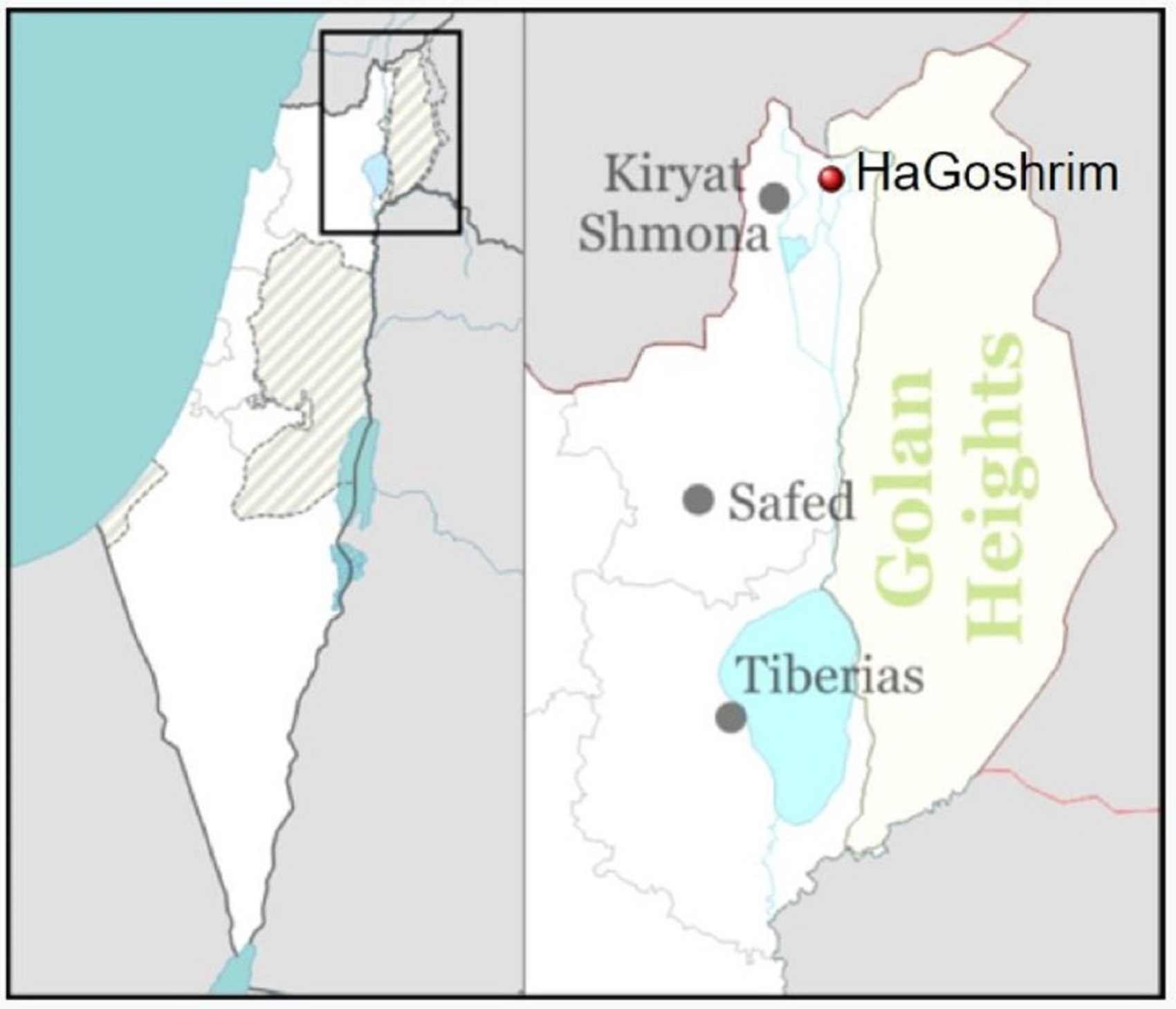
“Excavations at the Neolithic site of Ha-Goshrim yielded a large assemblage of skeletal fragments, mainly of cattle and pigs, providing evidence of the domestication of these taxa in the southern Levant.” ref
Pre-Pottery Neolithic Chronology
- PPNA (ca 10,500 to 9,500 BP) Jericho, Netiv Hagdud,
Nahul Oren, Gesher, Dhar’,Jerf al Ahmar, Abu Hureyra, Göbekli Tepe, Chogha Golan, Beidha - PPNB (ca 9,500 to 8200 BP) Abu Hureyra, Ain Ghazal, Çatalhöyük, Cayönü Tepesi, Jericho, Shillourokambos, Chogha Golan, Gobekli Tepe
- PPNC (ca 8200 to 7500 BP) Hagoshrim, Ain Ghazal. ref
“Ritual behavior during the Pre-Pottery Neolithic is quite remarkable, and PPN sites from all over the Fertile Crescent and extending into Turkey, Israel and Cyprus, and have concluded that there might very well have been inter-regional information and crop flow, which might account for the nearly simultaneous invention of agriculture in the region.” ref

“Yarmukian Culture such as seen at the excavations at Sha’ar HaGolan unearthed an 8,000-year-old village and artifacts that include the first pottery cooking pots found in the Land of Israel. It is situated at the foot of the Golan Heights in the Jordan Valley area of north-eastern Israel. Located less than 1 km from the border with Jordan. At the site of ‘Ain Ghazal, located along the banks of the Zarqa River near Amman, Jordan, the early Pottery Neolithic period is dated from 8,400 to 7,000 years ago. Yarmukian culture, a Pottery Neolithic culture that inhabited parts of Israel and Jordan. The goddess of Sha’ar Hagolan: involves the finding of some 300 art objects making it the most important center of prehistoric art in Israel and there were approximately 70 figurines, make of fired clay and stone, were found in one of its structures; this is the largest find of prehistoric figurines made in a single structure. Sha’ar HaGolan’s figurines in human form made of fired clay or carved on pebbles. The overwhelming majority are female images, interpreted as representing a goddess. This Neolithic Yarmukian village was inhabited by the people who abandoned their nomadic lifestyle in favor of permanent settlement, marking the shift from hunting and gathering to agriculture.” ref, ref, ref
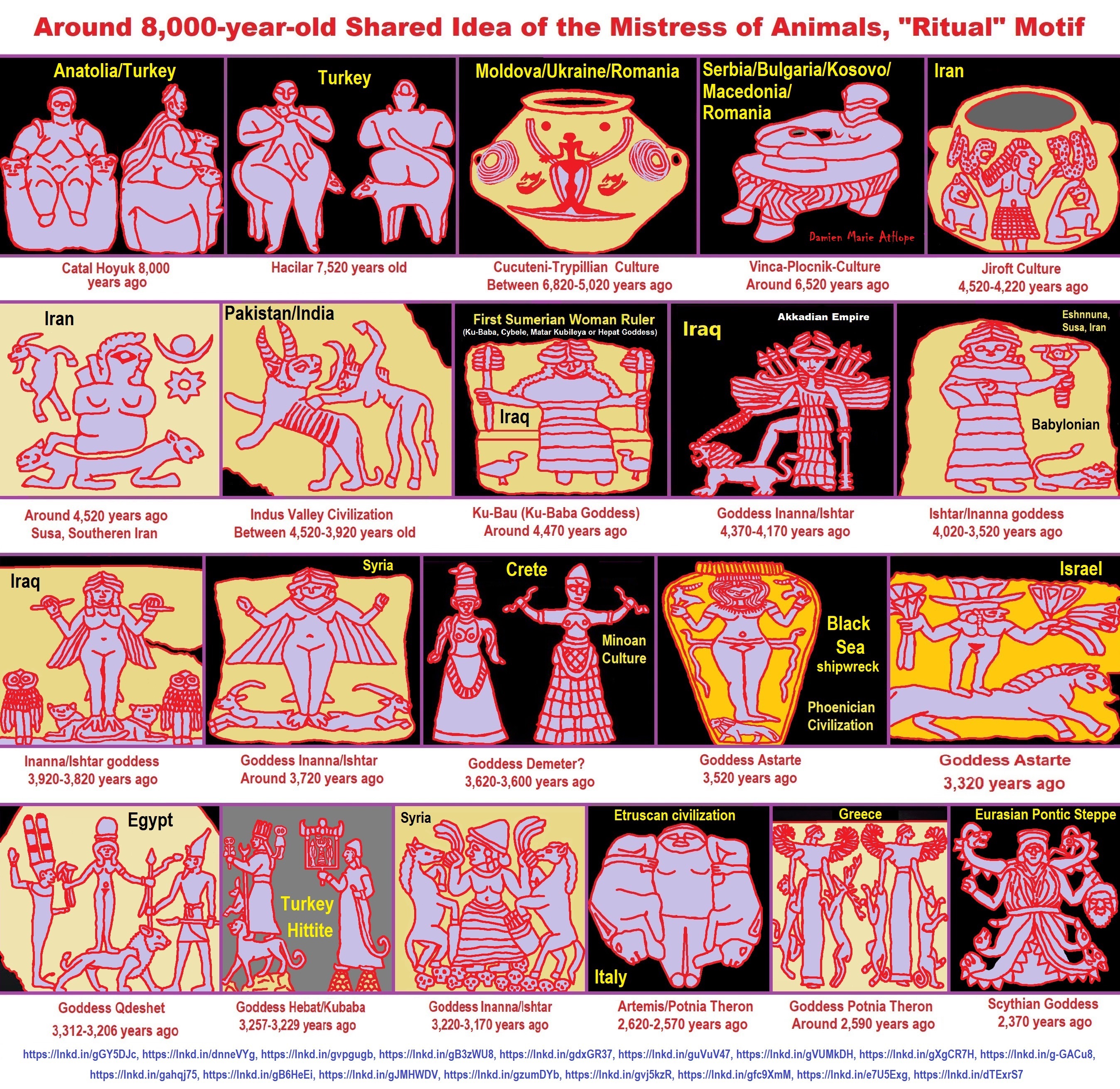
“Asherah figures prominently as the wife of El—the supreme god—in a treasure trove of cuneiform texts found in the second-millennium port city of Ugarit (in today’s Northern Syria). For perhaps hundreds of years before Abraham migrated to what would become known as Israel, Asherah was revered as Athirat, Earth Mother and Fertility Goddess. Upon entering the region, the ancient Israelites soon adopted her and gave her the Hebrew equivalent name of Asherah. But who was Asherah to the ancient Israelites? And why is she often found paired with Yahweh, the Hebrew
“Asherah, was an ancient West Semitic goddess, consort of the supreme god. Her principal epithet was probably “She Who Walks on the Sea.”
The word asherah in the Old Testament was used not only in reference to the goddess herself but also to a wooden cult object associated with her worship. She was occasionally called Elath (Elat), “the Goddess,” and may have also been called Qudshu, “Holiness.” According to texts from Ugarit (modern Ras Shamra, Syria), Asherah’s consort was El, and by
Asherah: The Bible God’s Forgotten Wife
“Historians and archaeologists have pieced together Asherah’s narrative and found large chunks of it interwoven in the artifacts from the region and in the scriptures of the Hebrew Bible itself. Evidence suggests that Asherah was observed in ancient Israel and Judah as early as the 12th century BC, to a few decades before the fall of the southern kingdom of Judah (587-588 BC), a time known as the pre-exilic period. Were the pre-exilic Israelites and Judeans polytheistic? In fact, the very notion of polytheism is inherent in the quest for Asherah. After all, Asherah’s place in the pantheon is alongside Yahweh’s, the supreme deity. Furthermore, the many artifacts representing Asherah and her cult from the region belies the biblical prohibition against the creation of idols.” ref
Yahweh and his Asherah
“As much as the ruling elite tried to inhibit Asherah and Yahweh’s “marriage,” their union appears solidified in an ancient blessing seen with some regularity at a number of excavation sites in the region. The inscription reads: “I have blessed you by Yahweh….and his Asherah.” Not only was this engraving found in the 2,900-2,800 years ago Israelite caravanserai, Kuntillet Ajrud, the same text was found in a number of sites thought to be Yahweh sanctuaries, such as in Samaria, Jerusalem, Teman, and in the Biblical kingdom of Judah, at the ancient burial site of Khirbet el-Qom, dating to 2,750 years ago.” ref
“An Asherah pole is a sacred tree or pole that stood near Canaanite religious locations to honor the Ugaritic mother-goddess Asherah, consort of El. The relation of the literary references to an
“In translations that render the Hebrew asherim into English as “Asherah poles,” the insertion of “pole” begs the question by setting up unwarranted expectations for such a wooden object: “we are never told exactly what it was”, observes John Day. Though there was certainly a movement against goddess-worship at the Jerusalem Temple in the time of King Josiah (2 Chronicles 34:3), it did not long survive his reign, as the following four kings “did what was evil in the eyes of Yahweh” (2 Kings 23:32, 37; 24:9, 19)[citation needed]. Further exhortations came from Jeremiah. The traditional interpretation of the Biblical text is that the Israelites imported pagan elements such as the Asherah poles from the surrounding Canaanites. In light of archeological finds, however, modern scholars now theorize that the Israelite folk religion was Canaanite in its inception and always polytheistic, and it was the prophets and priests who denounced the Asherah poles who were the innovators; such theories inspire ongoing debate.” ref
“Asherim are mentioned in the Hebrew Bible in the books of Exodus, Deuteronomy, Judges, the Books of Kings, the second Book of Chronicles, and the books of Isaiah, Jeremiah, and Micah. The term often appears as merely אשרה, (Asherah) referred to as “groves” in the King James Version, which follows the Septuagint rendering as ἄλσος, pl. ἄλση, and the Vulgate
“Deuteronomy 16:21 states that YHWH (rendered as “the Lord”) hated Asherim whether rendered as poles: “Do not set up any [wooden] Asherah [pole] beside the altar you build to the Lord your God” or as living trees: “You shall not plant any tree as an Asherah beside the altar of the Lord your God which you shall make”. That Asherahs were not always living trees is shown in 1 Kings 14:23: “their
in a reproduction of a seal representing the Sumerian god Enlil, a tree, and his wife, the goddess Ninlil.
Goddess Ninkharsag—Ancient Powerful Mother who Faded into The Holy Ghost
“Have you ever wondered how the bible-god created male and female in his image seen in Genesis 1:27? There are other sources that give alternate accounts, filling in missing details or answering questions raised by reading Genesis. The Jews wrote their religious texts while in captivity in Babylon, using the Sumerian and Assyrian tales of gods and goddesses as a basis, and then amending them to fit their own mythology and religion. It is in the Sumerian/Babylonian tales we find a different perspective on a well-known story.” ref
“As a result of her peace efforts and in acknowledgment of her accomplishments as a scientist, including the creation of humans, she was given the honorific ‘Lady of Life’, or Mammu/Mama and became known from then on as Ninkharsag. She is the mother-goddess that we know in many forms, (though not Mother-Earth, which is Tiamat or Gaia), the creator of life whose milk nourishes kings. So, how did she lose her position? The mythological record states the war of arms became a war of ideology as mankind continued to grow in spite of Enlil’s efforts at population control. As man diversified, most found themselves in two camps: Enki, whose dominion was Magan, or Egypt, and Enlil, who had moved his power base from Sumer to what we know today as Jerusalem.” ref
“Ninkharsag, who had become the middle-eastern Asherah (Astarte), the partner of El. In many places in the Old Testament, there were prophets begging the people to forget
Asherah as Tree of Life on Tanaach Cult Stand
“The Tree of Life is an epiphany of the Goddess Asherah.”
“Dating to around 3,000 years ago, this “four-tiered cult stand found at Tanaach is thought to represent Yahweh and Asherah, with each deity being depicted on alternating tiers. Note that on tier two, which is dedicated to Asherah, is the image of a living tree…”. -Biblical Archaeology Society” ref
“Tanaach is an ancient royal city of the Canaanites, on the south-western border of the plain of Esdraelon, 4 miles south of Megiddo. Its king was conquered by (Joshua 12:21). It was assigned to the Levites of the family of Kohath (17:
Inanna, the most prominent female deity in ancient Mesopotamia on the Ishtar Vase.
“In Sumer, Inanna was hailed as “Queen of Heaven” in the third millennium BC. In Akkad to the north, she was worshipped later as Ishtar. Her cult was deeply embedded in Mesopotamia and among the Canaanites to the west. The goddess, the Queen of Heaven, whose worship Jeremiah so vehemently opposed, may have been possibly Astarte. Astarte is the name of a goddess as known from Northwestern Semitic regions, cognate in name, origin, and functions with the goddess Ishtar in Mesopotamian. Another transliteration is ‘Ashtart; other names for the goddess include Hebrew (Ashtoreth), Ugaritic ‘ṯtrt (also ‘Aṯtart or ‘Athtart), Akkadian As-tar-tú (also Astartu) and Etruscan Uni-Astre (Pyrgi Tablets). Astarte may be the Iron Age (after 3,200 years ago) incarnation of the Bronze Age (to 3,200 years ago) Asherah. Astarte was connected with fertility, sexuality, and war.” ref
“Asherah was worshipped in ancient Israel as the consort of El and in Judah as the consort of Yahweh and Queen of Heaven (the Hebrews baked small cakes for her festival): “Seest thou not what they do in the cities of Judah and in the streets of Jerusalem? The children gather wood, and the fathers kindle the fire, and the women knead their dough, to make cakes to the queen of heaven, and to pour out drink offerings unto other gods, that they may provoke me to anger. And to burn incense unto the queen of heaven, and to pour out drink offerings unto her, as we have done, we, and our fathers, our kings, and our princes, in the cities of Judah, and in the streets of Jerusalem.” ref
Asherah and the Asherim: Goddess or Cult Symbol?
Well according to Ellen White, Ph.D. (Hebrew Bible, University of St. Michael’s College), Biblicalarchaeology.org exploring the Biblical and archaeological evidence:
“Who is Asherah? Or, perhaps, what is
“This diversity of grammar leads to the two questions at the beginning of this article: Who is Asherah? What is
“This goddess is known from several other Ancient Near Eastern cultures. Sometimes she is known as “Lady Asherah of the Sea” but could be taken as “She who walks on the sea.” As Athirat, a cognate name for Asherah, she is mother of 70 children (this relates to the Jewish idea of the 70 guardian angels of the nations). Arguments have been made that Asherah is a figure in Egyptian, Hittite, Philistine and Arabic texts. Egyptian representations of “Qudshu” (potentially the Egyptian name for Asherah) show her naked with snakes and flowers, sometimes standing on a lion. Whether this should be interpreted as Asherah is contested and thus should be viewed with caution.” ref
“Another suggestion is Asherah is also the Hittite goddess Asertu, who is married to Elkunirsa, the storm god (she is often viewed in connection with the regional storm god). As Athirat in
“Asherah or
“The relationship between Asherah and Israel is a complicated one. Does the text refer to the goddess or her symbol? Jeroboam and Rehoboam fostered Asherah worship (1 Kings 14:15, 23). Worship of Asherah was highly encouraged by Jezebel, with the presence of 400 prophets who held a place in the court of her husband King Ahab (1 Kings 18:19). Worship of Asherah is given as a reason for deportation (2 Kings 17:10,16). Attempts to eradicate the worship were made by Asa, Josiah, Jehoshaphat, Hezekiah and Gideon (Exodus 34:13-14; Deuteronomy 7:5; Judges 6:25-30; 1 Kings 15:13/2 Chronicles 15:16; 2 Kings 23:4,7/2 Chronicles 34:3,7; 2 Kings 21:7/2 Chronicles 33:3,19; 2 Chronicles 19:3; 2 Kings 18:4). However, devotion to the cult symbol remained (Isaiah 27:9; Jeremiah 17:1; Micah 5:14). It is particularly interesting that objections to Asherah are found mostly in Deuteronomistic literature, rather than in the prophets. In both cases, the authors are much more concerned about the worship of Baal rather than Asherah.” ref
“This apparent lack of concern might be due to a popular connection between Yahweh and his Asherah. Inscriptions from Kuntillet ‘Ajrud and Khirbet el-Qom (on walls) contain the phrase “Yahweh and his Asherah.” Some take this to mean it was believed that she was seen as the wife of Yahweh and represents the goddess herself. Yet, the presence of the suffix could suggest that it is not a personal name. This has led others to believe it is a reference to the cult symbol. A more obscure opinion claims it means a
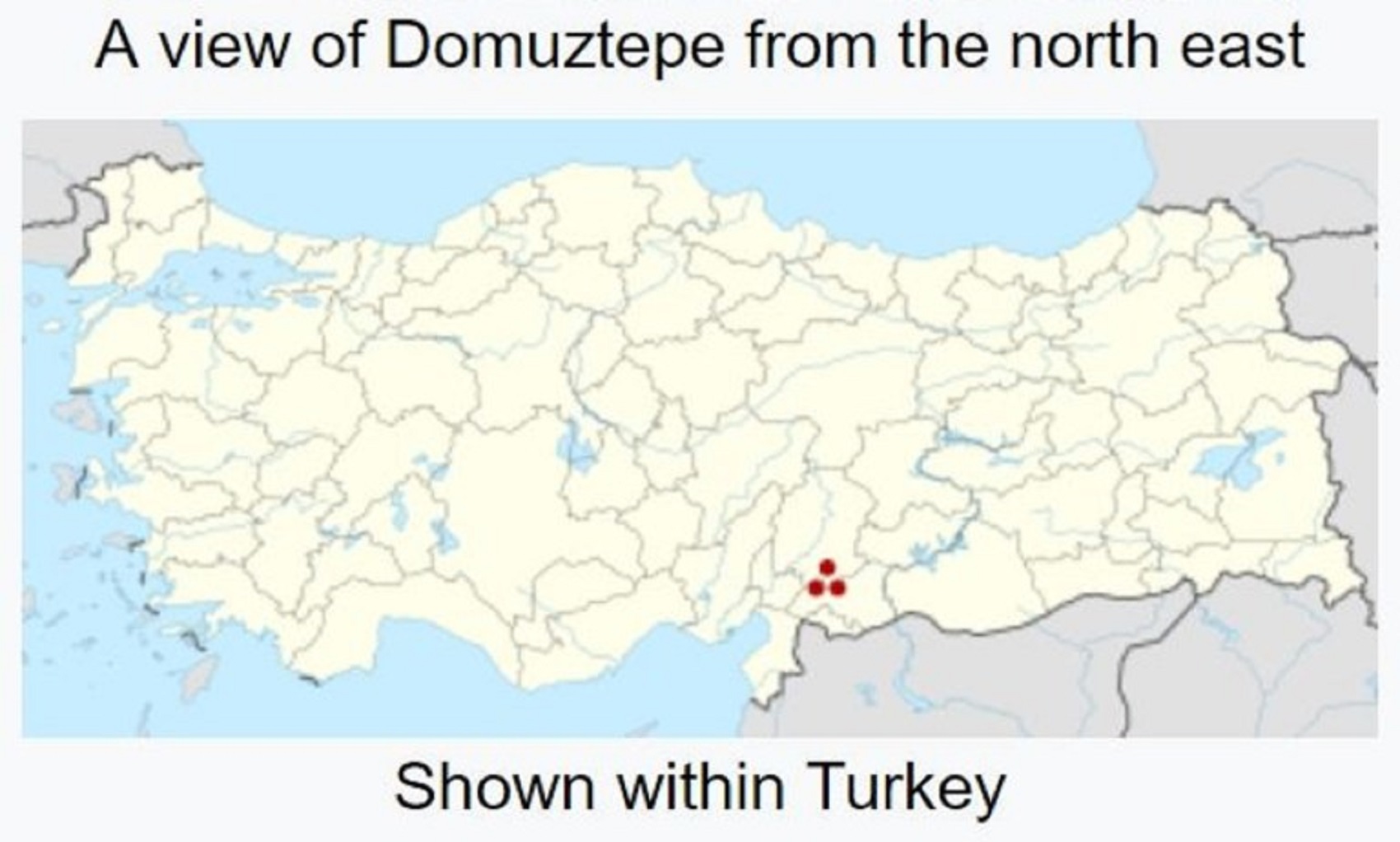
Oldest Examples of ‘Tree of Life’ Designs Discovered in Domuztepe Mound, Turkey
Archaeologists have unearthed vessels portraying “tree of life” motifs during excavation works in the Domuztepe Mound in the southern province of Kahramanmaraş, which is considered to be the biggest settlement in the region since the usage of the term “Near East.” ref, ref
“Tree of Life” Unearthed
“Directed by Hacettepe University Archaeology Department academic Dr. Halil Tekin under the allocation of the Kahramanmaraş Museum Directorate, the excavations were launched in 2013 as Hurriyet reports .”
ref, ref
“The Domuztepe Mound is undoubtedly the early examples of a tree motif, known as the “tree of life” in ancient Near East archaeology, with cumulative motifs. “The origin of this tree, which has become used as a Christmas tree in the Christian world throughout time, is here, namely in Mesopotamia. The earliest known example of it is in Domuztepe,” Tekin said as Hurriyet reports, pointing out the cultural significance of the tree of life motifs. “It is not an ordinary tree. It is related to a faith system, a burial tradition,” he added.” ref, ref
The Tree of Life and Its Symbolism
“The tree of life is a widespread myth or archetype in the world’s mythologies, related to the concept of
Various trees of life are recounted in folklore, culture, and fiction, often relating to immortality or fertility. They had their origin in religious symbolism.” ref
“In the Avestan literature and Iranian mythology, there are several sacred vegetal icons related to life, eternality and cure, like: Amesha Spenta Amordad(guardian of plants, goddess of trees and immortality), Gaokerena (or white Haoma, a tree that its vivacity would certify continuance of life in the universe), Bas
“Gaokerena is a large, sacred Haoma planted by Ahura Mazda. Ahriman (
“Haoma is another sacred plant due to the drink made from it. The preparation of the drink from the plant by pounding and the drinking of it are central features of Zoroastrian ritual. Haoma is also personified as a divinity. It bestows essential vital qualities—health, fertility, husbands for maidens, even immortality. The source of the earthly haoma plant is a shining white tree that grows on a paradisiacal mountain. Sprigs of this white haoma were brought to earth by divine birds. Haoma is the Avestan form of the Sanskrit soma. The near identity of the two in ritual significance is considered by scholars to point to a salient feature of an Indo-Iranian religion antedating Zoroastrianism.” ref
“In Babylonian mythology, the Tree of Life was a magical tree that grew in the center of paradise. The Apsu, or primordial waters, flowed from its roots. It is the prototype of the tree described in Genesis: the biblical Tree of Paradise evolved directly from this ancient symbol; it is the symbol from which the Egyptian, Islamic, and Kabbalistic Tree of Life concepts originated. Nowadays, we use “tree of life” as a metaphor usually, even though various stylized images of the tree of life can also represent the spine and branches of the human nervous system.” ref, ref
“Etz Chaim, Hebrew for “tree of life,” is a common term used in Judaism. The expression, found in the Book of Proverbs, is figuratively applied to the Torah itself. Etz Chaim is also a common name for yeshivas and synagogues as well as for works of Rabbinic literature. It is also used to describe each of the wooden poles to which the parchment of a Sefer Torah is attached.” ref
“The tree of life is mentioned in the Book of Genesis; it is distinct from the tree of the knowledge of good and evil. After Adam and Eve disobeyed God by eating fruit from the tree of the knowledge of good and evil, they were driven out of the Garden of Eden. Remaining in the garden, however, was the tree of life. To prevent their access to this tree in the future, Cherubim with a flaming sword were placed at the east of the garden. (Genesis 3:22-24).” ref
“In the Book of Proverbs, the tree of life is associated with wisdom: “[Wisdom] is a tree of life to them that lay hold upon her, and happy [is every one] that retaineth her.” (Proverbs 3:13-18) In 15:4 the tree of life is associated with calmness: “A soothing tongue is a tree of
“According to Dr. Tekin, the oldest known example of this tree’s culture, however, is in Domuztepe from where it expanded to the rest of the world, “We are talking about the period of the 9,000-8,000 years ago. The oldest known example of this tree’s culture or belief system is in Domuztepe. We believe it expanded from Domuztepe in various ways. The oldest example is here. It expanded to the south, to Basra and then became the most important factor in Sumerian civilization. There is also a similar tree in the Acadians, which is known as the ‘eya tree’ in Hittite documents in the 5,000-4,000 years ago. The pine tree symbolizes life because it is a tree that never dies. The one we have found here is a tree with thorny leaves. This is why we believe it is a symbol of life,” he told Hurriyet and promised that more detailed information about the important find will be announced soon.
ref, ref
Excavations in the Domuztepe Mound in the southern province of Kahramanmaraş, considered to be the biggest settlement in the era since the usage of the term “Near East,” have unearthed vessels depicting “tree of life” motifs.” ref, ref

“Migration from Siberia behind the formation of Göbeklitepe: Expert states. People who migrated from Siberia formed the Göbeklitepe, and those in Göbeklitepe migrated in five other ways to spread to the world, said experts about the 12,000-year-old Neolithic archaeological site in the southwestern province of Şanlıurfa.“ The upper paleolithic migrations between Siberia and the Near East is a process that has been confirmed by material culture documents,” he said.” ref
“Semih Güneri, a retired professor from Caucasia and Central Asia Archaeology Research Center of Dokuz Eylül University, and his colleague, Professor Ekaterine Lipnina, presented the Siberia-Göbeklitepe hypothesis they have developed in recent years at the congress held in Istanbul between June 11 and 13. There was a migration that started from Siberia 30,000 years ago and spread to all of Asia and then to Eastern and Northern Europe, Güneri said at the international congress.” ref
“The relationship of Göbeklitepe high culture with the carriers of Siberian microblade stone tool technology is no longer a secret,” he said while emphasizing that the most important branch of the migrations extended to the Near East. “The results of the genetic analyzes of Iraq’s Zagros region confirm the traces of the Siberian/North Asian indigenous people, who arrived at Zagros via the Central Asian mountainous corridor and met with the Göbeklitepe culture via Northern Iraq,” he added.” ref
“Emphasizing that the stone tool technology was transported approximately 7,000 kilometers from east to west, he said, “It is not clear whether this technology is transmitted directly to long distances by people speaking the Turkish language at the earliest, or it travels this long-distance through using way stations.” According to the archaeological documents, it is known that the Siberian people had reached the Zagros region, he said. “There seems to be a relationship between Siberian hunter-gatherers and native Zagros hunter-gatherers,” Güneri said, adding that the results of genetic studies show that Siberian people reached as far as the Zagros.” ref
“There were three waves of migration of Turkish tribes from the Southern Siberia to Europe,” said Osman Karatay, a professor from Ege University. He added that most of the groups in the third wave, which took place between 2600-2400 BCE, assimilated and entered the Germanic tribes and that there was a genetic kinship between their tribes and the Turks. The professor also pointed out that there are indications that there is a technology and tool transfer from Siberia to the Göbeklitepe region and that it is not known whether people came, and if any, whether they were Turkish.” ref
“Around 12,000 years ago, there would be no ‘Turks’ as we know it today. However, there may have been tribes that we could call our ‘common ancestors,’” he added. “Talking about 30,000 years ago, it is impossible to identify and classify nations in today’s terms,” said Murat Öztürk, associate professor from İnönü University. He also said that it is not possible to determine who came to where during the migrations that were accepted to have been made thousands of years ago from Siberia. On the other hand, Mehmet Özdoğan, an academic from Istanbul University, has an idea of where “the people of Göbeklitepe migrated to.” ref
“According to Özdoğan, “the people of Göbeklitepe turned into farmers, and they could not stand the pressure of the overwhelming clergy and started to migrate to five ways.” “Migrations take place primarily in groups. One of the five routes extends to the Caucasus, another from Iran to Central Asia, the Mediterranean coast to Spain, Thrace and [the northwestern province of] Kırklareli to Europe and England, and one route is to Istanbul via [Istanbul’s neighboring province of] Sakarya and stops,” Özdoğan said. In a very short time after the migration of farmers in Göbeklitepe, 300 settlements were established only around northern Greece, Bulgaria, and Thrace. “Those who remained in Göbeklitepe pulled the trigger of Mesopotamian civilization in the following periods, and those who migrated to Mesopotamia started irrigated agriculture before the Sumerians,” he said.” ref

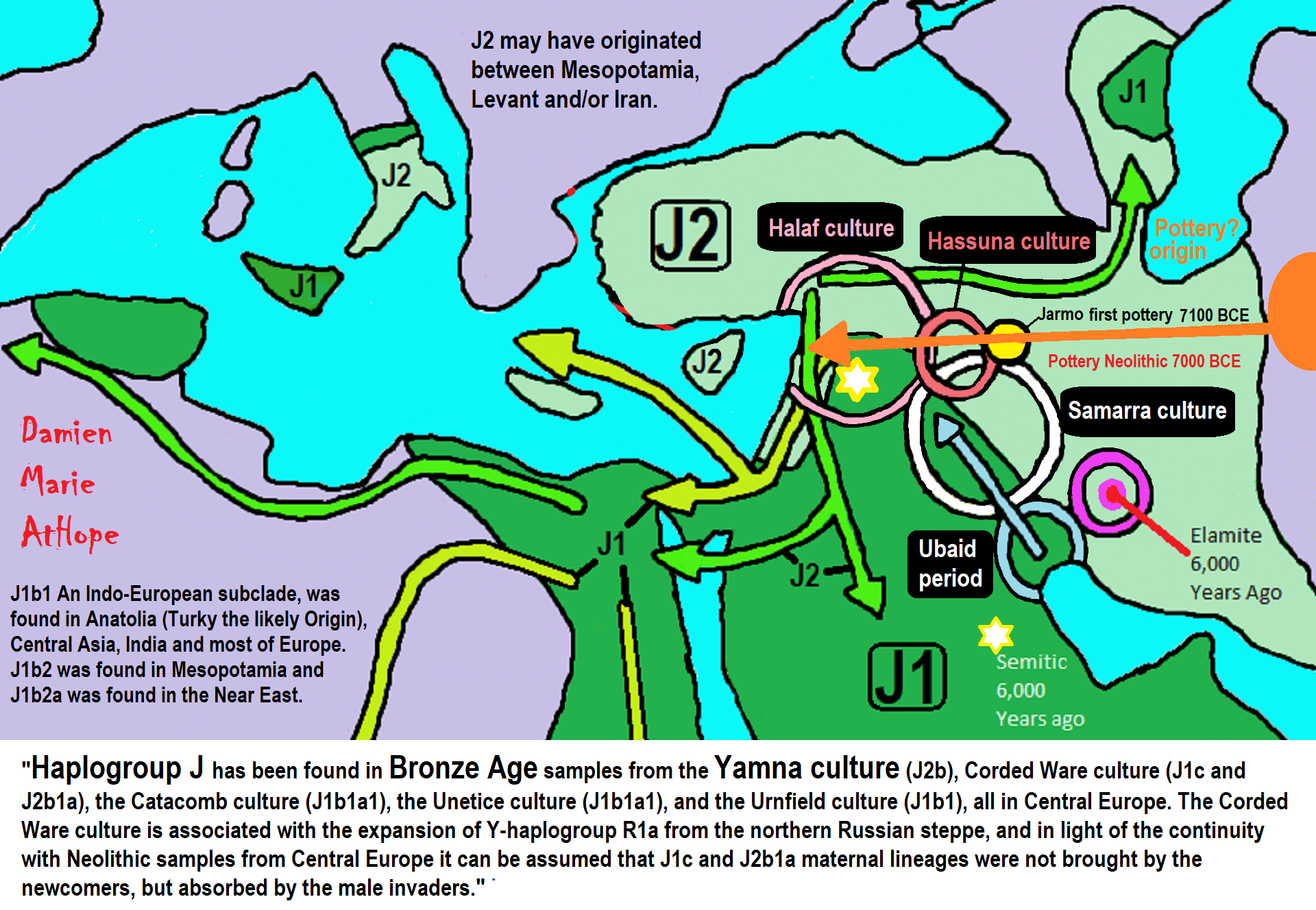
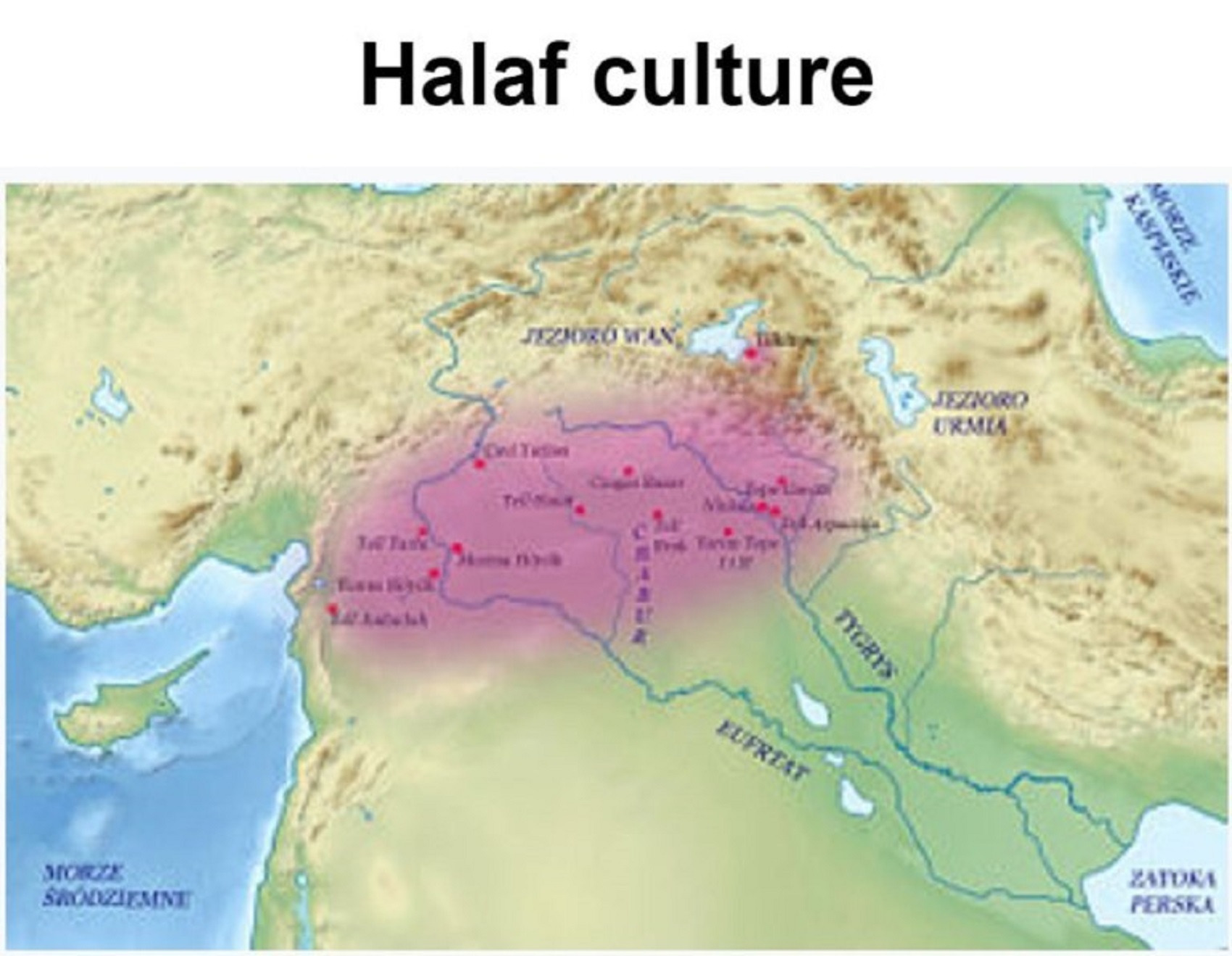
“Domuztepe (meaning Pig Hill in Turkish) was a large, late Neolithic settlement in southeast Turkey, occupied at least as early as around 8,200 years ago and abandoned around 7,450 years ago. The site is located to the south of Kahramanmaraş. Covering 20 hectares, it is primarily a Halaf site of the 6
“In Palestine, Syria and south-eastern Turkey, the earliest finds of clay pots date from Neolithic times, around the 8th millennium BC (black burnished ware). Before that, clay had been used to make statuettes of humans and animals that were sometimes burned as well. In the preceding Pre-Pottery Neolithic, vessels made of stone, gypsum and burnt lime (
“The Halaf culture is a prehistoric period which lasted between about 8,100-7,100 years ago. The period is a continuous development out of the earlier Pottery Neolithic and is located primarily in south-eastern Turkey, Syria, and northern Iraq, although Halaf-influenced material is found throughout Greater Mesopotamia. The earliest Halaf period material was excavated at the site of Sakce Gözü, then in Syria but now part of Turkey. Small amounts of Halaf material were also excavated at Carchemish, on the Turkish/Syrian border. However, the most important site for the Halaf tradition was the site of Tell Arpachiyah, now located in the suburbs of Mosul, Iraq. The Halaf period was succeeded by the Halaf-Ubaid Transitional period which comprised the late Halaf (7,400-7,000 years ago), and then by the Ubaid period.” ref
“The homeland of Halaf culture, and in some way the Halafians emerged from a formerly unknown transitional culture between the pre-Halaf Neolithic‘s era and
“Halaf pottery has been found in other parts of northern Mesopotamia, such as at Nineveh and Tepe Gawra, Chagar Bazar and at many sites in Anatolia (Turkey) suggesting that it was widely used in the region. In addition, the Halaf communities made female figurines of partially baked clay and stone and stamp seals of stone, (see also Impression seal). The seals are thought to mark the development of concepts of personal property, as similar seals were used for this purpose in later times. The Halaf people used tools made of stone and clay. Copper was also known, but was not used for tools.” ref
“Halaf culture ended by 7,000 years ago after entering the so-called Halaf-Ubaid Transitional period. Many Halafians settlements were abandoned, and the remaining ones showed Ubaidiancharacters. The new period is named Northern Ubaid to distinguish it from the proper Ubaid in southern Mesopotamia, and two explanations were presented for the transformation. And the most plausible theory is a Halafian adoption of the Ubaid culture as
there is no hiatus between the Halaf and northern Ubaid which exclude the invasion theory.” ref
History of Domuztepe occupation
“Halaf style ceramics from Kultepe, Azerbaijan, dated to around 10,000 years ago may relate to later Domuztepe. Kültəpə (also Aşağı Gültəpə, Gültəpə, Kyul’tepe, Kul’tepe, and Kultepe) is a settlement dated from the Neolithic Age, a village and municipality in the Babek Rayon of Nakhchivan, Azerbaijan. The earliest 9 m of this belongs to the Neolithic Age. Some Halaf culture artifacts have been found. On top of that are the remains of the Bronze Age, and then the Early Iron Age.
Kultepe (Kul’tepe) is the place where the first items made of copper-arsenic alloys, dating back to the 4th millennium BC, were found in the South Caucasus.” ref, ref
“Kultepe Regional influence: The archaeological site Alikemek Tepesi is located in the Mugan plain along the Aras (river). Some archaeologists speak of the ancient Alikemek-Kul’tepe culture of the southeastern Caucasus, that followed the Shulaveri-Shomu culture, and covered the transition from the Neolithic to Chalcolithic periods (c. 4500 BC). Aratashen (following level II) was also part of this culture.” The Alikemek–Kul’tepe culture covered the Ararat Plain, Nakhichevan, the Mil’skoj and Mugan Steppes and the region around Lake Urmia in north-western Iran.” ref
The Domuztepe site was certainly founded by the Ceramic Neolithic (around 8,400 years ago) but earlier occupation may well be present. By the late
“The excavated part of the prehistoric sequence atDomuztepe starts at the transition between the Ceramic Neolithic and the Early Halaf (around 8,100 years ago) and continues until around 7,450 years ago. The Halaf occupation has been traced in a series of trenches across the site, providing rich evidence for both circular and rectangular buildings, ceramics, stone bowls, beads, figurines, chipped stone, bone tools, and stamp seals, as well as a rich assemblage of animal bones and botanical remains. Excavation has concentrated on Operation I, on the summit of the southern mound. In the Early Halaf an east-west terrace was built up from red clay, with a series of occupational deposits to the south, and maintained in subsequent phases.” ref
The Domuztepe Death Pit
“Highly complex burial was excavated, called the ‘Death Pit’. This pit was more than 3m in diameter and about 1.5m deep, filled with layers of dis-articulated human and animal bones, broken pottery and other artifacts. The ceremonies that produce this feature probably took place over a few weeks and had several phases. The earliest layer of the Death Pit mainly contained animal bones, apparently from large-scale feasting. Later deposits included the remains of up to 40 people. The bodies had been heavily fragmented and cannibalism may have taken place. After the Death Pit was filled, it was covered in a thick layer of ash and marked with large posts. Further deposits of human remains were placed around its edges.” ref
Domuztepe Obsidian trade
“Research identified some Armenian obsidian at Domuztepe. Electron microprobe analysis and portable X-ray fluorescence were used. 15 artifacts from Domuztepe match
Armenian is in the South Caucasus region of Eurasia. Located in Western Asia[ on the Armenian Highlands, it is bordered by Turkey to the west, Georgia to the north, the de facto independent Republic of Artsakh and Azerbaijan to the east, and Iran and Azerbaijan’s exclave of Nakhchivan to the south. Armenia lies in the highlands surrounding the mountains of Ararat. There is evidence of an early civilization in Armenia in the Bronze Age and earlier, dating to about 4000 BC. Archaeological surveys at the
According to the story of Hayk, the legendary founder of Armenia, around 4,107 years ago Hayk fought against Belus, the Babylonian God of War, at Çavuştepe along the Engil river to establish the very first Armenian state. Historically, this event coincides with the destruction of Akkad by the Gutian dynasty of Sumer in 4,115 years ago, a time when Hayk may have left with the “more than 300 members of his household” as told in the legend, and also during the beginning of when a Mesopotamian Dark Age was occurring due to the fall of the Akkadian Empire in 4,154 years ago which may have acted as a backdrop for the events in the legend-making him leave Mesopotamia.” ref
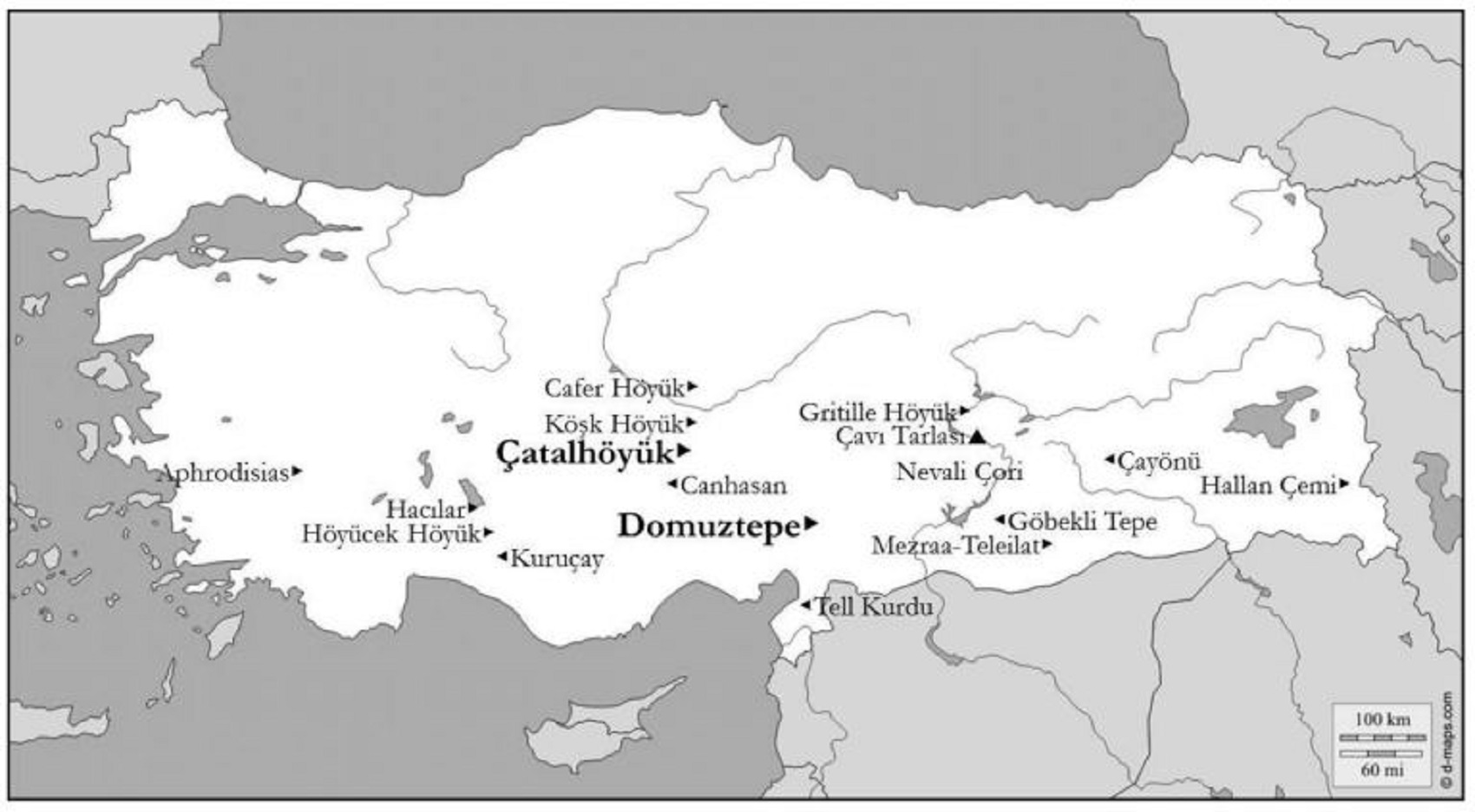
Exchanges of Identity in Prehistoric Anatolian Figurines
“Understanding should involve the exchange imagery and ideology of the human body manifested through figurines from prehistoric (around 9,000–8,000 years ago) Anatolian contexts. These figurines document local, regional and inter-regional communication of identity, use of materials, ideologies, and skills. This involves the landscape of prehistoric Anatolian figurines and suggests four themes of interpretation and analysis, which are then applied to two case studies, Çatalhöyük and Domuztepe.” ref
“These are located on either side of the Taurus Mountains, in different landscapes and cultural zones, and situated chronologically on either side of the development of pottery. The figurines we are considering from Çatalhöyük were excavated from the
“The prehistoric Anatolian figurine landscape presents excavated assemblages found at sites across southern Anatolia. Distances between sites vary, and different sites had differential access to raw materials. All had access to clay and most had access to stone and a communal knowledge base to work and manufacture figurines from these materials. Across Anatolia, a spectrum of regionally shared and locally established figurine practices crossed regions and millennia, some which were long lasting, others short-lived or experimental.” ref
“The influences and communications regarding prehistoric representation of the human body were not simply confined to the Anatolian region. Reciprocal communication and contact beyond the borders of Anatolia
“Considered together, these figurine assemblages suggest that there was certainly communication about conventions in a representation of the human form. It is important to remember that each figurine represents the individual choices of those that conceived, made, acquired, used, reused and discarded each and every figurine. Social and cultural practices are entangled within each of these choices, made by individuals or small groups. The prehistory of Anatolian anthropomorphic imagery runs deep and broad beyond our two case studies.” ref
“Early examples range in size from anthropomorphic pestles at Hallan Cemi to stone steles at Göbekli Tepe. Figurines in clay and stone include published assemblages from Mezraa Teleilat, Nevalı Çori, Gritille Höyük, Çayönü, Hacılar. Later pottery producing Neolithic settlements yielding figurines include Aphrodisias, Höyücek, Hacılar, Kuruçay, Köşk Höyük, Canhasan, Domuztepe and Tell Kurdu. These represent a sample of the total corpus of figures, rather than a comprehensive account, which would include 10,000s of examples.” ref
“At Domuztepe, the emphasis is on stone, and implications of body parts that are inferred from profiles, rather than actually represented. The materiality of the figurine may have agency in the finished product, perhaps dictated by observed possibilities in the materials. A phallic figurine from Domuztepe was only worked with a quick incision to accentuate the suggestive shape of the naturally occurring pebble. The working of locally available stones into human form at Domuztepe may relate to the makers and users’ community belonging and connected them to their landscape. Of the Domuztepe figurines, one type dominates; a flat figurine carved from a variety of locally available soft stones.” ref
“There are 10 such figurines found in late Halaf contexts, all representing standing figures in the same pose, in varying degrees of specificity. These were expertly carved, ground, polished, notched and incised in low relief, the silhouette of a front-facing body is represented with bent arms, which imply hands clasped between and supporting breasts. Therefore the outline of the figurine ambiguously implies that these figurines might be gendered female. In addition to ambiguities in gender, figurines also show ambiguities in form, and between the human, animal, and spiritual worlds. Figurines do not always represent humans in ways we recognize. It may be that ideas beyond the physical anthropomorphic body are represented. As mentioned above, some ambiguity is rooted in the properties and possibilities of the raw materials.” ref
“The example of a figurine vessel from Domuztepe, probably made to hold liquids, shows fluidity between identity and our four interpretative themes. There is an obvious human engagement with the object; wear shows that it was held on the sides and that it was frequently picked up and put down on its feet, on which it solidly stands, but gives the impression of walking. While standing figurine vessels have been found elsewhere in Anatolia each is created in a unique form, suggesting the idea but not the exact form probably traveled over great distances. Such figurine vessels incorporate aspects of all four of our themes, displaying choices in materiality, fractured bodies, missing their heads, gendered identities, as well as ambiguities in their categorization, as both figurines and vessels.” ref
8000-year-old fertility stone works found in Israel linked to ancestor cult
“About 8,000 years ago, Stone Age people built a large number of what seem to be ancestor and fertility cult sites in the Negev Desert in Israel. A new archaeological survey of 95 sites has turned up stones arranged to represent death, while vulva- and penis-shaped rocks and stone arrangements suggest fertility. In combination these death and sex arrangements relate to ancestor cults, the lead researcher said. Little is known of the spiritual and religious activities of the people of this region from the Neolithic. The main essence of the cult in these sites was for the ancestors. However, ‘regular’ standing stones found in the sites, individual ones, pairs, triads and groups of seven, which may be clan leaders, special religious persons or indicate invocation to a complex pantheon with several ‘organic’ groups of deities which are later known from Near Eastern art, dedication inscriptions and mythological texts.” ref
Ain Ghazal: Pre-Pottery Neolithic Site in the Levant
“The site of ‘Ain Ghazal is an early Neolithic village site located along the banks of the Zarqa River near Amman, Jordan. The name means “Spring of the Gazelles”, and the site has major occupations during the Pre-Pottery Neolithic B (PPNB) period, about 9,200-8,000 years ago; the PPNC period (ca. 8,000-7,500 years ago ), and during the early pottery Neolithic, between ca 7,500-7,000 years ago. ‘Ain Ghazal covers some 30 acres, three times the size of the similarly dated levels at Jericho. The PPNB occupation has several multiroomed rectangular dwellings which were built and rebuilt at least five times. Nearly 100 burials have been recovered from this period. Ritual behavior seen at ‘Ain Ghazal includes the presence of numerous human and animal figurines, some large human statues with distinctive eyes, and some plastered skulls. Five large lime plaster statues were recovered, of quasi-human forms made of reed bundles covered with plaster. The forms have square torsos and two or three heads.” https://lnkd.in/eYsk2f2
“Excavations at ‘Ain Ghazal have aided considerably in the understanding about the knowledge of several aspects of the Neolithic. Of particular interest has been the documentation of a continuous, or near-continuous, occupation from early through late Neolithic components, and a concomitant dramatic economic shift. This shift was from a broad subsistence base relying on a variety of both wild and domestic plants and animals, to an economic strategy reflecting an apparent emphasis on pastoralism. Domesticated wheat, barley, peas,
Roots of a changing early society 7200-6700 years ago Jordan and Israel?
Settlement at Tel Tsaf, near the Jordan River and the modern state of Jordan, dates to circa 5200-4700 BCE. According to the international team of researchers, the site offers “ideal conditions to study changes in household economies and emerging social complexity during the formative stages of the Late Chalcolithic period.”. https://lnkd.in/eifx2Cm
The vessel was found in pieces two years ago in a room that appears to be connected to a burial complex filled with an unprecedented number of the bases of large wheat and barley storage silos upon which were found thousands of millennia-old seeds. The vessel was recently reassembled, and is believed to be a model for the construction of the larger containers, as well as a ritual object. https://lnkd.in/eifx2Cm
Also found with the vessel pieces were ritual figurines and items of evident worth, including the earliest copper item found in the Levant and pieces made from obsidian. And due to the context in which the vessel was found and its uniqueness — clearly not a pot for everyday use — the archaeologists believe it was used for ritual purposes. In fact, the entire space was used for more than a domestic structure. Therefore, the findings at Tel Tsaf are the first evidence for the connection between food storage at a large-scale, and between the existence of a ritual related to the successful storage and preservation of the agricultural products being stored. https://lnkd.in/eifx2Cm
The combined discoveries of the model and large grain silos may force archaeologists to rethink the organization of prehistorical society. Moreover, evidence of other grain-storage rituals have been discovered in other ancient Near East societies, for example, in ancient Egypt or in Mesopotamia, however, this find at Tel Tsaf predates them by several thousand years, according to the archaeologists. https://lnkd.in/eifx2Cm
Stone houses and artifacts dating back 7,000 years have been discovered in Jerusalem, demonstrating that the settlement existed even longer than had been supposed. It includes earliest-known houses in Jerusalem, gemstone beads, and stone tools. https://lnkd.in/eM2dWQr
The remains of an ancient settlement from the Chalcolithic period roughly 7,000 years ago (5th millennium BCE) were unearthed in a significant archaeological find. Back in the Chalcolithic period, people first began using tools made of copper, known as chalcos in Greek, while continuing to use tools made of stone, which is lithos in Greek – hence the name of the period. But the Chalcolithic period is also known in the Negev, the coastal plain, the Galilee, and the Golan, but is almost completely absent in the Judean Hills and Jerusalem. Although there have been a few traces of Chalcolithic settlements, such as those at Abu Gosh, Motza Junction, and Jerusalem, they have been extremely sparse. But there has been more evidence such as Two houses were unearthed with significant remains from 7,000 years ago. https://lnkd.in/eHDFdjv
Two houses revealed well-preserved remains and floors as well as pottery vessels, flint tools, and a basalt bowl. All of which are typical of the Chalcolithic period and by the signs of maintenance and stages of construction in the buildings show they were used for a significant stretch of time. On completion of the excavations at Shuafat, it is quite evident that there was a thriving settlement in the Jerusalem area in ancient times. https://lnkd.in/eHDFdjv
Apart from the pottery, the fascinating flint finds attest to the livelihood of the local population in prehistoric times: small sickle blades for harvesting cereal crops, chisels and polished axes for building, borers, and awls, and even a bead made of carnelian (a gemstone), indicating that jewelry was either made or imported. There were grinding tools, mortars, and pestles, like the basalt bowl, attest to technological skills as well as to the kinds of crafts practiced in the local community. There was a 7,000-year-old bead. Also recovered a few bones of sheep/goat and possibly cattle, permitting us to recreate the dietary habits of the people who lived here 7,000 years ago and enhancing our understanding of the settlement’s economy. https://lnkd.in/eHDFdjv
(livescience.com) – “A lead and wood artifact discovered in a roughly 6,000-year-old grave in a desert cave is the oldest evidence of smelted lead on record in the Levant, a new study finds. The artifact, which looks like something between an ancient wand and a tiny sword, suggests that people in Israel’s northern Negev desert learned how to smelt lead during the Late Chalcolithic, a period known for copper work but not lead work, said Naama Yahalom-Mack, the study’s lead researcher and a postdoctoral student of archaeology with a specialty in metallurgy at the Institute of Earth Sciences and the Institute of Archaeology at The Hebrew University of Jerusalem. Moreover, an analysis of the lead suggests that it came from Anatolia (in modern-day Turkey), which is part of the Levant, or the area encompassing the eastern Mediterranean. The artifact was likely a valuable tool, given that it shows signs of wear and was placed in a grave alongside the remains of an individual in the cave, she said. [See Photos of Another Ancient Burial in the Southern Levant] “This is an incredible find,” Yahalom-Mack told Live Science. “It’s a uniquely preserved object from the late fifth millennium, which includes metal that was brought all the way from Anatolia. It probably had very high significance for the people who were buried with it.” Researchers discovered the artifact in Ashalim Cave, a sprawling underground cavern that’s been on archaeologists’ radar since the 1970s.” ref
(livescience.com) – “In 2012, the Israel Cave Research Center remapped the

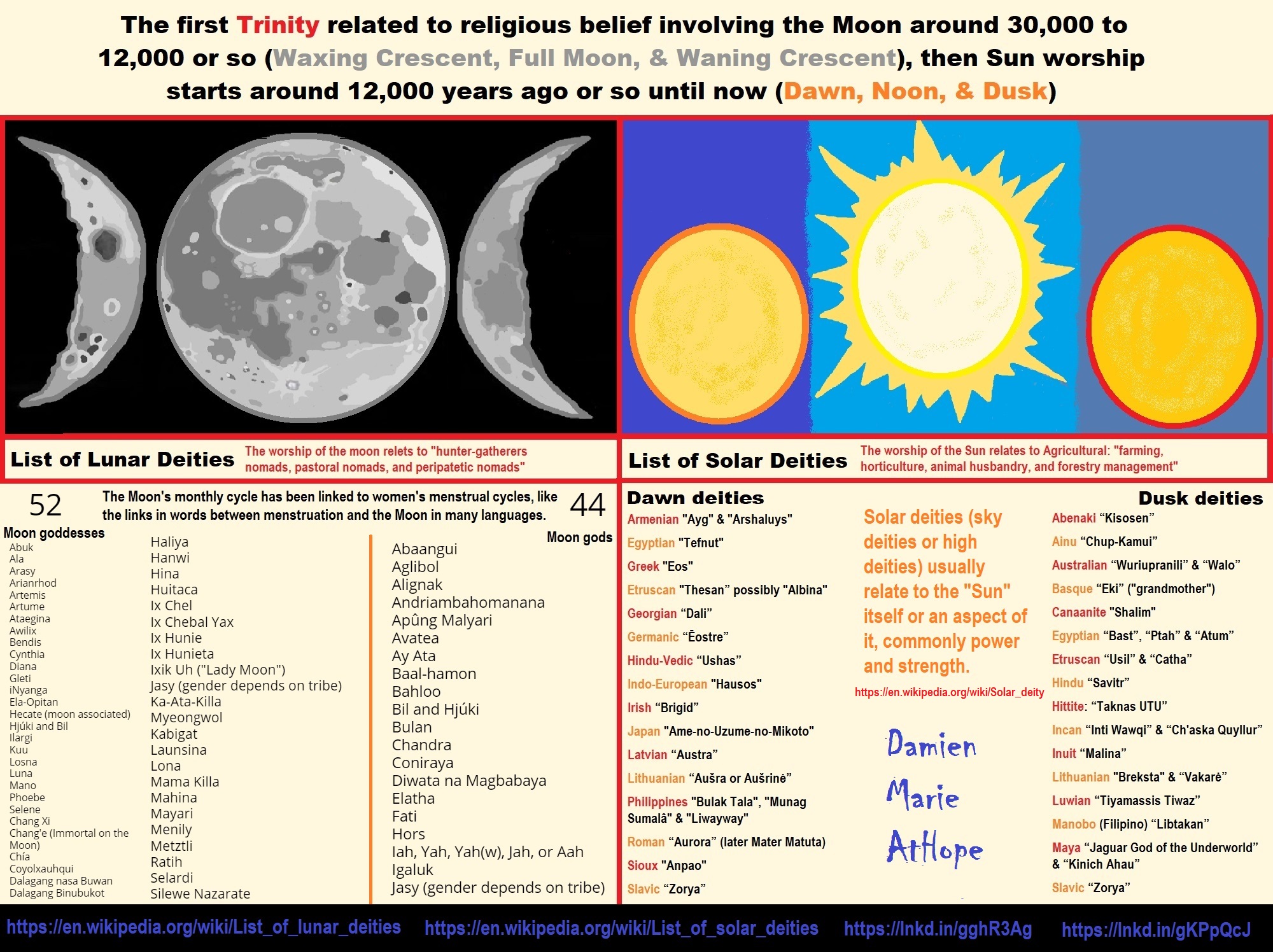
ref, ref, ref, ref, ref, ref, ref
List of Lunar Deities
“In mythology, a lunar deity is a god or goddess of the Moon, sometimes as a personification. These deities can have a variety of functions and traditions depending upon the culture, but they are often related. Some forms of moon worship can be found in most ancient religions. The Moon features prominently in art and literature, often with a purported influence in human affairs. Many cultures are oriented chronologically by the Moon, as opposed to the Sun. The Hindu calendar maintains the integrity of the lunar month and the moon god Chandra has religious significance during many Hindu festivals (e.g. Karwa Chauth, Sankashti Chaturthi, and during eclipses). The ancient Germanic tribes were also known to have a lunar calendar.” ref
“Many cultures have implicitly linked the 29.5-day lunar cycle to women’s menstrual cycles, as evident in the shared linguistic roots of “menstruation” and “moon” words in multiple language families. This identification was not universal, as demonstrated by the fact that not all moon deities are female. Still, many well-known mythologies feature moon goddesses, including the Greek goddess Selene, the Roman goddess Luna, and the Chinese goddess Chang’e. Several goddesses including Artemis, Hecate, and Isis did not originally have lunar aspects, and only acquired them late in antiquity due to syncretism with the de facto Greco-Roman lunar deity Selene/Luna. In traditions with male gods, there is little evidence of such syncretism, though the Greek Hermes has been equated with the male Egyptian lunar god Thoth.” ref
“Male lunar gods are also common, such as Sin of the Mesopotamians, Mani of the Germanic tribes, Tsukuyomi of the Japanese, Igaluk/Alignak of the Inuit, and the Hindu god Chandra. The original Proto-Indo-European lunar deity appears to have been male, with many possible derivatives including the Homeric figure of Menelaus. Cultures with male moon gods often feature sun goddesses. An exception is Hinduism, featuring both male and female aspects of the solar divine. The ancient Egyptians had several moon gods including Khonsu and Thoth, although Thoth is a considerably more complex deity. Set represented the moon in the Egyptian Calendar of Lucky and Unlucky Days.” ref
List of Solar Deities
“A solar deity is a god or goddess who represents the Sun, or an aspect of it, usually by its perceived power and strength. Solar deities and Sun worship can be found throughout most of recorded history in various forms. The following is a list of solar deities. A dawn god or goddess is a deity in a polytheistic religious tradition who is in some sense associated with the dawn. These deities show some relation with the morning, the beginning of the day, and, in some cases, become syncretized with similar solar deities.” ref, ref
“Burial 69 (dorsal decubitus inhumation in the ‘butterfly’ position). Left: the burial with its original covering of stones. Right: after removal of the stones. Photos: Institute of Archaeology, Belgrade.” ref
“Contrary to what you might believe, the oldest evidence of the “lotus pose” does not come from Asia, but from the Mesolithic burials of Lepenski vir culture, modern-day Serbia (9,500 BC). The oldest evidence of Swastika comes from Mezine, Ukraine. It dates to more-less the same period as these burials (10,000 BC).” ref
“Lepenski Vir (Serbian Cyrillic: Лепенски Вир, “Lepena Whirlpool”), located in Serbia, is an important archaeological site of the Mesolithic Iron Gates culture of the Balkans. There is some disagreement about the early start of the settlement and culture of Lepenski Vir. But the latest data suggest 11,500–9,200 to be the start. The late Lepenski Vir 8,300–8,000 years ago architectural development was the development of the Trapezoidal buildings and monumental sculpture. The Lepenski Vir site consists of one large settlement with around ten satellite villages. Numerous piscine sculptures and peculiar architecture have been found at the site. The sculptures of this size so early in human history and original architectural solutions, define Lepenski Vir as the specific and very early phase in the development of the prehistoric culture in Europe. The site is noted for its level of preservation and the overall exceptional quality of the artifacts. Due to the fact that the settlement was a permanent and planned one, with organized human life, architect Hristivoje Pavlović labeled Lepenski Vir as “the first city in Europe”. ref
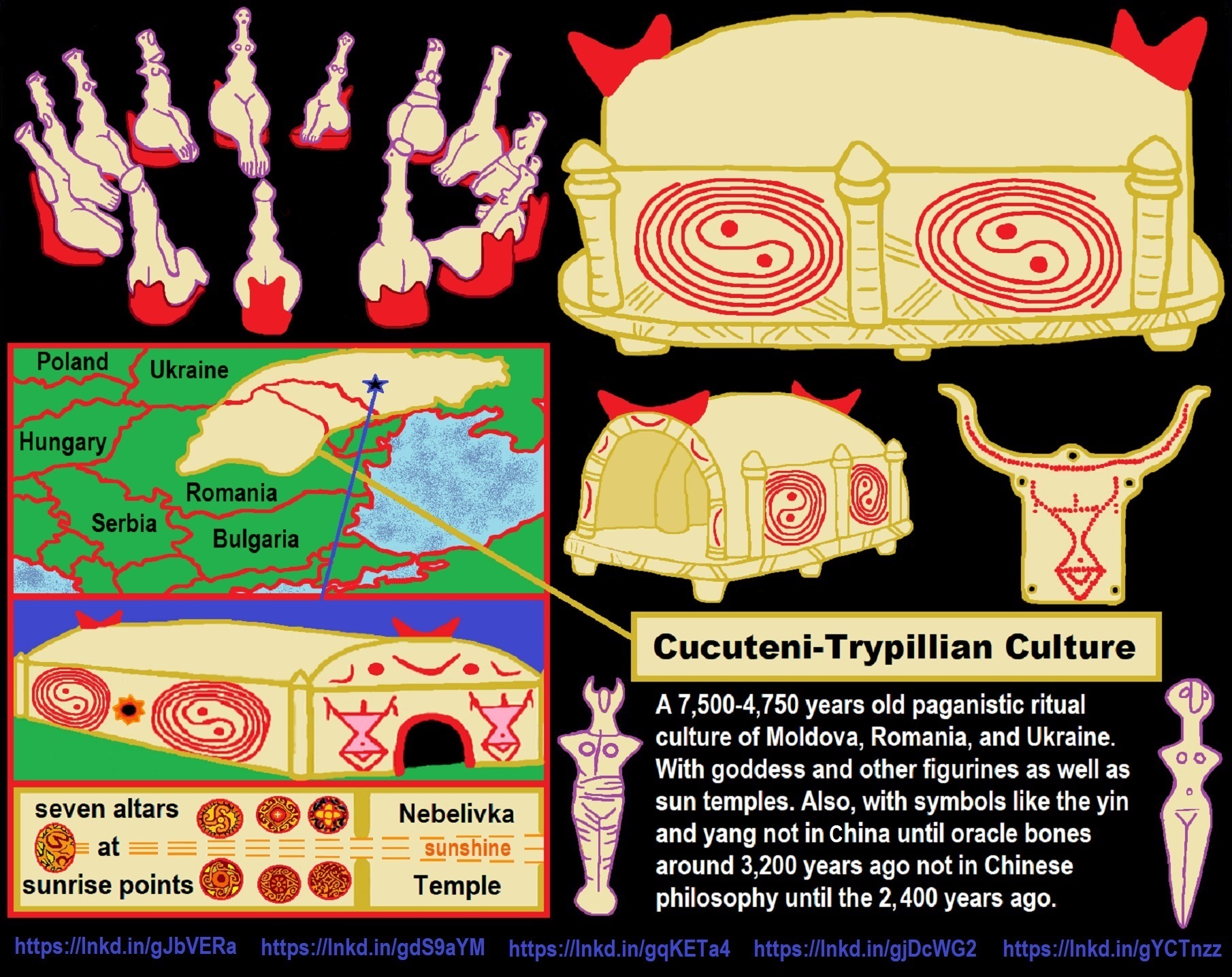
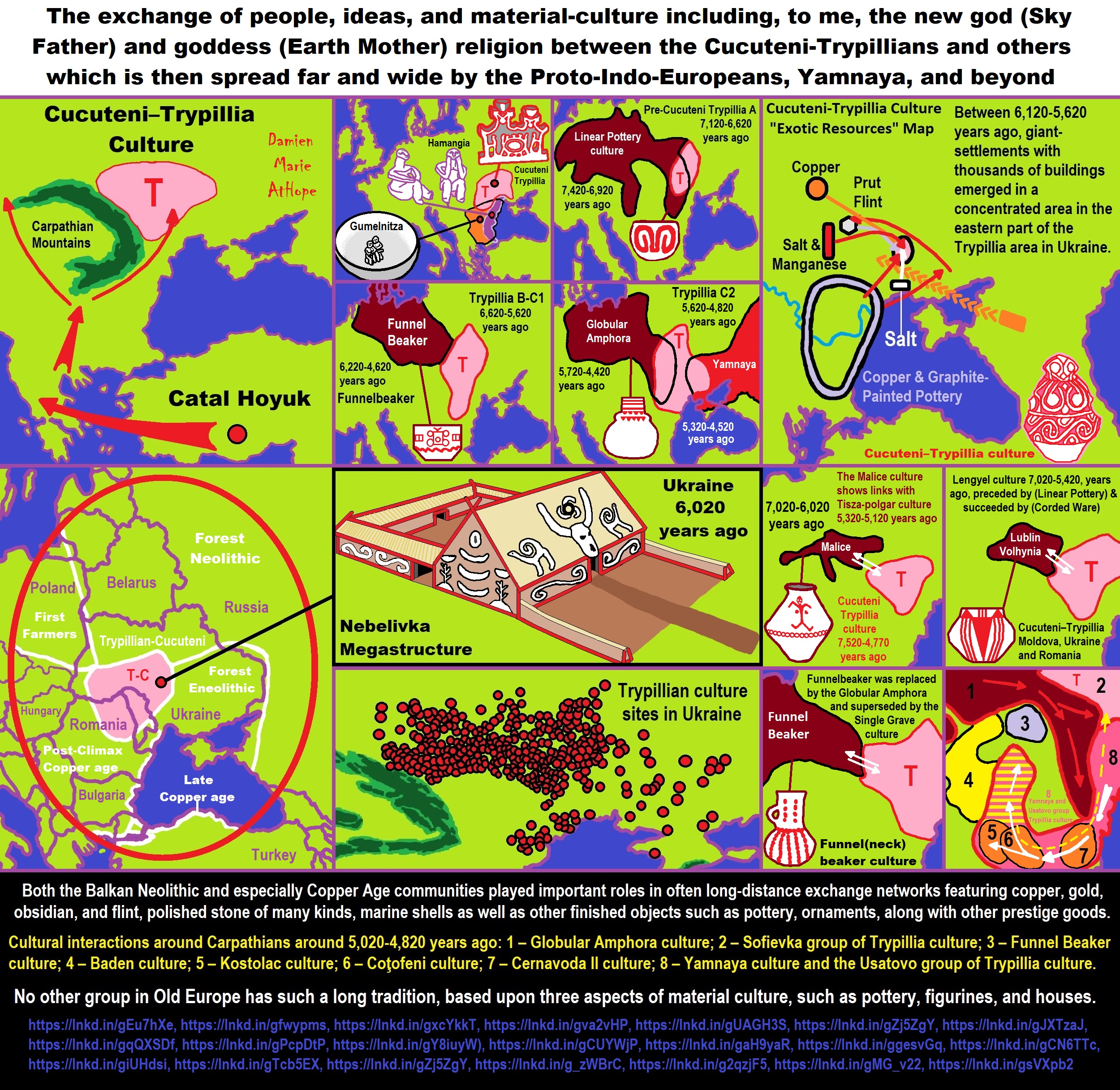
Trypilian temple – observatory at Nebelivka
“The Nebelivka village, Kirovograd region, Ukraine at the territory of one of the largest settlements of Cucuteni-Trypillia civilization dating from 4000 BC archaeologists excavated a building that was unique for its time. According to experts, the building is a Trypillian temple and has no equals in Europe. It had two levels and the area of 20 x 60 meters, that is 1200 m2. The researchers found seven altars made of clay, which had a
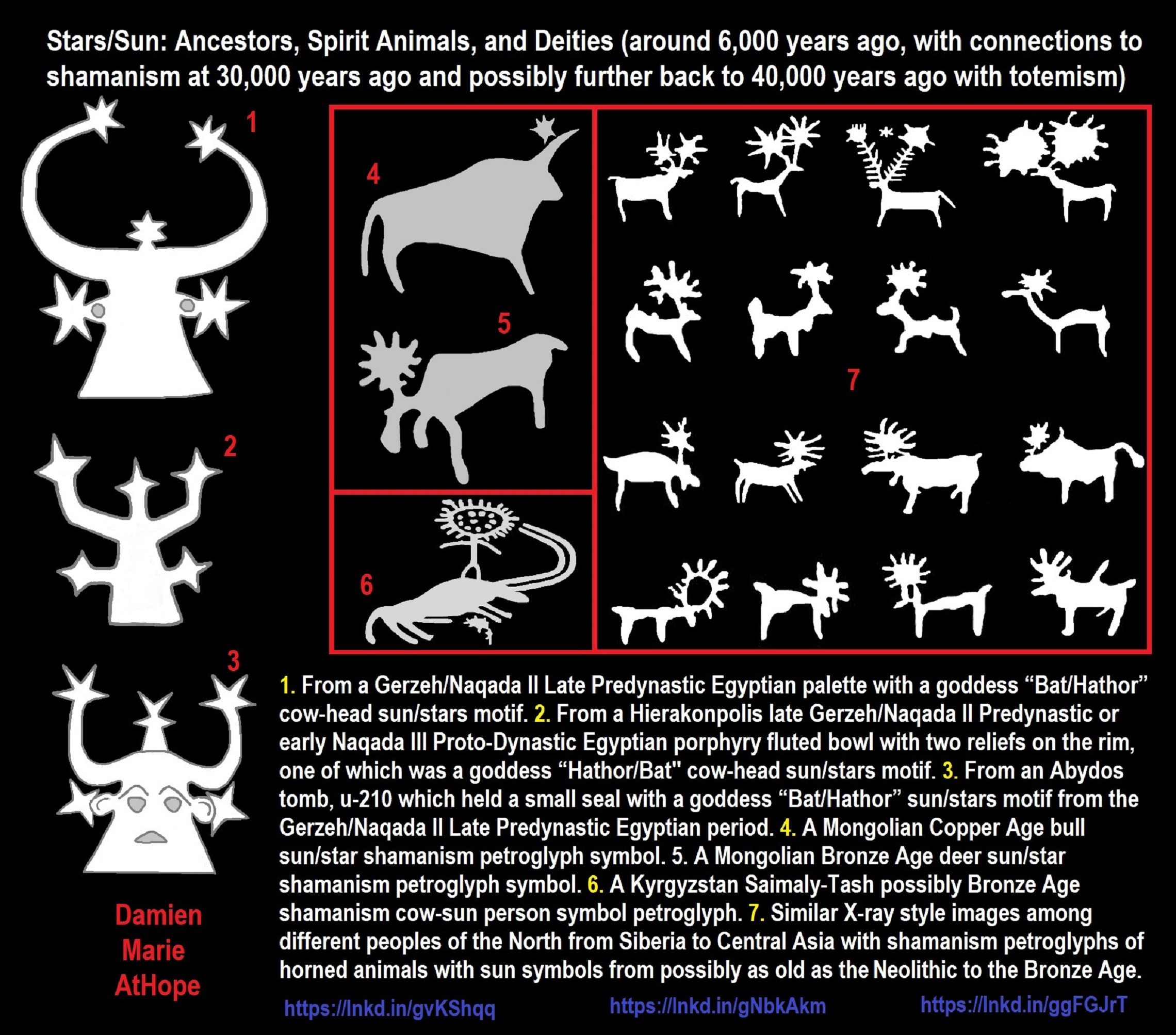
- From a Gerzeh/Naqada II Late Predynastic Egyptian palette with a goddess “Bat/Hathor” cow-head sun/stars motif.
- From a Hierakonpolis late Gerzeh/Naqada II Predynastic or early Naqada III Proto-Dynastic Egyptian porphyry fluted bowl with two reliefs on the rim, one of which was a goddess “Hathor/Bat” cow-head sun/stars motif.
- From an Abydos tomb, u-210 which held a small seal with a goddess “Bat/Hathor” sun/stars motif from the Gerzeh/Naqada II Late Predynastic Egyptian period.
- A Mongolian Copper Age bull sun/star shamanism petroglyph
- A Mongolian Bronze Age deer sun/star shamanism petroglyph symbol.
- A Kyrgyzstan Saimaly-Tash possibly Bronze Age shamanism cow-sun person symbol petroglyph.
- Similar X-ray style images among different peoples of the North from Siberia to Central Asia with shamanism petroglyphs of horned animals with sun symbols from possibly as old as the Neolithic to the Bronze Age. ref, ref, ref

“The Ghassulian Star,” a mysterious 6,000-year-old mural from Jordan;
to me is likely a Proto-Star of Ishtar, Star of Inanna, or Star of Venus
I believe they may be, and to me, thus possibly could have some connections to the central Asain deity Tian which may also be related to Tengri. Goddesses Ishtar/Inanna were worshipped in Sumer at least as early as the Uruk period (6000 – 5,100 years ago). ref
“The Ghassulian Star,” a mysterious 6,000-year-old mural from Jordan. “The Ghassulian Star” was made before people could write, back when everyone either hunted and gathered or lived in small farming villages. The figures were painted with black, brown, red, white, and yellow natural mineral paints; mud and lime walls were the canvas. The painting features a giant star, animals, and masked figures sporting what look a lot like googly eyes. ref
“Ghassulian refers to a culture and an archaeological stage dating to the Middle and Late Chalcolithic Period in the Southern Levant (6,400 – 5,500 years ago). Its type-site, Teleilat Ghassul (Teleilat el-Ghassul, Tulaylat al-Ghassul), is located in the eastern Jordan Valley near the northern edge of the Dead Sea, in modern Jordan.” ref
“The Ghassulian stage was characterized by small hamlet settlements of mixed farming peoples, who had immigrated from the north and settled in the southern Levant – today’s Jordan, Israel, and Palestine. People of the Beersheba Culture (a Ghassulian subculture) lived in underground dwellings – a unique phenomenon in the archaeological history of the region – or in houses that were trapezoid-shaped and built of mud-brick. Those were often built partially underground (on top of collapsed underground dwellings) and were covered with remarkable polychrome wall paintings.” ref
“Their pottery was highly elaborate, including footed bowls and horn-shaped drinking goblets, indicating the cultivation of wine. Several samples display the use of sculptural decoration or of a reserved slip (a clay and water coating partially wiped away while still wet). The Ghassulians were a Chalcolithic culture as they used stone tools but also smelted copper. Funerary customs show evidence that they buried their dead in stone dolmens and also practiced Secondary burial.” ref
“Settlements belonging to the Ghassulian culture have been identified at numerous other sites in what is today southern Israel, especially in the region of Beersheba, where elaborate underground dwellings have been excavated. The Ghassulian culture correlates closely with the Amratian of Egypt and also seems to have affinities (e.g., the distinctive churns, or “bird vases”) with early Minoan culture in Crete.” ref
“Between 5,800 – 5,350 years ago, the Ghassulian culture emerged based on an economy specializing in smelting the copper that Sumerian (Uruk) cities imported from the Southern Levant and the Upper Euphrates. The Ghassulians also erected dolmen monuments, similar to megalithic burial structures found not only in Western Europe, but also in the Western Caucasus. An unexpected link with the Uruk dispersions of the Caucasus has been suggested for the Nahal Mishmar “Cave of the Treasure” discovered in the Judean Desert.” ref
“The fine metalwork discovered in this desert cache includes pieces crafted in a long period 7,000 – 5,500 years ago, as if this cache was buried to protect valuable cultural artifacts (possibly from temple sites) from robbers during the Ubaid-Uruk transition period. Adding to the archaeological mystery, the only comparable metalwork from this period has been discovered far away in the Maykop burial north of the Black Sea. Archaeologists have also suggested Ghassulian contacts with the Aegean and Upper Egypt (Amratian culture), suggesting that these East Mediterranean copper smelters played a dynamic role connecting far-flung cultures.” ref
“Notably, the Ghassulian culture flourished at the time and location some linguists have suggested the Proto-Semitic languages first emerged (approximately 5,750 years ago, probably in the East Mediterranean).5 These later developed to become the Ugaritic, Phoenician, and Hebrew languages spoken not only in Canaan, but also throughout the Mediterranean, Arabian Peninsula, and the Horn of Africa. In Europe, this period was less favorable. The “Old European” civilization of the CBMP dissolved between 5,500 – 5,200 years ago, partly regrouping near the Aegean Sea (preserving the foundations for the seagoing Minoan-Mycenaean civilizations), and some adapting to new pastoral lifeways near the Black Sea (such as the Usatovo culture.” ref
“Despite the centrality of ancient Sumer, early Mesopotamia has rarely been discussed in the context of human genetic structure, and the effects of Sumerian expansions in reshaping the world genetic landscape remain to be discovered. However, the potential of urban centers using new technological toolkits (fueling population growth and giving an early demographic advantage over neighboring Mesolithic societies) suggests that Sumer might have played a formative role in West Eurasian demographic history.” ref
“To help establish a historical foundation for examining the multi-layered genetic structure of the Middle East, this article will outline three phases of Sumerian civilization: (1) Founding of urban settlements during the Ubaid period; (2) Dispersion of Sumerian populations to the Caucasus Mountains and Asia during the Uruk period (including related Kura-Araxes migrations, possibly related to the spread of satem IE languages); and (3) Back-migrations to the Fertile Crescent (in response to events at the periphery of the Sumerian world) during the Middle Bronze Age. Ubaid Period Foundations (8,500 – 5,800 years ago). The foundations of Sumerian civilization were laid during the Ubaid Period (8,500 – 5,800 years ago). In this period, the first Mesopotamian cities were founded, starting with the world’s first capital, Eridu.” ref
“Probably under the guidance of a priestly bureaucratic elite, these settlements were organized in a tripartite hereditary social structure: integrating farm laborers, nomadic pastoralists (animal herders), and hunting-fishing peoples as urban citizens. This urban culture spread outwards to establish a vast “Ubaid horizon” (2,000 km across) between the Mediterranean Sea and the Persian Gulf. The flow of Ubaid material culture stimulated developments in more distant regions. In the Northern Levant, the Ubaid civilization absorbed neighboring Halaf dry farming (non-irrigation) settlements (perhaps Afroasiatic speaking predecessors of the Akkadians and Assyrians).” ref
“Reaching even further beyond these rivers, Ubaid related (Hassuna-Samarra) pottery types and clay artwork have been found throughout the Aegean, Anatolia, and East Mediterranean. According to the archaeologist Marija Gimbutas, these shared craft forms appeared simultaneously in Southeastern Europe and West Asia around 8,700 – 8,500 years ago. Map of West Eurasian cultures during the Ubaid period. Sumer (the Ubaid heartland) is highlighted in red. Possible language families in neighboring areas are listed in italics. In Europe, this Ubaid related material culture was the basis of what Gimbutas dubbed the “Old European” civilization of the Balkan Peninsula and Central Europe, later splitting into local variant traditions around 7,000 years ago.” ref
“More recently, Evgeny Chernykh has documented evidence for a large Carpatho-Balkan Metallurgical Province composed of densely settled communities (of up to 15,000 people each) connected by shared copper technology. This network of settlements flourished between 7,500 – 5,500 years ago, before dissolving around 5,200 years ago. In the later part of the Ubaid period, another peripheral Copper Age culture emerged in South Asia: the Mehrgarh III or Togau Phase (6,300 – 5,800 years ago) that brought an influx of new collective burial customs, ceramic styles, and copper technology (possibly from West Asia).” ref
“Other cultural centers that emerged during the Ubaid period included Nabta Playa in Africa, possibly constructed by early populations of the “Green Sahara” (Neolithic Subpluvial; 9,000 – 5,500 years ago), when the landscape of Northern Africa resembled the ecologically rich savannahs of present-day Kenya, and the Badarian and Amratian (Predynastic Upper Egyptian) cultures emerged along the Nile River. Because of their “early adopter” status, these dense Ubaid period settlements in Mesopotamia, Southeastern Europe, and South Asia potentially played a key role in shaping later demographic history.” ref
“The Kurgan Culture and the Indo-Europeanization of Europe considered the Chalcolithic “Old European” civilization pre-IE and suggested that the Proto-Indo-European (IE) languages emerged only later with “Kurgan” culture of the Eurasian steppe. However, this article suggests instead that the Proto-Indo-European language emerged in Ubaid period Southeastern Europe (possibly derived from older West Asian Indo-Hittite languages), later diverging into Eurasian satem and Mediterranean centum IE varieties after the collapse of the CBMP around 5,200 years ago.” ref
“This would be consistent with linguistic evidence for PIE origins around 6,000 years ago and early contacts with the Uralic (North Eurasian), Caucasian (West Asian), and Afroasiatic (East Mediterranean) languages in West Eurasia. However, it is probable that no modern culture fully represents these ancestral founding populations. Nevertheless, traces of this ancestral population structure might to some extent be preserved in West Asian populations with a tradition of endogamy (such as Assyrian Christians, Druze, etc.). However, ancient DNA would be needed to examine these relationships in more detail.” ref

ref, ref, ref, ref, ref, ref, ref, ref, ref, ref, ref, ref, ref, ref, ref, ref, ref
“The shaman is, above all, a connecting figure, bridging several worlds for his people, traveling between this world, the underworld, and the heavens. He transforms himself into an animal and talks with ghosts, the dead, the deities, and the ancestors. He dies and revives. He brings back knowledge from the shadow realm, thus linking his people to the spirits and places which were once mythically accessible to all.–anthropologist Barbara Meyerhoff” ref
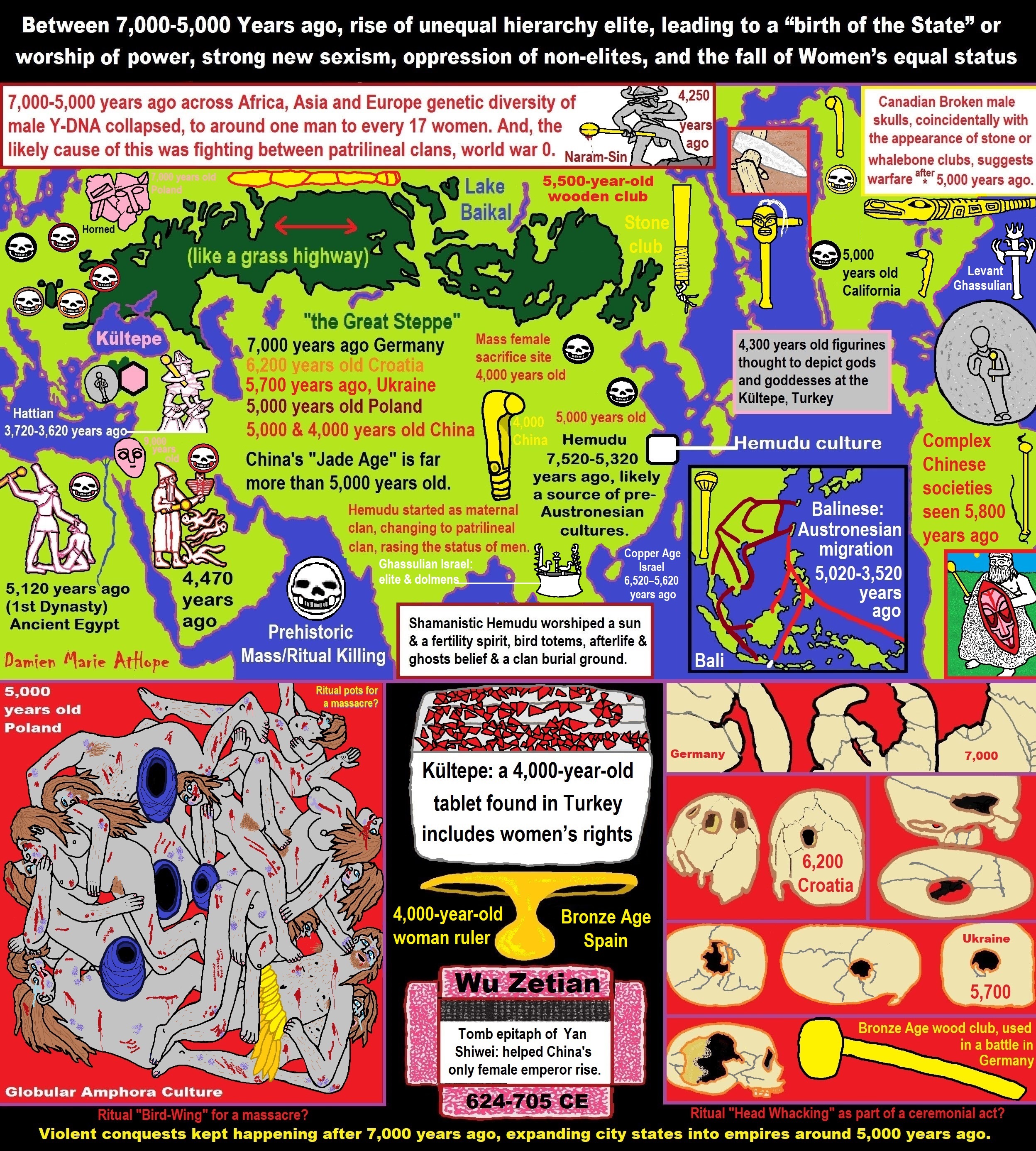
ref, ref, ref, ref, ref, ref, ref, ref, ref, ref, ref, ref, ref, ref, ref, ref, ref, ref, ref, ref, ref, ref, ref, ref, ref, ref, ref, ref, ref, ref, ref, ref, ref, ref, ref, ref, ref, ref, ref, ref, ref, ref, ref, ref, ref, ref, ref, ref, ref, ref, ref, ref, ref, ref, ref, ref, ref, ref, ref, ref, ref, ref, ref, ref, ref, ref, ref, ref, ref, ref, ref, ref, ref, ref, ref, ref, ref, ref, ref, ref, ref, ref, ref, ref, ref, ref, ref, ref, ref, ref
DNA evidence expresses waves of migration from Anatolia and the Zagros mountains (today’s Turkey and Iran) to the Levant helped develop the Chalcolithic culture that existed in Israel’s Upper Galilee region some 6,500 years ago. ref
“After 10 years of research, we understand that Anatolia/Turkey, especially from the west, is part of the basis of all European peoples. Matching how all European cattle are all descended from Iranian cattle dispersed by farmer herders leaving Anatolia/Turkey.” – Joachim Burger – Anthropologist & Population Geneticist Johannes Gutenberg University, Mainz https://www.youtube.com/watch?v=I2vYr6gx56o&t=651s
The Levant which may refer to Isreal in a common use way generally includes Cyprus, Syria, Israel, Jordan, Lebanon, Palestine, and the Northern Sinai Peninsula.

Seated Woman of Çatalhöyük
“The Seated Woman of Çatalhöyük (also Çatal Höyük) is a baked-clay, nude female form, seated between feline-headed arm-rests. It is generally thought to depict a corpulent and fertile Mother goddess in the process of giving birth while seated on her throne, which has two hand rests in the form of feline (lioness, leopard, or panther) heads in a Mistress of Animals motif. The statuette, one of several iconographically similar ones found at the site, is associated to other corpulent prehistoric goddess figures, of which the most famous is the Venus of Willendorf. It is a neolithic sculpture shaped by an unknown artist, and was completed in approximately 6000 BCE.” ref
Kubaba
“Kubaba is the only queen on the Sumerian King List, which states she reigned for 100 years – roughly in the Early Dynastic III period (ca. 2500–2330 BCE) of Sumerian history. A connection between her and a goddess known from Hurro–Hittite and later Luwian sources cannot be established on the account of spatial and temporal differences. Kubaba is one of very few women to have ever ruled in their own right in Mesopotamian history. Most versions of the king list place her alone in her own dynasty, the 3rd Dynasty of Kish, following the defeat of Sharrumiter of Mari, but other versions combine her with the 4th dynasty, that followed the primacy of the king of Akshak. Before becoming monarch, the king list says she was an alewife, brewess or brewster, terms for a woman who brewed alcohol.” ref
“Kubaba was a Syrian goddess associated particularly closely with Alalakh and Carchemish. She was adopted into the Hurrian and Hittite pantheons as well. After the fall of the Hittite empire, she continued to be venerated by Luwians. A connection between her and the similarly named legendary Sumerian queen Kubaba of Kish, while commonly proposed, cannot be established due to spatial and temporal differences. Emmanuel Laroche proposed in 1960 that Kubaba and Cybele were one and the same. This view is supported by Mark Munn, who argues that the Phrygian name Kybele developed from Lydian adjective kuvavli, first changed into kubabli and then simplified into kuballi, and finally kubelli. However, such an adjective is a purely speculative construction.” ref
Cybele
“Cybele (Phrygian: “Kubileya/Kubeleya Mother”, perhaps “Mountain Mother”) is an Anatolian mother goddess; she may have a possible forerunner in the earliest neolithic at Çatalhöyük, where statues of plump women, sometimes sitting, have been found in excavations. Phrygia‘s only known goddess, she was probably its national deity. Greek colonists in Asia Minor adopted and adapted her Phrygian cult and spread it to mainland Greece and to the more distant western Greek colonies around the 6th century BCE. In Greece, Cybele met with a mixed reception. She became partially assimilated to aspects of the Earth-goddess Gaia, of her possibly Minoan equivalent Rhea, and of the harvest–mother goddess Demeter. Some city-states, notably Athens, evoked her as a protector, but her most celebrated Greek rites and processions show her as an essentially foreign, exotic mystery-goddess who arrives in a lion-drawn chariot to the accompaniment of wild music, wine, and a disorderly, ecstatic following.” ref
“Uniquely in Greek religion, she had a eunuch mendicant priesthood. Many of her Greek cults included rites to a divine Phrygian castrate shepherd-consort Attis, who was probably a Greek invention. In Greece, Cybele became associated with mountains, town and city walls, fertile nature, and wild animals, especially lions. In Rome, Cybele became known as Magna Mater (“Great Mother”). The Roman State adopted and developed a particular form of her cult after the Sibylline oracle in 205 BCE recommended her conscription as a key religious ally in Rome’s second war against Carthage (218 to 201 BCE). Roman mythographers reinvented her as a Trojan goddess, and thus an ancestral goddess of the Roman people by way of the Trojan prince Aeneas. As Rome eventually established hegemony over the Mediterranean world, Romanized forms of Cybele’s cults spread throughout Rome’s empire. Greek and Roman writers debated and disputed the meaning and morality of her cults and priesthoods, which remain controversial subjects in modern scholarship.” ref
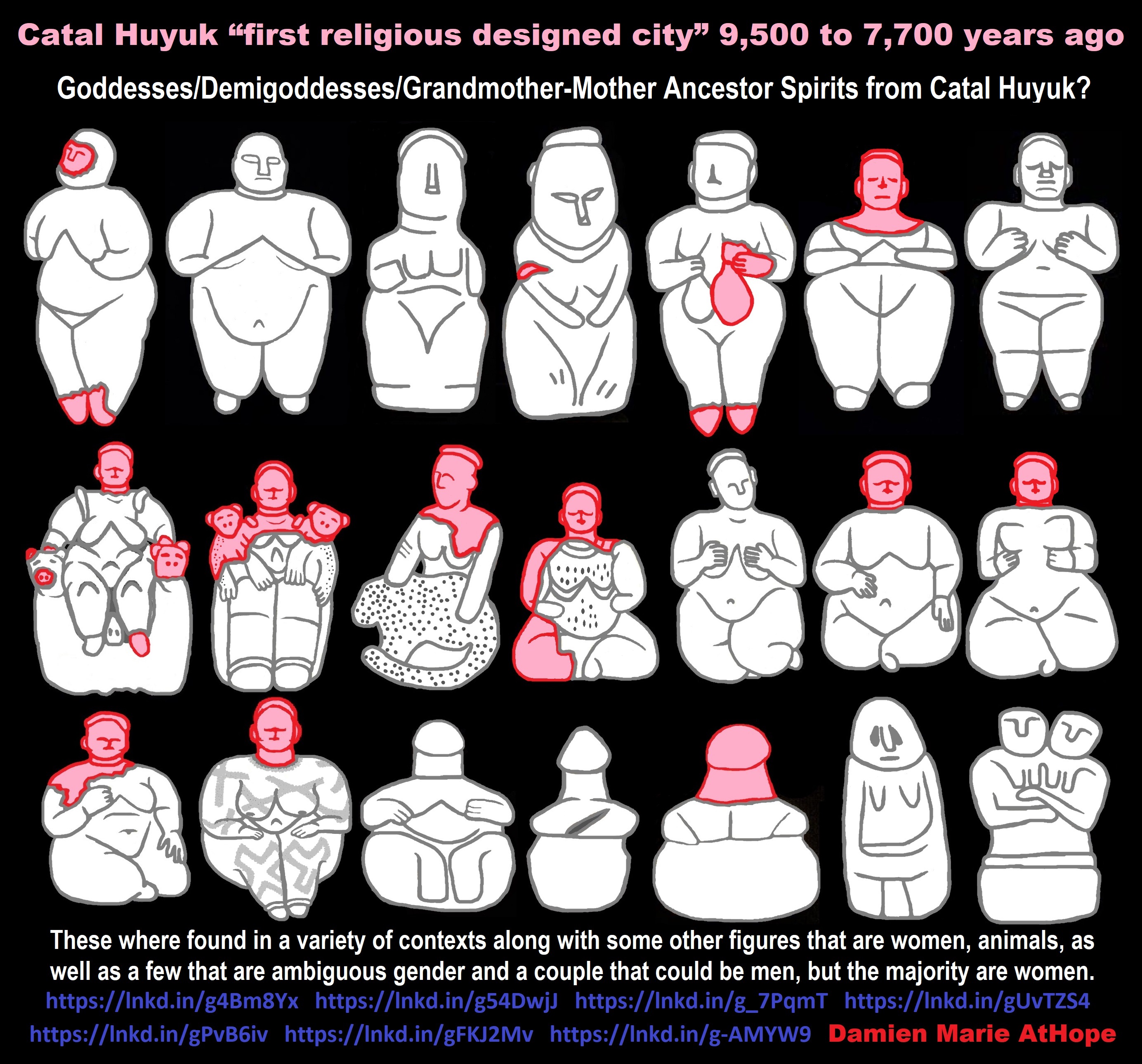
“A bit more than 8000 years ago, the world suddenly cooled, leading to much drier summers for much of the Northern Hemisphere. Massive glacial lakes in North America emptied into the Atlantic Ocean, scientists believe, altering sea currents and weather patterns and triggering what’s known simply as the 8.2 kiloyear event (referring to its occurrence 8200 years ago). The impact on early farmers must have been extreme, yet archaeologists know little about how they endured. Now, the remains of animal fat on broken pottery from one of the world’s oldest and most unusual protocities—known as Çatalhöyük—is finally giving scientists a window into these ancient peoples’ close call with catastrophe. Extreme drought brought on by the 8.2-kiloyear event would have frizzled feed crops and grazing lands, and cooler winters would have increased animals’ food requirements. The combined effect would have been leaner, thirstier livestock, and their fat may have recorded chemical echoes of that dietary stress.” ref
“Çatalhöyük’s farmers left behind any trace of the climate shift. Over the past few years, Marciniak had been digging up fragments of clay pottery (or potsherds) left buried in ancient trash piles, and clay pots were used to store meat, and researchers found relatively well-preserved animal fat residue soaked into the porous, unglazed sherds. dating from about 8300 to 7,900 years ago. Additional finds from Çatalhöyük reveal how the farmers adapted to the cooler, drier conditions. Animal bones from that time have a relatively high number of cut marks, suggesting they were butchering for every last edible bit. Cattle herds shrunk while goat herds rose, the authors note, perhaps because goats could better handle drought. Çatalhöyük’s architecture changed, as well, with the site’s iconic, large, communal dwellings giving way to smaller houses for individual families, reflecting a shift toward independent, self-sufficient households. It seems that Çatalhöyük was already in a period of fairly rapid change well before the 8.2-kiloyear event, as Çatalhöyük’s architecture had been gradually evolving for hundreds of years before.” ref
Catal Huyuk “first religious designed city” “involves a 34-acre site in central Turkey, at one time inhabited by as many as 8,000 to 10,000 people, began some 9,500 years ago, and continuing for nearly two millennia, people came together at Çatalhöyük to build hundreds of tightly clustered mud-brick houses, burying their dead beneath the floors and adorning the walls with paintings, livestock skulls and plaster reliefs. More than 8,000 years ago, Çatalhöyük was already a city of one-room homes, accessed from the roof. Places of worship often featured bucrania (displaying sacrificial bulls, and the ritual/decorative use of bull’s horns. People in Çatalhöyük were quite equal, but it might not have been the nicest society as residents had to submit to a lot of social control and that such a society only works with strong homogeneity.” ref
“For many generations, it was very unacceptable for individual households to accumulate [wealth]. Once they started to do so, there is evidence that more problems started to arise. Some of the new evidence expresses something odd about one of the hundreds of skulls dozens of them with similar wounds, all showing a consistent pattern of injury to the top back of the skull. It is believed that the pattern of the wounds suggests that most of them were inflicted by thrown projectiles, but all of them were healed, meaning they were not fatal.” They speculate that the attacks that caused the injuries were meant only to stun, perhaps to control wayward members of the group, or to abduct outsiders as wives or slaves. Moreover, the skulls with this characteristic were found primarily in later levels of the site, when more independence and differentiation between households started to emerge. Presumably, it is with these new inequalities could have potentially created new tensions among the community’s members, non-fatal violence to diffuse full-fledged conflicts that could break the settlement apart, in a way, confirm the idea of an emerging controlled society.” ref
5th millennium BC (around 7,000-6,000 years ago) Events
This was a time of great development along with the spread of agriculture from Western Asia throughout Southern and Central Europe. Urban cultures in Mesopotamia and Anatolia flourished, developing the wheel. Copper ornaments became more common, marking the beginning of the Chalcolithic. Animal husbandry spread throughout Eurasia, reaching China. World population grew slightly throughout the millennium, possibly from 5 to 7 million people. ref
Inventions, discoveries, introductions
- Farming reaches Atlantic coast of Europe from Ancient Near East (around 7,000 years ago)
- Maize is cultivated in Mexico (around 7,000 years ago)
- Proto-writing, such as ideographic Vinča symbols, Tartaria tablets (around 7,000 years ago)
- around 7,000 years ago, Metallurgy during the Copper Age in Europe
- around 7,000 years ago, agriculture starts in Ancient Japan; beans and gourds are cultivated
- Plough is introduced in Europe (around 6,500 years ago)
- Copper pins dating to around 6,000 years ago found in Egypt
- Water buffalo are domesticated in China
- Beer brewing is developed
- Wheel is developed in Mesopotamia and India. ref
Catal Huyuk “first religious designed city” around 9,500 to 7,700 years ago (Turkey)
Fertile Crescent
- Ubaid culture around 8,500 – 5,800 tears ago in Mesopotamia, derives from Tell al-`Ubaid
- Yumuktepe and Gözlükule cultures in south Anatolia/Turkey. ref
- 1. (Yumuktepe had 23 archaeological levels of occupation dating from ca 6300 BC. In his book, Prehistoric Mersin, Garstang lists the tools unearthed in the excavations. The earliest tools are made of either stone or ceramic. Both agriculture and animal husbandry (sheep, cattle, goats, and pigs) were among the economic activities in Yumuktepe. In the layer which corresponds to roughly 4500 BC, one of the earliest fortifications in human history exists. According to Isabella Caneva, during the chalcolithic age, an early copper blast furnace was in use in Yumuktepe. ref)
- 2. (Gözlükule Höyüğü is located to the south of the Gülek Bosphorus, which passes through the Taurus Mountains in Çukurova (ancient Cilicia), located on the northeastern shore of the Mediterranean. The site Gözlü Kule is the ancient city of Tarsus, the Hittite Terussa or Tarsa dating to around 5,000 years ago, the with monumental buildings, houses, and Northern Syria characteristic potteries. Towards 4,500 years ago, aligned houses and streets intersecting at right angles resemble those of the Minoans. Some destructions are observed from 4,400 years ago culminating in the construction of a fortified wall and the potteries and jewelry are similar to what has been found to Troy. During 4,100 years ago, further destruction are observed. The characteristics of the occupants of the houses appear, again, be those of Syria. Under the Hittites (dated to around 3,600 – 3,178 years ago), Tarsus is a major town or even the regional capital. 65 seals or seals footprints, Hittite hieroglyphics, were found. Fragments of alabaster and lapis lazuli, gold work molds and a statuette attest of the prosperity of the city. Many specialists think, on the base of these excavations, that Tarsus was a local capital. ref, ref)
- “The earliest representations of culture in Anatolia were Stone Age artifacts. The remnants of Bronze Age civilizations such as the Hattian, Akkadian, Assyrian, and Hittite peoples provide us with many examples of the daily lives of its citizens and their trade. After the fall of the Hittites, the new states of Phrygia and Lydia stood strong on the western coast as Greek civilization began to flourish. They, and all the rest of Anatolia were relatively soon after incorporated into the Achaemenid Persian Empire.” ref
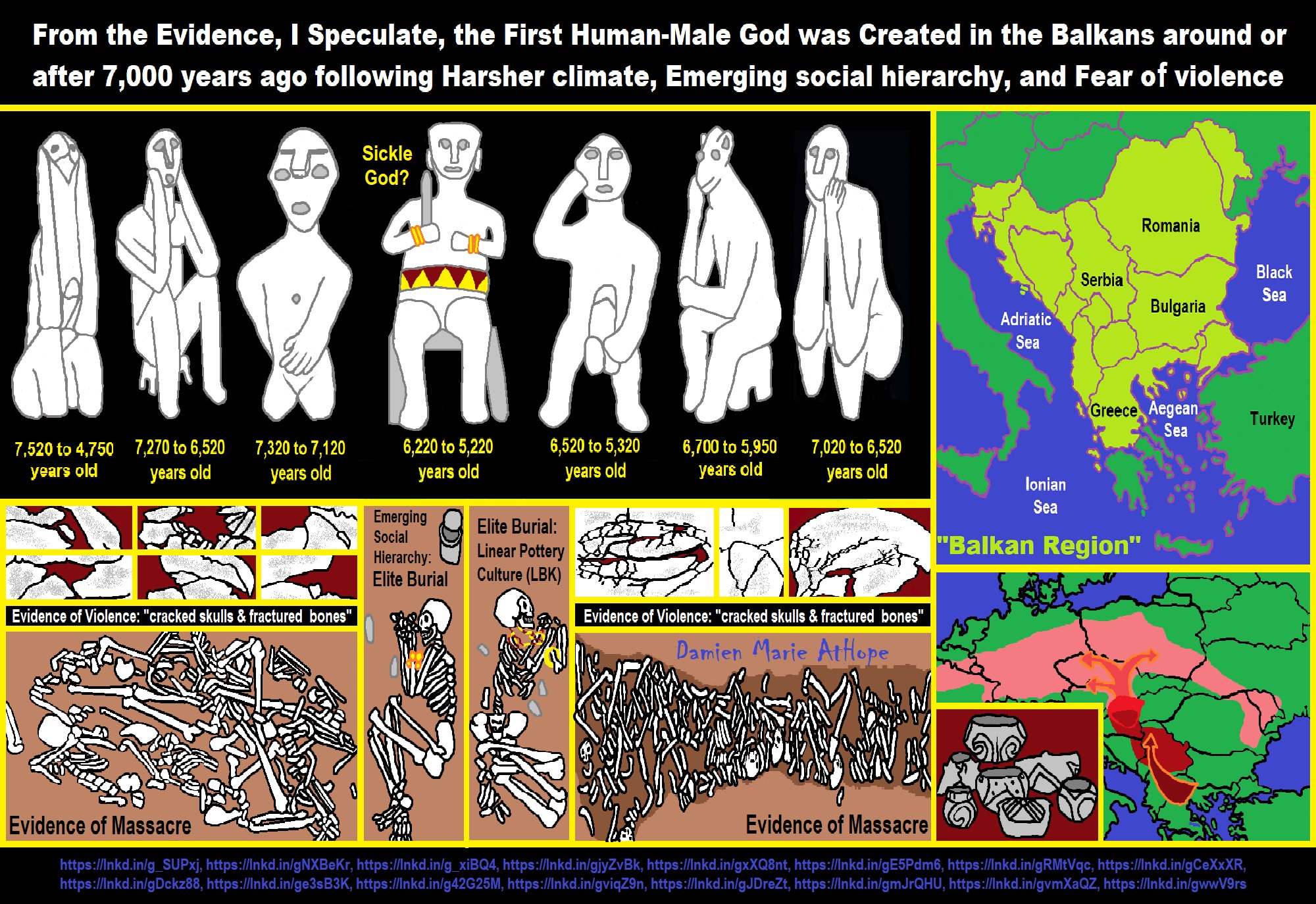

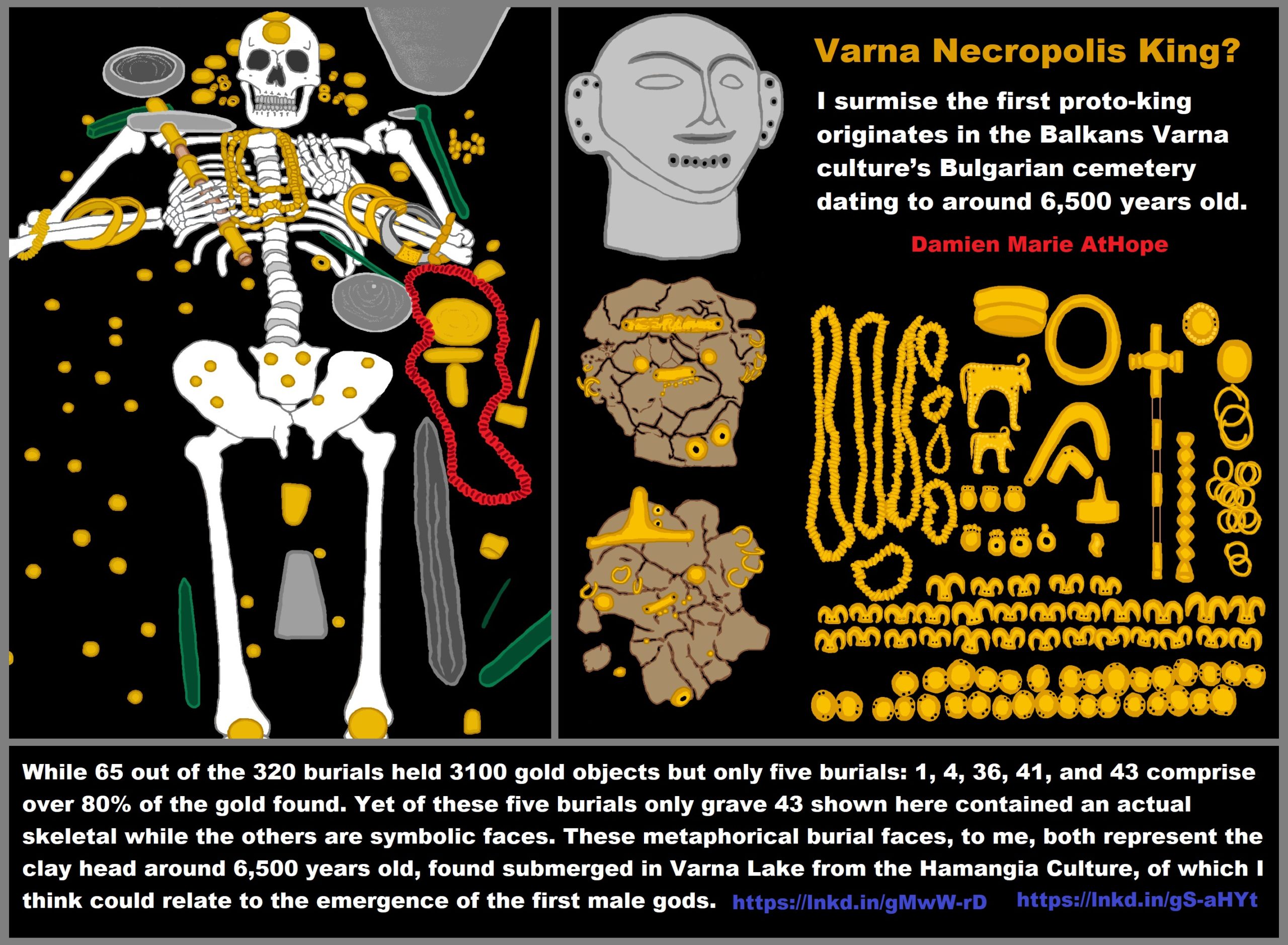



If you are a religious believer, may I remind you that faith in the acquisition of knowledge is not a valid method worth believing in. Because, what proof is “faith”, of anything religion claims by faith, as many people have different faith even in the same religion?
Religions continuing in our modern world, full of science and facts, should be seen as little more than a set of irrational conspiracy theories of reality. Nothing more than a confused reality made up of unscientific echoes from man’s ancient past. Rational thinkers must ask themselves why continue to believe in religions’ stories. Religion myths which are nothing more than childlike stories and obsolete tales once used to explain how the world works, acting like magic was needed when it was always only nature. These childlike religious stories should not even be taken seriously, but sadly too often they are.
Often without realizing it, we accumulate beliefs that we allow to negatively influence our lives. In order to bring about awareness, we need to be willing to alter skewed beliefs. Rational thinkers must examine the facts instead of blindly following beliefs or faith. Below is a collection of researched information such as archaeology, history, linguistics, genetics, art, science, sociology, geography, psychology, philosophy, theology, biology, and zoology. It will make you question your beliefs with information, inquiries, and ideas to ponder and expand on. The two main goals are to expose the evolution of religion starting by around 100,000 years ago and to offer challenges to remove the rationale of faith. It is like an intervention for belief in myths that have plagued humankind for way too long. We often think we know what truth is nevertheless this can be but a vantage point away from losing credibility if we are not willing to follow valid and reliable reason and evidence.
The door of reason opens not once but many times. Come on a journey to free thought where the war is against ignorance and the victor is a rational mind. Understanding Religion Evolution: Pre-Animism (at least 300,000 years ago), * Animism (such as that seen in Africa: 100,000 years ago), *Totemism (Europe: 50,000 years ago), * Shamanism (beginning around 30,000 years ago), *Paganism (beginning around 12,000 years ago), * Progressed organized religion (around 5,000 years ago), * CURRENT “World” RELIGIONS (after 4,000 years ago), and * Early Atheistic Doubting (at least by around 2,600 Years Ago)
#Israel #Jordan #Paganism #Archaeology #Anthropology #Religion
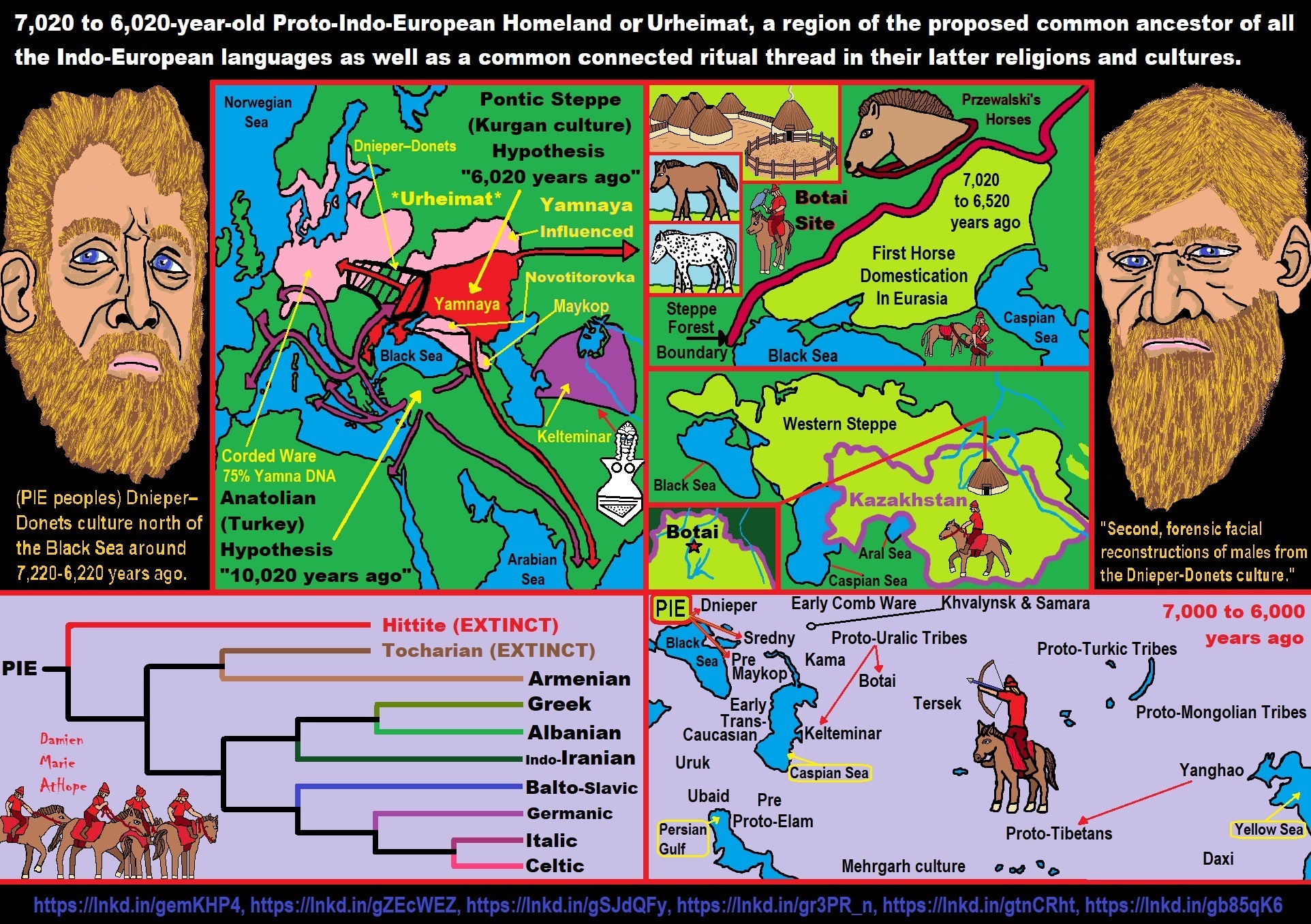
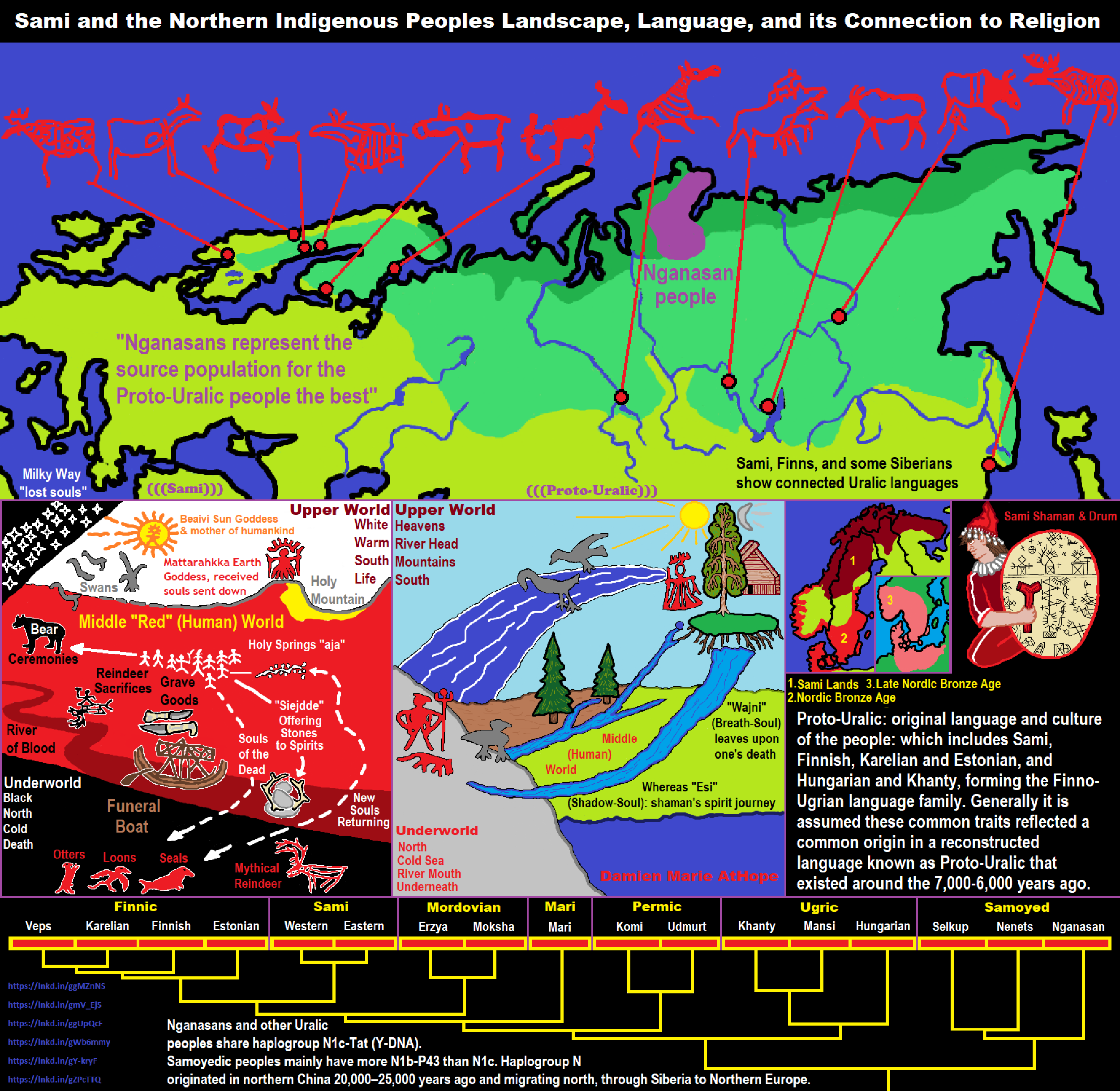
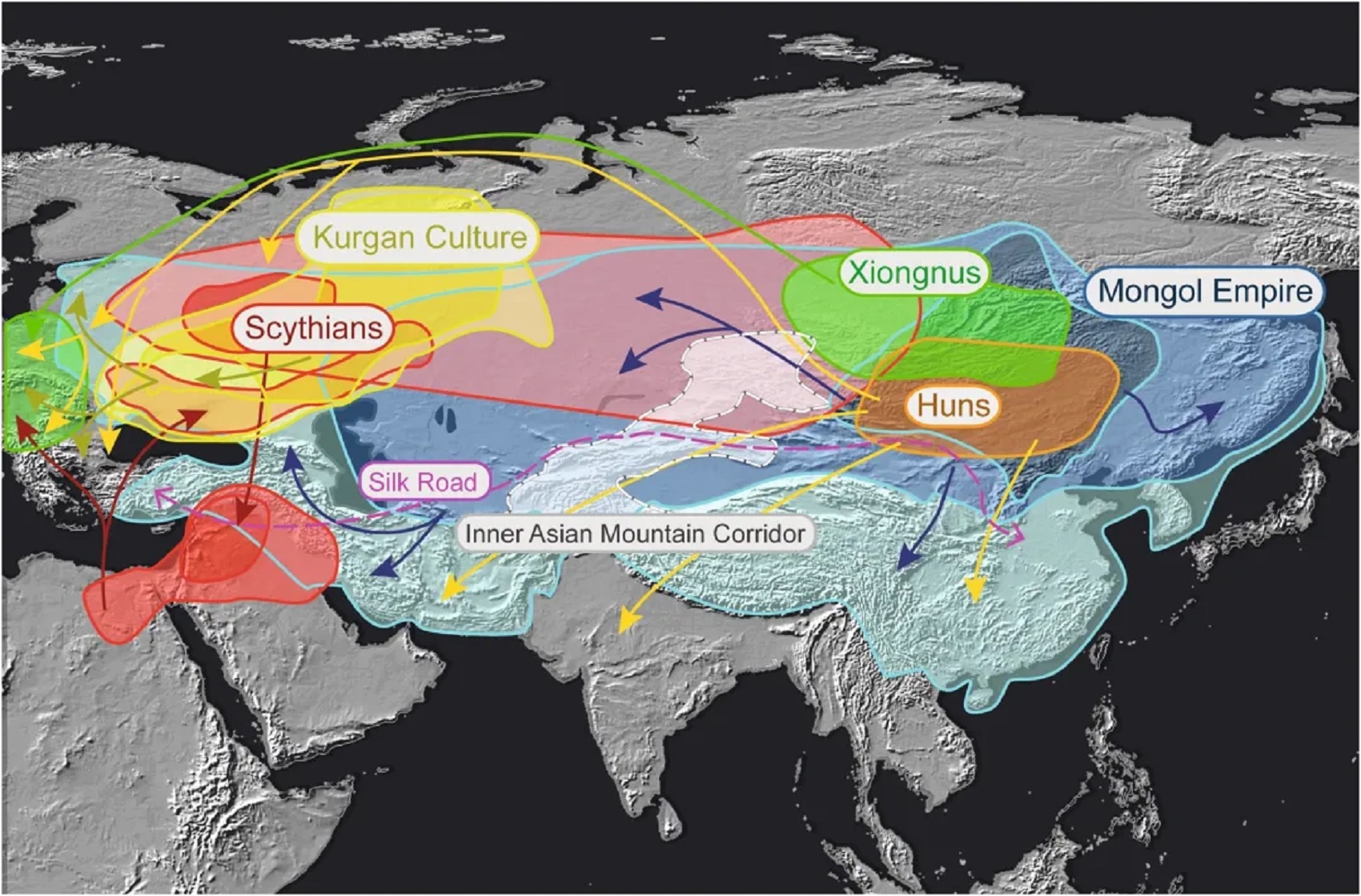


ref, ref, ref, ref, ref, ref, ref, ref, ref, ref, ref, ref, ref
By day the LORD went ahead of them in a pillar of cloud to guide them on their way and by night in a pillar of fire to give them light, so that they could travel by day or night.
- By day the “Bible God” was in a cloud pillar.
By night the “Bible God” was in a fire pillar.
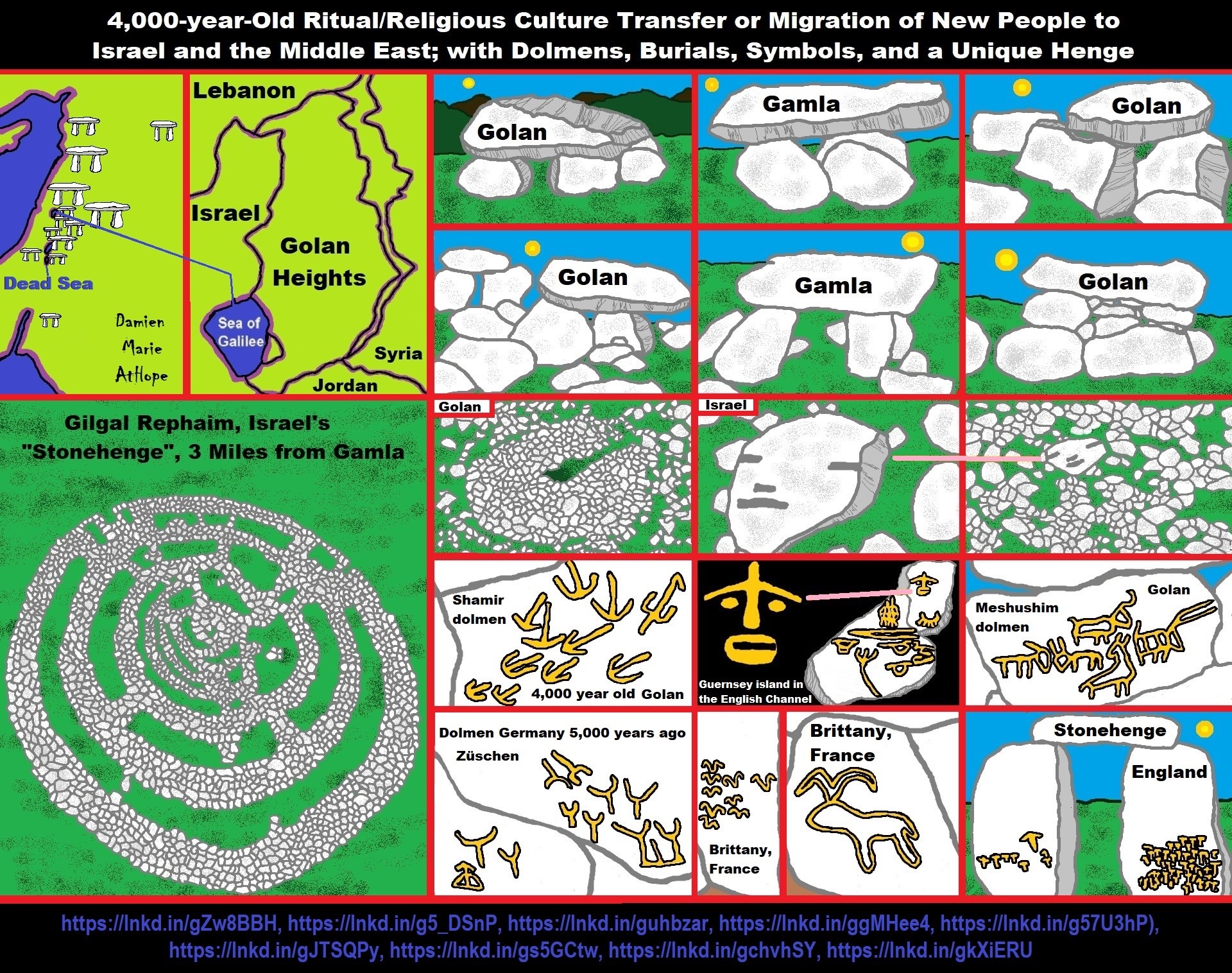


Animism: Respecting the Living World by Graham Harvey
“How have human cultures engaged with and thought about animals, plants, rocks, clouds, and other elements in their natural surroundings? Do animals and other natural objects have a spirit or soul? What is their relationship to humans? In this new study, Graham Harvey explores current and past animistic beliefs and practices of Native Americans, Maori, Aboriginal Australians, and eco-pagans. He considers the varieties of animism found in these cultures as well as their shared desire to live respectfully within larger natural communities. Drawing on his extensive casework, Harvey also considers the linguistic, performative, ecological, and activist implications of these different animisms.” ref

My thoughts on Religion Evolution with external links for more info:
- (Pre-Animism Africa mainly, but also Europe, and Asia at least 300,000 years ago), (Pre-Animism – Oxford Dictionaries)
- (Animism Africa around 100,000 years ago), (Animism – Britannica.com)
- (Totemism Europe around 50,000 years ago), (Totemism – Anthropology)
- (Shamanism Siberia around 30,000 years ago), (Shamanism – Britannica.com)
- (Paganism Turkey around 12,000 years ago), (Paganism – BBC Religion)
- (Progressed Organized Religion “Institutional Religion” Egypt around 5,000 years ago), (Ancient Egyptian Religion – Britannica.com)
- (CURRENT “World” RELIGIONS after 4,000 years ago) (Origin of Major Religions – Sacred Texts)
- (Early Atheistic Doubting at least by 2,600 years ago) (History of Atheism – Wikipedia)
“Religion is an Evolved Product” and Yes, Religion is Like Fear Given Wings…
Atheists talk about gods and religions for the same reason doctors talk about cancer, they are looking for a cure, or a firefighter talks about fires because they burn people and they care to stop them. We atheists too often feel a need to help the victims of mental slavery, held in the bondage that is the false beliefs of gods and the conspiracy theories of reality found in religions.
Understanding Religion Evolution:
- Pre-Animism (at least 300,000 years ago)
- Animism (Africa: 100,000 years ago)
- Totemism (Europe: 50,000 years ago)
- Shamanism (Siberia: 30,000 years ago)
- Paganism (Turkey: 12,000 years ago)
- Progressed organized religion (Egypt: 5,000 years ago), (Egypt, the First Dynasty 5,150 years ago)
- CURRENT “World” RELIGIONS (after 4,000 years ago)
- Early Atheistic Doubting (at least by 2,600 years ago)
“An Archaeological/Anthropological Understanding of Religion Evolution”
It seems ancient peoples had to survived amazing threats in a “dangerous universe (by superstition perceived as good and evil),” and human “immorality or imperfection of the soul” which was thought to affect the still living, leading to ancestor worship. This ancestor worship presumably led to the belief in supernatural beings, and then some of these were turned into the belief in gods. This feeble myth called gods were just a human conceived “made from nothing into something over and over, changing, again and again, taking on more as they evolve, all the while they are thought to be special,” but it is just supernatural animistic spirit-belief perceived as sacred.
Quick Evolution of Religion?
Pre-Animism (at least 300,000 years ago) pre-religion is a beginning that evolves into later Animism. So, Religion as we think of it, to me, all starts in a general way with Animism (Africa: 100,000 years ago) (theoretical belief in supernatural powers/spirits), then this is physically expressed in or with Totemism (Europe: 50,000 years ago) (theoretical belief in mythical relationship with powers/spirits through a totem item), which then enlists a full-time specific person to do this worship and believed interacting Shamanism (Siberia/Russia: 30,000 years ago) (theoretical belief in access and influence with spirits through ritual), and then there is the further employment of myths and gods added to all the above giving you Paganism (Turkey: 12,000 years ago) (often a lot more nature-based than most current top world religions, thus hinting to their close link to more ancient religious thinking it stems from). My hypothesis is expressed with an explanation of the building of a theatrical house (modern religions development). Progressed organized religion (Egypt: 5,000 years ago) with CURRENT “World” RELIGIONS (after 4,000 years ago).
Historically, in large city-state societies (such as Egypt or Iraq) starting around 5,000 years ago culminated to make religion something kind of new, a sociocultural-governmental-religious monarchy, where all or at least many of the people of such large city-state societies seem familiar with and committed to the existence of “religion” as the integrated life identity package of control dynamics with a fixed closed magical doctrine, but this juggernaut integrated religion identity package of Dogmatic-Propaganda certainly did not exist or if developed to an extent it was highly limited in most smaller prehistoric societies as they seem to lack most of the strong control dynamics with a fixed closed magical doctrine (magical beliefs could be at times be added or removed). Many people just want to see developed religious dynamics everywhere even if it is not. Instead, all that is found is largely fragments until the domestication of religion.
Religions, as we think of them today, are a new fad, even if they go back to around 6,000 years in the timeline of human existence, this amounts to almost nothing when seen in the long slow evolution of religion at least around 70,000 years ago with one of the oldest ritual worship. Stone Snake of South Africa: “first human worship” 70,000 years ago. This message of how religion and gods among them are clearly a man-made thing that was developed slowly as it was invented and then implemented peace by peace discrediting them all. Which seems to be a simple point some are just not grasping how devastating to any claims of truth when we can see the lie clearly in the archeological sites.
I wish people fought as hard for the actual values as they fight for the group/clan names political or otherwise they think support values. Every amount spent on war is theft to children in need of food or the homeless kept from shelter.
Here are several of my blog posts on history:
- To Find Truth You Must First Look
- (Magdalenian/Iberomaurusian) Connections to the First Paganists of the early Neolithic Near East Dating from around 17,000 to 12,000 Years Ago
- Natufians: an Ancient People at the Origins of Agriculture and Sedentary Life
- Possible Clan Leader/Special “MALE” Ancestor Totem Poles At Least 13,500 years ago?
- Jewish People with DNA at least 13,200 years old, Judaism, and the Origins of Some of its Ideas
- Baltic Reindeer Hunters: Swiderian, Lyngby, Ahrensburgian, and Krasnosillya cultures 12,020 to 11,020 years ago are evidence of powerful migratory waves during the last 13,000 years and a genetic link to Saami and the Finno-Ugric peoples.
- The Rise of Inequality: patriarchy and state hierarchy inequality
- Fertile Crescent 12,500 – 9,500 Years Ago: fertility and death cult belief system?
- 12,400 – 11,700 Years Ago – Kortik Tepe (Turkey) Pre/early-Agriculture Cultic Ritualism
- Ritualistic Bird Symbolism at Gobekli Tepe and its “Ancestor Cult”
- Male-Homosexual (female-like) / Trans-woman (female) Seated Figurine from Gobekli Tepe
- Could a 12,000-year-old Bull Geoglyph at Göbekli Tepe relate to older Bull and Female Art 25,000 years ago and Later Goddess and the Bull cults like Catal Huyuk?
- Sedentism and the Creation of goddesses around 12,000 years ago as well as male gods after 7,000 years ago.
- Alcohol, where Agriculture and Religion Become one? Such as Gobekli Tepe’s Ritualistic use of Grain as Food and Ritual Drink
- Neolithic Ritual Sites with T-Pillars and other Cultic Pillars
- Paganism: Goddesses around 12,000 years ago then Male Gods after 7,000 years ago
- First Patriarchy: Split of Women’s Status around 12,000 years ago & First Hierarchy: fall of Women’s Status around 5,000 years ago.
- Natufians: an Ancient People at the Origins of Agriculture and Sedentary Life
- J DNA and the Spread of Agricultural Religion (paganism)
- Paganism: an approximately 12,000-year-old belief system
- Paganism 12,000 years old: related to “Anarchism and Socialism” (Pre-Capitalism)
- Shaman burial in Israel 12,000 years ago and the Shamanism Phenomena
- Need to Mythicized: gods and goddesses
- 12,000 – 7,000 Years Ago – Paleo-Indian Culture (The Americas)
- 12,000 – 2,000 Years Ago – Indigenous-Scandinavians (Nordic)
- Norse did not wear helmets with horns?
- Pre-Pottery Neolithic Skull Cult around 11,500 to 8,400 Years Ago?
- 10,400 – 10,100 Years Ago, in Turkey the Nevail Cori Religious Settlement
- 9,000-6,500 Years Old Submerged Pre-Pottery/Pottery Neolithic Ritual Settlements off Israel’s Coast
- Catal Huyuk “first religious designed city” around 9,500 to 7,700 years ago (Turkey)
- Cultic Hunting at Catal Huyuk “first religious designed city”
- Special Items and Art as well as Special Elite Burials at Catal Huyuk
- New Rituals and Violence with the appearance of Pottery and People?
- Haplogroup N and its related Uralic Languages and Cultures
- Ainu people, Sámi people, Native Americans, the Ancient North Eurasians, and Paganistic-Shamanism with Totemism
- Ideas, Technology and People from Turkey, Europe, to China and Back again 9,000 to 5,000 years ago?
- First Pottery of Europe and the Related Cultures
- 9,000 years old Neolithic Artifacts Judean Desert and Hills Israel
- 9,000-7,000 years-old Sex and Death Rituals: Cult Sites in Israel, Jordan, and the Sinai
- 9,000-8500 year old Horned Female shaman Bad Dürrenberg Germany
- Neolithic Jewelry and the Spread of Farming in Europe Emerging out of West Turkey
- 8,600-year-old Tortoise Shells in Neolithic graves in central China have Early Writing and Shamanism
- Swing of the Mace: the rise of Elite, Forced Authority, and Inequality begin to Emerge 8,500 years ago?
- Migrations and Changing Europeans Beginning around 8,000 Years Ago
- My “Steppe-Anatolian-Kurgan hypothesis” 8,000/7,000 years ago
- Around 8,000-year-old Shared Idea of the Mistress of Animals, “Ritual” Motif
- Pre-Columbian Red-Paint (red ochre) Maritime Archaic Culture 8,000-3,000 years ago
- 7,522-6,522 years ago Linear Pottery culture which I think relates to Arcane Capitalism’s origins
- Arcane Capitalism: Primitive socialism, Primitive capital, Private ownership, Means of production, Market capitalism, Class discrimination, and Petite bourgeoisie (smaller capitalists)
- 7,500-4,750 years old Ritualistic Cucuteni-Trypillian culture of Moldova, Romania, and Ukraine
- Roots of a changing early society 7,200-6,700 years ago Jordan and Israel
- Agriculture religion (Paganism) with farming reached Britain between about 7,000 to 6,500 or so years ago and seemingly expressed in things like Western Europe’s Long Barrows
- My Thoughts on Possible Migrations of “R” DNA and Proto-Indo-European?
- “Millet” Spreading from China 7,022 years ago to Europe and related Language may have Spread with it leading to Proto-Indo-European
- Proto-Indo-European (PIE), ancestor of Indo-European languages: DNA, Society, Language, and Mythology
- The Dnieper–Donets culture and Asian varieties of Millet from China to the Black Sea region of Europe by 7,022 years ago
- Kurgan 6,000 years ago/dolmens 7,000 years ago: funeral, ritual, and other?
- 7,020 to 6,020-year-old Proto-Indo-European Homeland of Urheimat or proposed home of their Language and Religion
- Ancient Megaliths: Kurgan, Ziggurat, Pyramid, Menhir, Trilithon, Dolman, Kromlech, and Kromlech of Trilithons
- The Mytheme of Ancient North Eurasian Sacred-Dog belief and similar motifs are found in Indo-European, Native American, and Siberian comparative mythology
- Elite Power Accumulation: Ancient Trade, Tokens, Writing, Wealth, Merchants, and Priest-Kings
- Sacred Mounds, Mountains, Kurgans, and Pyramids may hold deep connections?
- Between 7,000-5,000 Years ago, rise of unequal hierarchy elite, leading to a “birth of the State” or worship of power, strong new sexism, oppression of non-elites, and the fall of Women’s equal status
- Paganism 7,000-5,000 years old: related to “Anarchism and Socialism” (Capitalism) (World War 0) Elite & their slaves
- Hell and Underworld mythologies starting maybe as far back as 7,000 to 5,000 years ago with the Proto-Indo-Europeans?
- The First Expression of the Male God around 7,000 years ago?
- White (light complexion skin) Bigotry and Sexism started 7,000 years ago?
- Around 7,000-year-old Shared Idea of the Divine Bird (Tutelary and/or Trickster spirit/deity), “Ritual” Motif
- Nekhbet an Ancient Egyptian Vulture Goddess and Tutelary Deity
- 6,720 to 4,920 years old Ritualistic Hongshan Culture of Inner Mongolia with 5,000-year-old Pyramid Mounds and Temples
- First proto-king in the Balkans, Varna culture around 6,500 years ago?
- 6,500–5,800 years ago in Israel Late Chalcolithic (Copper Age) Period in the Southern Levant Seems to Express Northern Levant Migrations, Cultural and Religious Transfer
- KING OF BEASTS: Master of Animals “Ritual” Motif, around 6,000 years old or older…
- Around 6000-year-old Shared Idea of the Solid Wheel & the Spoked Wheel-Shaped Ritual Motif
- “The Ghassulian Star,” a mysterious 6,000-year-old mural from Jordan; a Proto-Star of Ishtar, Star of Inanna or Star of Venus?
- Religious/Ritual Ideas, including goddesses and gods as well as ritual mounds or pyramids from Northeastern Asia at least 6,000 years old, seemingly filtering to Iran, Iraq, the Mediterranean, Europe, Egypt, and the Americas?
- Maykop (5,720–5,020 years ago) Caucasus region Bronze Age culture-related to Copper Age farmers from the south, influenced by the Ubaid period and Leyla-Tepe culture, as well as influencing the Kura-Araxes culture
- 5-600-year-old Tomb, Mummy, and First Bearded Male Figurine in a Grave
- Kura-Araxes Cultural 5,520 to 4,470 years old DNA traces to the Canaanites, Arabs, and Jews
- Minoan/Cretan (Keftiu) Civilization and Religion around 5,520 to 3,120 years ago
- Evolution Of Science at least by 5,500 years ago
- 5,500 Years old birth of the State, the rise of Hierarchy, and the fall of Women’s status
- “Jiroft culture” 5,100 – 4,200 years ago and the History of Iran
- Stonehenge: Paganistic Burial and Astrological Ritual Complex, England (5,100-3,600 years ago)
- Around 5,000-year-old Shared Idea of the “Tree of Life” Ritual Motif
- Complex rituals for elite, seen from China to Egypt, at least by 5,000 years ago
- Around 5,000 years ago: “Birth of the State” where Religion gets Military Power and Influence
- The Center of the World “Axis Mundi” and/or “Sacred Mountains” Mythology Could Relate to the Altai Mountains, Heart of the Steppe
- Progressed organized religion starts, an approximately 5,000-year-old belief system
- China’s Civilization between 5,000-3,000 years ago, was a time of war and class struggle, violent transition from free clans to a Slave or Elite society
- Origin of Logics is Naturalistic Observation at least by around 5,000 years ago.
- Paganism 5,000 years old: progressed organized religion and the state: related to “Anarchism and Socialism” (Kings and the Rise of the State)
- Ziggurats (multi-platform temples: 4,900 years old) to Pyramids (multi-platform tombs: 4,700 years old)
- Did a 4,520–4,420-year-old Volcano In Turkey Inspire the Bible God?
- Finland’s Horned Shaman and Pre-Horned-God at least 4,500 years ago?
- 4,000-year-Old Dolmens in Israel: A Connected Dolmen Religious Phenomenon?
- Creation myths: From chaos, Ex nihilo, Earth-diver, Emergence, World egg, and World parent
- Bronze Age “Ritual” connections of the Bell Beaker culture with the Corded Ware/Single Grave culture, which were related to the Yamnaya culture and Proto-Indo-European Languages/Religions
- Low Gods (Earth/ Tutelary deity), High Gods (Sky/Supreme deity), and Moralistic Gods (Deity enforcement/divine order)
- The exchange of people, ideas, and material-culture including, to me, the new god (Sky Father) and goddess (Earth Mother) religion between the Cucuteni-Trypillians and others which is then spread far and wide
- Koryaks: Indigenous People of the Russian Far East and Big Raven myths also found in Tlingit, Haida, Tsimshian, and other Indigenous People of North America
- 42 Principles Of Maat (Egyptian Goddess of the justice) around 4,400 years ago, 2000 Years Before Ten Commandments
- “Happy Easter” Well Happy Eostre/Ishter
- 4,320-3,820 years old “Shimao” (North China) site with Totemistic-Shamanistic Paganism and a Stepped Pyramid
- 4,250 to 3,400 Year old Stonehenge from Russia: Arkaim?
- 4,100-year-old beaker with medicinal & flowering plants in a grave of a woman in Scotland
- Early European Farmer ancestry, Kelif el Boroud people with the Cardial Ware culture, and the Bell Beaker culture Paganists too, spread into North Africa, then to the Canary Islands off West Africa
- Flood Accounts: Gilgamesh epic (4,100 years ago) Noah in Genesis (2,600 years ago)
- Paganism 4,000 years old: related to “Anarchism and Socialism” (First Moralistic gods, then the Origin time of Monotheism)
- When was the beginning: TIMELINE OF CURRENT RELIGIONS, which start around 4,000 years ago.
- Early Religions Thought to Express Proto-Monotheistic Systems around 4,000 years ago
- Kultepe? An archaeological site with a 4,000 years old women’s rights document.
- Single God Religions (Monotheism) = “Man-o-theism” started around 4,000 years ago with the Great Sky Spirit/God Tiān (天)?
- Confucianism’s Tiān (Shangdi god 4,000 years old): Supernaturalism, Pantheism or Theism?
- Yes, Your Male God is Ridiculous
- Mythology, a Lunar Deity is a Goddess or God of the Moon
- Sacred Land, Hills, and Mountains: Sami Mythology (Paganistic Shamanism)
- Horse Worship/Sacrifice: mythical union of Ruling Elite/Kingship and the Horse
- The Amorite/Amurru people’s God Amurru “Lord of the Steppe”, relates to the Origins of the Bible God?
- Bronze Age Exotic Trade Routes Spread Quite Far as well as Spread Religious Ideas with Them
- Sami and the Northern Indigenous Peoples Landscape, Language, and its Connection to Religion
- Prototype of Ancient Analemmatic Sundials around 3,900-3,150 years ago and a Possible Solar Connection to gods?
- Judaism is around 3,450 or 3,250 years old. (“Paleo-Hebrew” 3,000 years ago and Torah 2,500 years ago)
- The Weakening of Ancient Trade and the Strengthening of Religions around 3000 years ago?
- Are you aware that there are religions that worship women gods, explain now religion tears women down?
- Animistic, Totemistic, and Paganistic Superstition Origins of bible god and the bible’s Religion.
- Myths and Folklore: “Trickster gods and goddesses”
- Jews, Judaism, and the Origins of Some of its Ideas
- An Old Branch of Religion Still Giving Fruit: Sacred Trees
- Dating the BIBLE: naming names and telling times (written less than 3,000 years ago, provable to 2,200 years ago)
- Did a Volcano Inspire the bible god?
- The Amorite/Amurru people’s God Amurru “Lord of the Steppe”, relates to the Origins of the Bible God?
- Dené–Yeniseian language, Old Copper Complex, and Pre-Columbian Mound Builders?
- No “dinosaurs and humans didn’t exist together just because some think they are in the bible itself”
- Sacred Shit and Sacred Animals?
- Everyone Killed in the Bible Flood? “Nephilim” (giants)?
- Hey, Damien dude, I have a question for you regarding “the bible” Exodus.
- Archaeology Disproves the Bible
- Bible Battle, Just More, Bible Babble
- The Jericho Conquest lie?
- Canaanites and Israelites?
- Accurate Account on how did Christianity Began?
- Let’s talk about Christianity.
- So the 10 commandments isn’t anything to go by either right?
- Misinformed christian
- Debunking Jesus?
- Paulism vs Jesus
- Ok, you seem confused so let’s talk about Buddhism.
- Unacknowledged Buddhism: Gods, Savior, Demons, Rebirth, Heavens, Hells, and Terrorism
- His Foolishness The Dalai Lama
- Yin and Yang is sexist with an ORIGIN around 2,300 years ago?
- I Believe Archaeology, not Myths & Why Not, as the Religious Myths Already Violate Reason!
- Archaeological, Scientific, & Philosophic evidence shows the god myth is man-made nonsense.
- Aquatic Ape Theory/Hypothesis? As Always, Just Pseudoscience.
- Ancient Aliens Conspiracy Theorists are Pseudohistorians
- The Pseudohistoric and Pseudoscientific claims about “Bakoni Ruins” of South Africa
- Why do people think Religion is much more than supernaturalism and superstitionism?
- Religion is an Evolved Product
- Was the Value of Ancient Women Different?
- 1000 to 1100 CE, human sacrifice Cahokia Mounds a pre-Columbian Native American site
- Feminist atheists as far back as the 1800s?
- Promoting Religion as Real is Mentally Harmful to a Flourishing Humanity
- Screw All Religions and Their Toxic lies, they are all fraud
- Forget Religions’ Unfounded Myths, I Have Substantiated “Archaeology Facts.”
- Religion Dispersal throughout the World
- I Hate Religion Just as I Hate all Pseudoscience
- Exposing Scientology, Eckankar, Wicca and Other Nonsense?
- Main deity or religious belief systems
- Quit Trying to Invent Your God From the Scraps of Science.
- Archaeological, Scientific, & Philosophic evidence shows the god myth is man-made nonsense.
- Ancient Alien Conspiracy Theorists: Misunderstanding, Rhetoric, Misinformation, Fabrications, and Lies
- Misinformation, Distortion, and Pseudoscience in Talking with a Christian Creationist
- Judging the Lack of Goodness in Gods, Even the Norse God Odin
- Challenging the Belief in God-like Aliens and Gods in General
- A Challenge to Christian use of Torture Devices?
- Yes, Hinduism is a Religion
- Trump is One of the Most Reactionary Forces of Far-right Christian Extremism
- Was the Bull Head a Symbol of God? Yes!
- Primate Death Rituals
- Christian – “God and Christianity are objectively true”
- Australopithecus afarensis Death Ritual?
- You Claim Global Warming is a Hoax?
- Doubter of Science and Defamer of Atheists?
- I think that sounds like the Bible?
- History of the Antifa (“anti-fascist”) Movements
- Indianapolis Anti-Blasphemy Laws #Free Soheil Rally
- Damien, you repeat the golden rule in so many forms then you say religion is dogmatic?
- Science is a Trustable Methodology whereas Faith is not Trustable at all!
- Was I ever a believer, before I was an atheist?
- Atheists rise in reason
- Mistrust of science?
- Open to Talking About the Definition of ‘God’? But first, we address Faith.
- ‘United Monarchy’ full of splendor and power – Saul, David, and Solomon? Most likely not.
- Is there EXODUS ARCHAEOLOGY? The short answer is “no.”
- Lacking Proof of Bigfoots, Unicorns, and Gods is Just a Lack of Research?
- Religion and Politics: Faith Beliefs vs. Rational Thinking
- Hammer of Truth that lying pig RELIGION: challenged by an archaeologist
- “The Hammer of Truth” -ontology question- What do You Mean by That?
- Navigation of a bad argument: Ad Hominem vs. Attack
- Why is it Often Claimed that Gods have a Gender?
- Why are basically all monotheistic religions ones that have a male god?
- Shifting through the Claims in support of Faith
- Dear Mr. AtHope, The 20th Century is an Indictment of Secularism and a Failed Atheist Century
- An Understanding of the Worldwide Statistics and Dynamics of Terrorist Incidents and Suicide Attacks
- Intoxication and Evolution? Addressing and Assessing the “Stoned Ape” or “Drunken Monkey” Theories as Catalysts in Human Evolution
- Sacred Menstrual cloth? Inanna’s knot, Isis knot, and maybe Ma’at’s feather?
- Damien, why don’t the Hebrews accept the bible stories?
- Dealing with a Troll and Arguing Over Word Meaning
- Knowledge without Belief? Justified beliefs or disbeliefs worthy of Knowledge?
- Afrocentrism and African Religions
- Crecganford @crecganford offers history & stories of the people, places, gods, & culture
- Empiricism-Denier?
I am not an academic. I am a revolutionary that teaches in public, in places like social media, and in the streets. I am not a leader by some title given but from my commanding leadership style of simply to start teaching everywhere to everyone, all manner of positive education.









ref, ref, ref, ref, ref, ref, ref, ref, ref, ref, ref, ref, ref, ref, ref, ref, ref, ref, ref, ref, ref
Low Gods “Earth” or Tutelary deity and High Gods “Sky” or Supreme deity
“An Earth goddess is a deification of the Earth. Earth goddesses are often associated with the “chthonic” deities of the underworld. Ki and Ninhursag are Mesopotamian earth goddesses. In Greek mythology, the Earth is personified as Gaia, corresponding to Roman Terra, Indic Prithvi/Bhūmi, etc. traced to an “Earth Mother” complementary to the “Sky Father” in Proto-Indo-European religion. Egyptian mythology exceptionally has a sky goddess and an Earth god.” ref
“A mother goddess is a goddess who represents or is a personification of nature, motherhood, fertility, creation, destruction or who embodies the bounty of the Earth. When equated with the Earth or the natural world, such goddesses are sometimes referred to as Mother Earth or as the Earth Mother. In some religious traditions or movements, Heavenly Mother (also referred to as Mother in Heaven or Sky Mother) is the wife or feminine counterpart of the Sky father or God the Father.” ref
“Any masculine sky god is often also king of the gods, taking the position of patriarch within a pantheon. Such king gods are collectively categorized as “sky father” deities, with a polarity between sky and earth often being expressed by pairing a “sky father” god with an “earth mother” goddess (pairings of a sky mother with an earth father are less frequent). A main sky goddess is often the queen of the gods and may be an air/sky goddess in her own right, though she usually has other functions as well with “sky” not being her main. In antiquity, several sky goddesses in ancient Egypt, Mesopotamia, and the Near East were called Queen of Heaven. Neopagans often apply it with impunity to sky goddesses from other regions who were never associated with the term historically. The sky often has important religious significance. Many religions, both polytheistic and monotheistic, have deities associated with the sky.” ref
“In comparative mythology, sky father is a term for a recurring concept in polytheistic religions of a sky god who is addressed as a “father”, often the father of a pantheon and is often either a reigning or former King of the Gods. The concept of “sky father” may also be taken to include Sun gods with similar characteristics, such as Ra. The concept is complementary to an “earth mother“. “Sky Father” is a direct translation of the Vedic Dyaus Pita, etymologically descended from the same Proto-Indo-European deity name as the Greek Zeûs Pater and Roman Jupiter and Germanic Týr, Tir or Tiwaz, all of which are reflexes of the same Proto-Indo-European deity’s name, *Dyēus Ph₂tḗr. While there are numerous parallels adduced from outside of Indo-European mythology, there are exceptions (e.g. In Egyptian mythology, Nut is the sky mother and Geb is the earth father).” ref
Tutelary deity
“A tutelary (also tutelar) is a deity or spirit who is a guardian, patron, or protector of a particular place, geographic feature, person, lineage, nation, culture, or occupation. The etymology of “tutelary” expresses the concept of safety and thus of guardianship. In late Greek and Roman religion, one type of tutelary deity, the genius, functions as the personal deity or daimon of an individual from birth to death. Another form of personal tutelary spirit is the familiar spirit of European folklore.” ref
“A tutelary (also tutelar) in Korean shamanism, jangseung and sotdae were placed at the edge of villages to frighten off demons. They were also worshiped as deities. Seonangshin is the patron deity of the village in Korean tradition and was believed to embody the Seonangdang. In Philippine animism, Diwata or Lambana are deities or spirits that inhabit sacred places like mountains and mounds and serve as guardians. Such as: Maria Makiling is the deity who guards Mt. Makiling and Maria Cacao and Maria Sinukuan. In Shinto, the spirits, or kami, which give life to human bodies come from nature and return to it after death. Ancestors are therefore themselves tutelaries to be worshiped. And similarly, Native American beliefs such as Tonás, tutelary animal spirit among the Zapotec and Totems, familial or clan spirits among the Ojibwe, can be animals.” ref
“A tutelary (also tutelar) in Austronesian beliefs such as: Atua (gods and spirits of the Polynesian peoples such as the Māori or the Hawaiians), Hanitu (Bunun of Taiwan‘s term for spirit), Hyang (Kawi, Sundanese, Javanese, and Balinese Supreme Being, in ancient Java and Bali mythology and this spiritual entity, can be either divine or ancestral), Kaitiaki (New Zealand Māori term used for the concept of guardianship, for the sky, the sea, and the land), Kawas (mythology) (divided into 6 groups: gods, ancestors, souls of the living, spirits of living things, spirits of lifeless objects, and ghosts), Tiki (Māori mythology, Tiki is the first man created by either Tūmatauenga or Tāne and represents deified ancestors found in most Polynesian cultures). ” ref, ref, ref, ref, ref, ref, ref
Mesopotamian Tutelary Deities can be seen as ones related to City-States
“Historical city-states included Sumerian cities such as Uruk and Ur; Ancient Egyptian city-states, such as Thebes and Memphis; the Phoenician cities (such as Tyre and Sidon); the five Philistine city-states; the Berber city-states of the Garamantes; the city-states of ancient Greece (the poleis such as Athens, Sparta, Thebes, and Corinth); the Roman Republic (which grew from a city-state into a vast empire); the Italian city-states from the Middle Ages to the early modern period, such as Florence, Siena, Ferrara, Milan (which as they grew in power began to dominate neighboring cities) and Genoa and Venice, which became powerful thalassocracies; the Mayan and other cultures of pre-Columbian Mesoamerica (including cities such as Chichen Itza, Tikal, Copán and Monte Albán); the central Asian cities along the Silk Road; the city-states of the Swahili coast; Ragusa; states of the medieval Russian lands such as Novgorod and Pskov; and many others.” ref
“The Uruk period (ca. 4000 to 3100 BCE; also known as Protoliterate period) of Mesopotamia, named after the Sumerian city of Uruk, this period saw the emergence of urban life in Mesopotamia and the Sumerian civilization. City-States like Uruk and others had a patron tutelary City Deity along with a Priest-King.” ref
“Chinese folk religion, both past, and present, includes myriad tutelary deities. Exceptional individuals, highly cultivated sages, and prominent ancestors can be deified and honored after death. Lord Guan is the patron of military personnel and police, while Mazu is the patron of fishermen and sailors. Such as Tu Di Gong (Earth Deity) is the tutelary deity of a locality, and each individual locality has its own Earth Deity and Cheng Huang Gong (City God) is the guardian deity of an individual city, worshipped by local officials and locals since imperial times.” ref
“A tutelary (also tutelar) in Hinduism, personal tutelary deities are known as ishta-devata, while family tutelary deities are known as Kuladevata. Gramadevata are guardian deities of villages. Devas can also be seen as tutelary. Shiva is the patron of yogis and renunciants. City goddesses include: Mumbadevi (Mumbai), Sachchika (Osian); Kuladevis include: Ambika (Porwad), and Mahalakshmi. In NorthEast India Meitei mythology and religion (Sanamahism) of Manipur, there are various types of tutelary deities, among which Lam Lais are the most predominant ones. Tibetan Buddhism has Yidam as a tutelary deity. Dakini is the patron of those who seek knowledge.” ref
“A tutelary (also tutelar) The Greeks also thought deities guarded specific places: for instance, Athena was the patron goddess of the city of Athens. Socrates spoke of hearing the voice of his personal spirit or daimonion:
You have often heard me speak of an oracle or sign which comes to me … . This sign I have had ever since I was a child. The sign is a voice which comes to me and always forbids me to do something which I am going to do, but never commands me to do anything, and this is what stands in the way of my being a politician.” ref
“Tutelary deities who guard and preserve a place or a person are fundamental to ancient Roman religion. The tutelary deity of a man was his Genius, that of a woman her Juno. In the Imperial era, the Genius of the Emperor was a focus of Imperial cult. An emperor might also adopt a major deity as his personal patron or tutelary, as Augustus did Apollo. Precedents for claiming the personal protection of a deity were established in the Republican era, when for instance the Roman dictator Sulla advertised the goddess Victory as his tutelary by holding public games (ludi) in her honor.” ref
“Each town or city had one or more tutelary deities, whose protection was considered particularly vital in time of war and siege. Rome itself was protected by a goddess whose name was to be kept ritually secret on pain of death (for a supposed case, see Quintus Valerius Soranus). The Capitoline Triad of Juno, Jupiter, and Minerva were also tutelaries of Rome. The Italic towns had their own tutelary deities. Juno often had this function, as at the Latin town of Lanuvium and the Etruscan city of Veii, and was often housed in an especially grand temple on the arx (citadel) or other prominent or central location. The tutelary deity of Praeneste was Fortuna, whose oracle was renowned.” ref
“The Roman ritual of evocatio was premised on the belief that a town could be made vulnerable to military defeat if the power of its tutelary deity were diverted outside the city, perhaps by the offer of superior cult at Rome. The depiction of some goddesses such as the Magna Mater (Great Mother, or Cybele) as “tower-crowned” represents their capacity to preserve the city. A town in the provinces might adopt a deity from within the Roman religious sphere to serve as its guardian, or syncretize its own tutelary with such; for instance, a community within the civitas of the Remi in Gaul adopted Apollo as its tutelary, and at the capital of the Remi (present-day Rheims), the tutelary was Mars Camulus.” ref
Household deity (a kind of or related to a Tutelary deity)
“A household deity is a deity or spirit that protects the home, looking after the entire household or certain key members. It has been a common belief in paganism as well as in folklore across many parts of the world. Household deities fit into two types; firstly, a specific deity – typically a goddess – often referred to as a hearth goddess or domestic goddess who is associated with the home and hearth, such as the ancient Greek Hestia.” ref
“The second type of household deities are those that are not one singular deity, but a type, or species of animistic deity, who usually have lesser powers than major deities. This type was common in the religions of antiquity, such as the Lares of ancient Roman religion, the Gashin of Korean shamanism, and Cofgodas of Anglo-Saxon paganism. These survived Christianisation as fairy-like creatures existing in folklore, such as the Anglo-Scottish Brownie and Slavic Domovoy.” ref
“Household deities were usually worshipped not in temples but in the home, where they would be represented by small idols (such as the teraphim of the Bible, often translated as “household gods” in Genesis 31:19 for example), amulets, paintings, or reliefs. They could also be found on domestic objects, such as cosmetic articles in the case of Tawaret. The more prosperous houses might have a small shrine to the household god(s); the lararium served this purpose in the case of the Romans. The gods would be treated as members of the family and invited to join in meals, or be given offerings of food and drink.” ref
“In many religions, both ancient and modern, a god would preside over the home. Certain species, or types, of household deities, existed. An example of this was the Roman Lares. Many European cultures retained house spirits into the modern period. Some examples of these include:
- Brownie (Scotland and England) or Hob (England) / Kobold (Germany) / Goblin / Hobgoblin
- Domovoy (Slavic)
- Nisse (Norwegian or Danish) / Tomte (Swedish) / Tonttu (Finnish)
- Húsvættir (Norse)” ref
“Although the cosmic status of household deities was not as lofty as that of the Twelve Olympians or the Aesir, they were also jealous of their dignity and also had to be appeased with shrines and offerings, however humble. Because of their immediacy they had arguably more influence on the day-to-day affairs of men than the remote gods did. Vestiges of their worship persisted long after Christianity and other major religions extirpated nearly every trace of the major pagan pantheons. Elements of the practice can be seen even today, with Christian accretions, where statues to various saints (such as St. Francis) protect gardens and grottos. Even the gargoyles found on older churches, could be viewed as guardians partitioning a sacred space.” ref
“For centuries, Christianity fought a mop-up war against these lingering minor pagan deities, but they proved tenacious. For example, Martin Luther‘s Tischreden have numerous – quite serious – references to dealing with kobolds. Eventually, rationalism and the Industrial Revolution threatened to erase most of these minor deities, until the advent of romantic nationalism rehabilitated them and embellished them into objects of literary curiosity in the 19th century. Since the 20th century this literature has been mined for characters for role-playing games, video games, and other fantasy personae, not infrequently invested with invented traits and hierarchies somewhat different from their mythological and folkloric roots.” ref
“In contradistinction to both Herbert Spencer and Edward Burnett Tylor, who defended theories of animistic origins of ancestor worship, Émile Durkheim saw its origin in totemism. In reality, this distinction is somewhat academic, since totemism may be regarded as a particularized manifestation of animism, and something of a synthesis of the two positions was attempted by Sigmund Freud. In Freud’s Totem and Taboo, both totem and taboo are outward expressions or manifestations of the same psychological tendency, a concept which is complementary to, or which rather reconciles, the apparent conflict. Freud preferred to emphasize the psychoanalytic implications of the reification of metaphysical forces, but with particular emphasis on its familial nature. This emphasis underscores, rather than weakens, the ancestral component.” ref
“William Edward Hearn, a noted classicist, and jurist, traced the origin of domestic deities from the earliest stages as an expression of animism, a belief system thought to have existed also in the neolithic, and the forerunner of Indo-European religion. In his analysis of the Indo-European household, in Chapter II “The House Spirit”, Section 1, he states:
The belief which guided the conduct of our forefathers was … the spirit rule of dead ancestors.” ref
“In Section 2 he proceeds to elaborate:
It is thus certain that the worship of deceased ancestors is a vera causa, and not a mere hypothesis. …
In the other European nations, the Slavs, the Teutons, and the Kelts, the House Spirit appears with no less distinctness. … [T]he existence of that worship does not admit of doubt. … The House Spirits had a multitude of other names which it is needless here to enumerate, but all of which are more or less expressive of their friendly relations with man. … In [England] … [h]e is the Brownie. … In Scotland this same Brownie is well known. He is usually described as attached to particular families, with whom he has been known to reside for centuries, threshing the corn, cleaning the house, and performing similar household tasks. His favorite gratification was milk and honey.” ref

Hinduism around 3,700 to 3,500 years old. ref
Judaism around 3,450 or 3,250 years old. (The first writing in the bible was “Paleo-Hebrew” dated to around 3,000 years ago Khirbet Qeiyafa is the site of an ancient fortress city overlooking the Elah Valley. And many believe the religious Jewish texts were completed around 2,500) ref, ref
Judaism is around 3,450 or 3,250 years old. (“Paleo-Hebrew” 3,000 years ago and Torah 2,500 years ago)
“Judaism is an Abrahamic, its roots as an organized religion in the Middle East during the Bronze Age. Some scholars argue that modern Judaism evolved from Yahwism, the religion of ancient Israel and Judah, by the late 6th century BCE, and is thus considered to be one of the oldest monotheistic religions.” ref
“Yahwism is the name given by modern scholars to the religion of ancient Israel, essentially polytheistic, with a plethora of gods and goddesses. Heading the pantheon was Yahweh, the national god of the Israelite kingdoms of Israel and Judah, with his consort, the goddess Asherah; below them were second-tier gods and goddesses such as Baal, Shamash, Yarikh, Mot, and Astarte, all of whom had their own priests and prophets and numbered royalty among their devotees, and a third and fourth tier of minor divine beings, including the mal’ak, the messengers of the higher gods, who in later times became the angels of Judaism, Christianity and Islam. Yahweh, however, was not the ‘original’ god of Israel “Isra-El”; it is El, the head of the Canaanite pantheon, whose name forms the basis of the name “Israel”, and none of the Old Testament patriarchs, the tribes of Israel, the Judges, or the earliest monarchs, have a Yahwistic theophoric name (i.e., one incorporating the name of Yahweh).” ref
“El is a Northwest Semitic word meaning “god” or “deity“, or referring (as a proper name) to any one of multiple major ancient Near Eastern deities. A rarer form, ‘ila, represents the predicate form in Old Akkadian and in Amorite. The word is derived from the Proto-Semitic *ʔil-, meaning “god”. Specific deities known as ‘El or ‘Il include the supreme god of the ancient Canaanite religion and the supreme god of East Semitic speakers in Mesopotamia’s Early Dynastic Period. ʼĒl is listed at the head of many pantheons. In some Canaanite and Ugaritic sources, ʼĒl played a role as father of the gods, of creation, or both. For example, in the Ugaritic texts, ʾil mlk is understood to mean “ʼĒl the King” but ʾil hd as “the god Hadad“. The Semitic root ʾlh (Arabic ʾilāh, Aramaic ʾAlāh, ʾElāh, Hebrew ʾelōah) may be ʾl with a parasitic h, and ʾl may be an abbreviated form of ʾlh. In Ugaritic the plural form meaning “gods” is ʾilhm, equivalent to Hebrew ʾelōhîm “powers”. In the Hebrew texts this word is interpreted as being semantically singular for “god” by biblical commentators. However the documentary hypothesis for the Old Testament (corresponds to the Jewish Torah) developed originally in the 1870s, identifies these that different authors – the Jahwist, Elohist, Deuteronomist, and the Priestly source – were responsible for editing stories from a polytheistic religion into those of a monotheistic religion. Inconsistencies that arise between monotheism and polytheism in the texts are reflective of this hypothesis.” ref
Jainism around 2,599 – 2,527 years old. ref
Confucianism around 2,600 – 2,551 years old. ref
Buddhism around 2,563/2,480 – 2,483/2,400 years old. ref
Christianity around 2,o00 years old. ref
Shinto around 1,305 years old. ref
Islam around 1407–1385 years old. ref

Knowledge to Ponder:
Stars/Astrology:
- Possibly, around 30,000 years ago (in simpler form) to 6,000 years ago, Stars/Astrology are connected to Ancestors, Spirit Animals, and Deities.
- The star also seems to be a possible proto-star for Star of Ishtar, Star of Inanna, or Star of Venus.
- Around 7,000 to 6,000 years ago, Star Constellations/Astrology have connections to the “Kurgan phenomenon” of below-ground “mound” stone/wood burial structures and “Dolmen phenomenon” of above-ground stone burial structures.
- Around 6,500–5,800 years ago, The Northern Levant migrations into Jordon and Israel in the Southern Levant brought new cultural and religious transfer from Turkey and Iran.
- “The Ghassulian Star,” a mysterious 6,000-year-old mural from Jordan may have connections to the European paganstic kurgan/dolmens phenomenon.
“Astrology is a range of divinatory practices, recognized as pseudoscientific since the 18th century, that claim to discern information about human affairs and terrestrial events by studying the apparent positions of celestial objects. Different cultures have employed forms of astrology since at least the 2nd millennium BCE, these practices having originated in calendrical systems used to predict seasonal shifts and to interpret celestial cycles as signs of divine communications. Most, if not all, cultures have attached importance to what they observed in the sky, and some—such as the Hindus, Chinese, and the Maya—developed elaborate systems for predicting terrestrial events from celestial observations. Western astrology, one of the oldest astrological systems still in use, can trace its roots to 19th–17th century BCE Mesopotamia, from where it spread to Ancient Greece, Rome, the Islamicate world and eventually Central and Western Europe. Contemporary Western astrology is often associated with systems of horoscopes that purport to explain aspects of a person’s personality and predict significant events in their lives based on the positions of celestial objects; the majority of professional astrologers rely on such systems.” ref
Around 5,500 years ago, Science evolves, The first evidence of science was 5,500 years ago and was demonstrated by a body of empirical, theoretical, and practical knowledge about the natural world. ref
Around 5,000 years ago, Origin of Logics is a Naturalistic Observation (principles of valid reasoning, inference, & demonstration) ref
Around 4,150 to 4,000 years ago: The earliest surviving versions of the Sumerian Epic of Gilgamesh, which was originally titled “He who Saw the Deep” (Sha naqba īmuru) or “Surpassing All Other Kings” (Shūtur eli sharrī) were written. ref
Hinduism:
- 3,700 years ago or so, the oldest of the Hindu Vedas (scriptures), the Rig Veda was composed.
- 3,500 years ago or so, the Vedic Age began in India after the collapse of the Indus Valley Civilization.
Judaism:
- around 3,000 years ago, the first writing in the bible was “Paleo-Hebrew”
- around 2,500 years ago, many believe the religious Jewish texts were completed
Myths: The bible inspired religion is not just one religion or one myth but a grouping of several religions and myths
- Around 3,450 or 3,250 years ago, according to legend, is the traditionally accepted period in which the Israelite lawgiver, Moses, provided the Ten Commandments.
- Around 2,500 to 2,400 years ago, a collection of ancient religious writings by the Israelites based primarily upon the Hebrew Bible, Tanakh, or Old Testament is the first part of Christianity’s bible.
- Around 2,400 years ago, the most accepted hypothesis is that the canon was formed in stages, first the Pentateuch (Torah).
- Around 2,140 to 2,116 years ago, the Prophets was written during the Hasmonean dynasty, and finally the remaining books.
- Christians traditionally divide the Old Testament into four sections:
- The first five books or Pentateuch (Torah).
- The proposed history books telling the history of the Israelites from their conquest of Canaan to their defeat and exile in Babylon.
- The poetic and proposed “Wisdom books” dealing, in various forms, with questions of good and evil in the world.
- The books of the biblical prophets, warning of the consequences of turning away from God:
- Henotheism:
- Exodus 20:23 “You shall not make other gods besides Me (not saying there are no other gods just not to worship them); gods of silver or gods of gold, you shall not make for yourselves.”
- Polytheism:
- Judges 10:6 “Then the sons of Israel again did evil in the sight of the LORD, served the Baals and the Ashtaroth, the gods of Aram, the gods of Sidon, the gods of Moab, the gods of the sons of Ammon, and the gods of the Philistines; thus they forsook the LORD and did not serve Him.”
- 1 Corinthians 8:5 “For even if there are so-called gods whether in heaven or on earth, as indeed there are many gods and many lords.”
- Monotheism:
- Isaiah 43:10 “You are my witnesses,” declares the LORD, “and my servant whom I have chosen, so that you may know and believe me and understand that I am he. Before me no god was formed, nor will there be one after me.
Around 2,570 to 2,270 Years Ago, there is a confirmation of atheistic doubting as well as atheistic thinking, mainly by Greek philosophers. However, doubting gods is likely as old as the invention of gods and should destroy the thinking that belief in god(s) is the “default belief”. The Greek word is apistos (a “not” and pistos “faithful,”), thus not faithful or faithless because one is unpersuaded and unconvinced by a god(s) claim. Short Definition: unbelieving, unbeliever, or unbelief.

Expressions of Atheistic Thinking:
- Around 2,600 years ago, Ajita Kesakambali, ancient Indian philosopher, who is the first known proponent of Indian materialism. ref
- Around 2,535 to 2,475 years ago, Heraclitus, Greek pre-Socratic philosopher, a native of the Greek city Ephesus, Ionia, on the coast of Anatolia, also known as Asia Minor or modern Turkey. ref
- Around 2,500 to 2,400 years ago, according to The Story of Civilization book series certain African pygmy tribes have no identifiable gods, spirits, or religious beliefs or rituals, and even what burials accrue are without ceremony. ref
- Around 2,490 to 2,430 years ago, Empedocles, Greek pre-Socratic philosopher and a citizen of Agrigentum, a Greek city in Sicily. ref
- Around 2,460 to 2,370 years ago, Democritus, Greek pre-Socratic philosopher considered to be the “father of modern science” possibly had some disbelief amounting to atheism. ref
- Around 2,399 years ago or so, Socrates, a famous Greek philosopher was tried for sinfulness by teaching doubt of state gods. ref
- Around 2,341 to 2,270 years ago, Epicurus, a Greek philosopher known for composing atheistic critics and famously stated, “Is God willing to prevent evil, but not able? Then he is not omnipotent. Is he able, but not willing? Then he is malevolent. Is he both able and willing? Then whence cometh evil? Is he neither able nor willing? Then why call him god?” ref
This last expression by Epicurus, seems to be an expression of Axiological Atheism. To understand and utilize value or actually possess “Value Conscious/Consciousness” to both give a strong moral “axiological” argument (the problem of evil) as well as use it to fortify humanism and positive ethical persuasion of human helping and care responsibilities. Because value-blindness gives rise to sociopathic/psychopathic evil.



While hallucinogens are associated with shamanism, it is alcohol that is associated with paganism.
The Atheist-Humanist-Leftist Revolutionaries Shows in the prehistory series:
Show two: Pre-animism 300,000 years old and animism 100,000 years old: related to “Anarchism and Socialism”
Show tree: Totemism 50,000 years old: related to “Anarchism and Socialism”
Show four: Shamanism 30,000 years old: related to “Anarchism and Socialism”
Show five: Paganism 12,000 years old: related to “Anarchism and Socialism”
Show six: Emergence of hierarchy, sexism, slavery, and the new male god dominance: Paganism 7,000-5,000 years old: related to “Anarchism and Socialism” (Capitalism) (World War 0) Elite and their slaves!
Prehistory: related to “Anarchism and Socialism” the division of labor, power, rights, and recourses: VIDEO
Pre-animism 300,000 years old and animism 100,000 years old: related to “Anarchism and Socialism”: VIDEO
Totemism 50,000 years old: related to “Anarchism and Socialism”: VIDEO
Shamanism 30,000 years old: related to “Anarchism and Socialism”: VIDEO
Paganism 12,000 years old: related to “Anarchism and Socialism” (Pre-Capitalism): VIDEO
Paganism 7,000-5,000 years old: related to “Anarchism and Socialism” (Capitalism) (World War 0) Elite and their slaves: VIEDO
Paganism 5,000 years old: progressed organized religion and the state: related to “Anarchism and Socialism” (Kings and the Rise of the State): VIEDO
Paganism 4,000 years old: related to “Anarchism and Socialism” (First Moralistic gods, then the Origin time of Monotheism): VIEDO
I do not hate simply because I challenge and expose myths or lies any more than others being thought of as loving simply because of the protection and hiding from challenge their favored myths or lies.
The truth is best championed in the sunlight of challenge.
An archaeologist once said to me “Damien religion and culture are very different”
My response, So are you saying that was always that way, such as would you say Native Americans’ cultures are separate from their religions? And do you think it always was the way you believe?
I had said that religion was a cultural product. That is still how I see it and there are other archaeologists that think close to me as well. Gods too are the myths of cultures that did not understand science or the world around them, seeing magic/supernatural everywhere.
I personally think there is a goddess and not enough evidence to support a male god at Çatalhöyük but if there was both a male and female god and goddess then I know the kind of gods they were like Proto-Indo-European mythology.
This series idea was addressed in, Anarchist Teaching as Free Public Education or Free Education in the Public: VIDEO
Our 12 video series: Organized Oppression: Mesopotamian State Force and the Politics of power (9,000-4,000 years ago), is adapted from: The Complete and Concise History of the Sumerians and Early Bronze Age Mesopotamia (7000-2000 BC): https://www.youtube.com/watch?v=szFjxmY7jQA by “History with Cy“
Show #1: Mesopotamian State Force and the Politics of Power (Samarra, Halaf, Ubaid)
Show #2: Mesopotamian State Force and the Politics of Power
Show #3: Mesopotamian State Force and the Politics of Power (Uruk and the First Cities)
Show #4: Mesopotamian State Force and the Politics of Power (First Kings)
Show #5: Mesopotamian State Force and the Politics of Power (Early Dynastic Period)
Show #6: Mesopotamian State Force and the Politics of Power
Show #7: Mesopotamian State Force and the Politics of Power (Sargon and Akkadian Rule)
Show #9: Mesopotamian State Force and the Politics of Power (Gudea of Lagash and Utu-hegal)
Show #12: Mesopotamian State Force and the Politics of Power (Aftermath and Legacy of Sumer)

The “Atheist-Humanist-Leftist Revolutionaries”
Cory Johnston ☭ Ⓐ Atheist Leftist @Skepticallefty & I (Damien Marie AtHope) @AthopeMarie (my YouTube & related blog) are working jointly in atheist, antitheist, antireligionist, antifascist, anarchist, socialist, and humanist endeavors in our videos together, generally, every other Saturday.
Why Does Power Bring Responsibility?
Think, how often is it the powerless that start wars, oppress others, or commit genocide? So, I guess the question is to us all, to ask, how can power not carry responsibility in a humanity concept? I know I see the deep ethical responsibility that if there is power their must be a humanistic responsibility of ethical and empathic stewardship of that power. Will I be brave enough to be kind? Will I possess enough courage to be compassionate? Will my valor reach its height of empathy? I as everyone, earns our justified respect by our actions, that are good, ethical, just, protecting, and kind. Do I have enough self-respect to put my love for humanity’s flushing, over being brought down by some of its bad actors? May we all be the ones doing good actions in the world, to help human flourishing.
I create the world I want to live in, striving for flourishing. Which is not a place but a positive potential involvement and promotion; a life of humanist goal precision. To master oneself, also means mastering positive prosocial behaviors needed for human flourishing. I may have lost a god myth as an atheist, but I am happy to tell you, my friend, it is exactly because of that, leaving the mental terrorizer, god belief, that I truly regained my connected ethical as well as kind humanity.
Cory and I will talk about prehistory and theism, addressing the relevance to atheism, anarchism, and socialism.
At the same time as the rise of the male god, 7,000 years ago, there was also the very time there was the rise of violence, war, and clans to kingdoms, then empires, then states. It is all connected back to 7,000 years ago, and it moved across the world.
Cory Johnston: https://damienmarieathope.com/2021/04/cory-johnston-mind-of-a-skeptical-leftist/?v=32aec8db952d
The Mind of a Skeptical Leftist (YouTube)
Cory Johnston: Mind of a Skeptical Leftist @Skepticallefty
The Mind of a Skeptical Leftist By Cory Johnston: “Promoting critical thinking, social justice, and left-wing politics by covering current events and talking to a variety of people. Cory Johnston has been thoughtfully talking to people and attempting to promote critical thinking, social justice, and left-wing politics.” http://anchor.fm/skepticalleft
Cory needs our support. We rise by helping each other.
Cory Johnston ☭ Ⓐ @Skepticallefty Evidence-based atheist leftist (he/him) Producer, host, and co-host of 4 podcasts @skeptarchy @skpoliticspod and @AthopeMarie
Damien Marie AtHope (“At Hope”) Axiological Atheist, Anti-theist, Anti-religionist, Secular Humanist. Rationalist, Writer, Artist, Poet, Philosopher, Advocate, Activist, Psychology, and Armchair Archaeology/Anthropology/Historian.
Damien is interested in: Freedom, Liberty, Justice, Equality, Ethics, Humanism, Science, Atheism, Antiteism, Antireligionism, Ignosticism, Left-Libertarianism, Anarchism, Socialism, Mutualism, Axiology, Metaphysics, LGBTQI, Philosophy, Advocacy, Activism, Mental Health, Psychology, Archaeology, Social Work, Sexual Rights, Marriage Rights, Woman’s Rights, Gender Rights, Child Rights, Secular Rights, Race Equality, Ageism/Disability Equality, Etc. And a far-leftist, “Anarcho-Humanist.”
I am not a good fit in the atheist movement that is mostly pro-capitalist, I am anti-capitalist. Mostly pro-skeptic, I am a rationalist not valuing skepticism. Mostly pro-agnostic, I am anti-agnostic. Mostly limited to anti-Abrahamic religions, I am an anti-religionist.
To me, the “male god” seems to have either emerged or become prominent around 7,000 years ago, whereas the now favored monotheism “male god” is more like 4,000 years ago or so. To me, the “female goddess” seems to have either emerged or become prominent around 11,000-10,000 years ago or so, losing the majority of its once prominence around 2,000 years ago due largely to the now favored monotheism “male god” that grow in prominence after 4,000 years ago or so.
My Thought on the Evolution of Gods?
Animal protector deities from old totems/spirit animal beliefs come first to me, 13,000/12,000 years ago, then women as deities 11,000/10,000 years ago, then male gods around 7,000/8,000 years ago. Moralistic gods around 5,000/4,000 years ago, and monotheistic gods around 4,000/3,000 years ago.


Damien Marie AtHope (Said as “At” “Hope”)/(Autodidact Polymath but not good at math):
Axiological Atheist, Anti-theist, Anti-religionist, Secular Humanist, Rationalist, Writer, Artist, Jeweler, Poet, “autodidact” Philosopher, schooled in Psychology, and “autodidact” Armchair Archaeology/Anthropology/Pre-Historian (Knowledgeable in the range of: 1 million to 5,000/4,000 years ago). I am an anarchist socialist politically. Reasons for or Types of Atheism
My Website, My Blog, & Short-writing or Quotes, My YouTube, Twitter: @AthopeMarie, and My Email: damien.marie.athope@gmail.com

